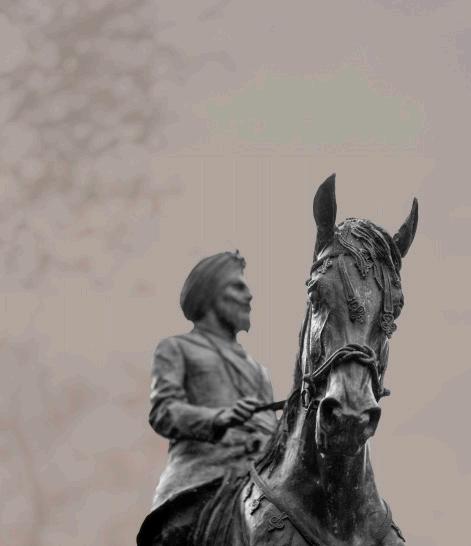

August-September

Featured Inside
Run Breckland
YMCA
Thetford Grammar School
New Saffron
Elite Hair and Beauty
Studio 5
Bob Blogg
Keystone
The Brecks
A Viking Invasion and much more


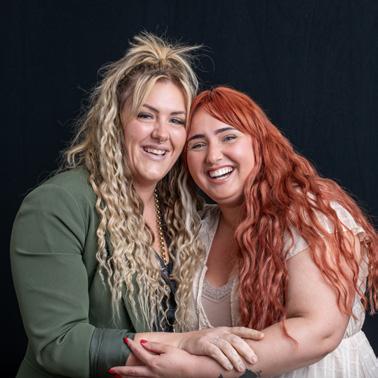





























August-September

Featured Inside
Run Breckland
YMCA
Thetford Grammar School
New Saffron
Elite Hair and Beauty
Studio 5
Bob Blogg
Keystone
The Brecks
A Viking Invasion and much more





























by Martin Angus (Editor)
When we first started, there was an underlying fear that we might run out of things to write about in this lovely town of Thetford. Some even commented that surely after issue 2 there will be nothing left to said about what is going on?
How wrong could we have been!
The mail box is getting busier and busier, and more and more people are coming forward with ideas, photographs and stories. Not only have we been able to look backwards at what people have done, and things that have happened, but we are able to look forward at the dreams, plans and aspirations of what people are planning or dreaming of doing here in Thetford.
The Guildhall Writers group have excelled themselves this edition, not only have they dug deep into the great people of Thetford’s heart, with some amazing stories and experiences, but they have professionally navigated the delicate art of time and people management with perseverance, working around people’s holidays.
We have also had a few extra writers join us this edition, some writing for the first time, some writing for fun, and one writing with the desire to return to professional writing after taking a break in her writing career.
Personally, from a photography perspective, this issue I had the daunting privilege of photographing Thetford’s most renowned photographer, Graeme Jacob.
I do reply to anyone offering feedback to the magazine, which is passed on to our amazing writers, and I can honestly say that the positivity we receive from emails, social media, comments and word of mouth, lets us know we are creating something the townsfolk of Thetford enjoy reading and are proud of
Please enjoy the magazine, and if you have any ideas for editorial, want to comment on what we are doing, or would like to see your business included in our lovely magazine, then please get in touch.
We can’t do this without your support!
©Reflections of Thetford is published by The Bubbly Hub. All rights reserved. 2024 Whilst every care is taken, the publisher accepts no responsibility for loss or damage resulting from the contents of this publication, as well as being unable to guarantee the accuracy of contributions supplied as editorial, images or advertisements. No part of this publication may be reproduced, copied or transmitted in any form or by any means or stored in any information storage or retrieval system without the publishers written permission.




There is Always a Table for you - Shipon Miah The man behind the Camera - Graeme Jacob A warm welcome at YMCA - Camille Harrison The Drona Diaries - Bob Blogg Vikings, Eels and Pine Lines - The Brecks A Sack of Flour - Thetford Co-operative Society
Personal Journey, so far - Hannah and Keri
Gardener - Amanda Faye
Collaboration - Motorbike Themed Photo-shoot
of our Favourite Walks - Thetford River Walk
the Ground Up - Ricky ‘Keystone’ Aylott

There will always be a table for you in New Saffron
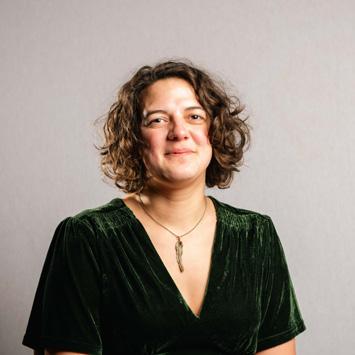
Written by Jude Clay
The chef stands in the kitchen ringed with bowls of spices. He dips into them here and there, the recipe for each dish in his mind, the order in which the spices should be added instinctive, the quantities by eye.
Flames lick around the pan, high and fast. Thin, pale strips of ginger sizzle in golden vegetable ghee. He tosses in garlic, sliced peppers and onion, green chillis and the layers of fragrance in the kitchen thicken.
“When my father taught me to cook, the first lesson was to grind and mix my own spices. We don’t buy big pots of pre-mixed curry powder, or garam masala, we make our own.”
Born in Bangladesh in 1993, raised in Bedford from the age of 3, Shipon is the eldest of 8 children and carries the enormous sense of responsibility so

common in an eldest child. He was expected to set a good example to his younger siblings, and also often acted as translator for his parents, making sure their voices were heard in the country in which they raised their family. It is this base that taught him the importance of being part of a network and, from here, he learned that success for one person raises the success levels of all those around them.
He saw this in the role of his father, an extremely popular man who always had time to help others, and an accomplished chef. Shipon used to brag to teachers, “my Dad’s a chef you know?” He dreamed that one day, his father would no longer have to cook in other people’s restaurants, but they would have their own restaurant and run it together.
With total focus on the dish, he drizzles a deep red masala into the fragrant pan, then a ladle of tomato
and garlic sauce.
When Shipon left school, his father taught him what a chef wants in a waiter: someone who knows the dishes and the ingredients, who can have conversations with the guests and with the chef too. He sent him to work in his uncle’s restaurant in Thetford, a place called Nimmi’s. Shipon found it hard; being in a new town and working in someone else’s restaurant when all he could dream of was running his own. After three months, he began talking to the owners of another restaurant in town, a run-down place called The Saffron. He found they were looking to move out whilst he was looking to move in.
He called his father and convinced him it was a good idea: they were going to run a restaurant together. Shipon would be the best waiter to match his father as the best chef.
He began to plan out his menus, dreaming of how to put food to paper. He began to think of new names: imagined Shipon’s Place written over the door. But his father had fallen in love with the name Saffron. “It’s a beautiful name, you can’t change it.”
After many days of discussion, they agreed, the restaurant would become The New Saffron to reflect the new life of the restaurant and its owners.
Shipon adds long strips of chicken, cooked in the tandoor, to his pan. “We marinate chicken fresh each night, before cooking it in the tandoor. We keep it in long strips to avoid cutting it too often, that way, it stays tender and juicy for the final dish.”
He adds the chicken to the pan, only cutting it when he needs to with his spoon.
The dreams of a twenty-year old, in reality, are hard
work. Saffron was more run-down and needed more work than Shipon had imagined. The kitchen needed fully stripping out and that alone was more than his budget. His Father knew how to see these problems through. This was the man who had taught Shipon the importance of community. The whole of Shipon’s life people had come to his Father for help, support and advice and, now, that network could return the favour.
Just as work began however, they had a visit from Food Standards. Unbeknownst to them, the restaurant had already been given notice of closure for food safety. Hearing the restaurant was under new management and, seeing the work they were starting, the Food Standards Inspector gave them four months before their next assessment. Four months to turn the place around. Shipon was keen to prove himself, he told her they’d do it in three.
This is where Shipon started to find a new community in his adopted town. The people working on his restaurant, didn’t just install new things and refurbish the old, but educated him as to what Food Standards would be looking for. Combined with his Father’s years of experience, they began to formulate a system of working that would keep everything clean and organised, be easy to maintain, and minimise the risk of cross-contamination to allow for different dietary needs.
When the Inspector returned, she gave the restaurant a five-star rating – a certificate they still enjoy today, 11 years later.
“The gravy is where the love is. Deep in flavour, but not so thick it blocks out the other ingredients.” The pan bubbles and steams and Shipon looks proudly round the kitchen.
The next challenge was winning over the town itself.
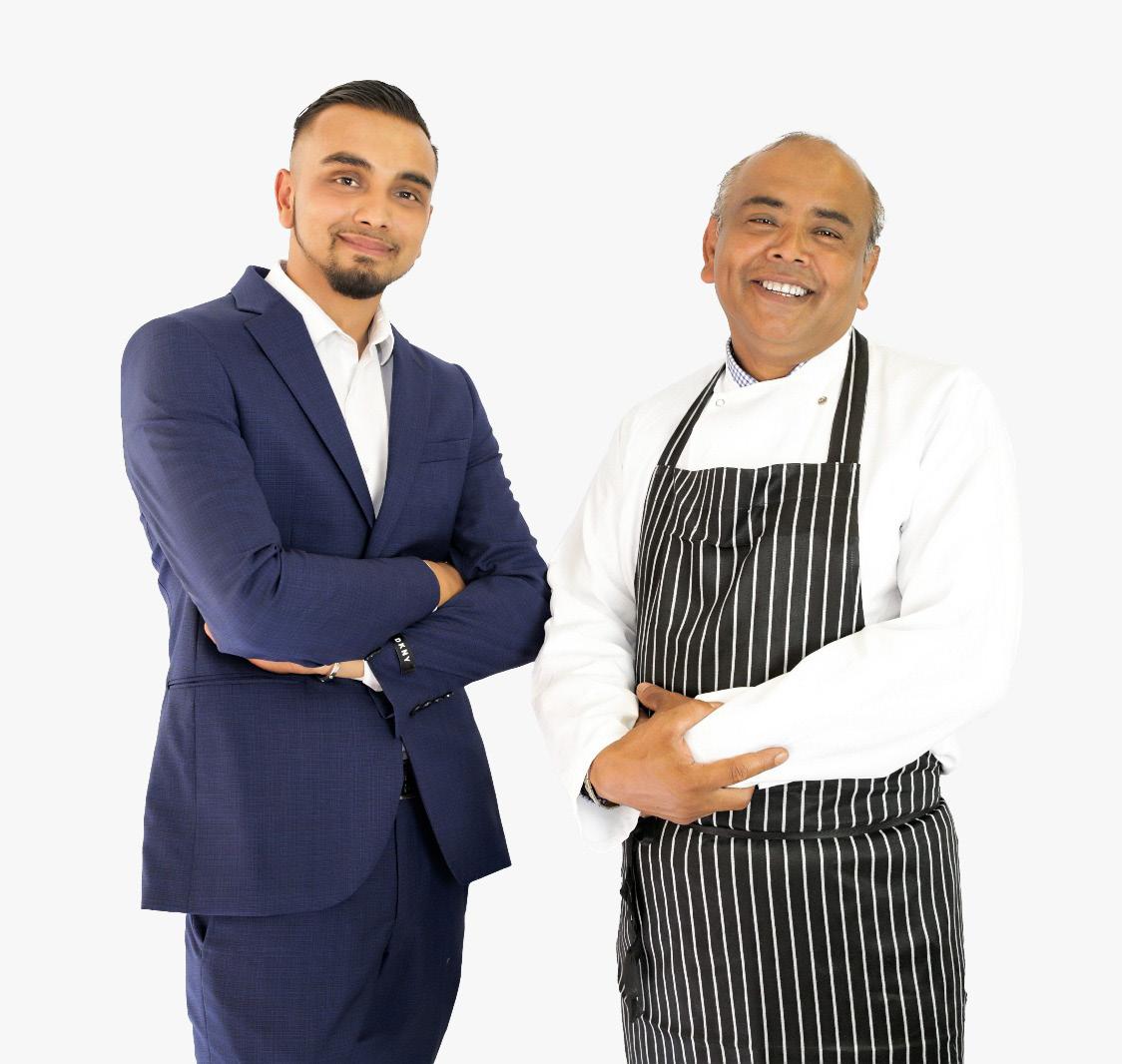
“Saffron. It’s a beautiful name, you can’t change it.”
As they built their menu, Shipon was worried at the array of unusual ingredients his Father suggested and the language he used, preferring his Bengali words to the English translations. What if Thetford didn’t know that “murgh” meant chicken and “gosht” was slow-cooked meat?
His Father told him proudly, “let’s be Bangladeshi in an English town.”
They formulated the menu to start a conversation with the customer. Shipon’s Father realised his son’s skills with words. He knew that anyone in conversation with Shipon would be won over by his passion and engagement.
Still today, Shipon would rather have fewer guests with whom he has a real relationship, than hundreds of customers who never return.
At this point in his story, Shipon had learned how to be a great waiter, now it was his turn to learn how to be a great chef. Growing up with both his parents’ cooking, he knew how good food should smell and taste and make you feel, but he didn’t know how to make it. Now, his father tutored him. He taught him how to grind and mix spices, how to make the gravy base for curry sauces, and how to select the best ingredients. After having struggled with focus in school, Shipon became completely absorbed in learning what his father had to teach him. He not only learned how to cook as well as his father did, he learned from their new suppliers, what the best cuts of meat were, what was standard for curry houses and how to improve on that standard.
And the learning was only just in time. Whilst The New Saffron was still finding its feet, Shipon’s Father suffered a heart attack and became seriously ill. Needing surgery, he found himself unable to work for

months. Shipon now had to be the best waiter and the best chef and hoped desperately, that business would start to pick up soon.
“Our garam masala goes in right at the end,” Shipon says, stirring in a dab of the spice mix like an alchemist with the secret to making gold.
Still young and keen to prove himself, he hired a painter to come and fully redecorate the place in his Father’s absence. The painter became yet another mentor for Shipon as he not only repainted but redesigned the whole colour-scheme of the restaurant.
On the day Shipon’s father returned to the restaurant, not only was it beautiful, it was also full of customers. And the next day was the same. At this moment, Shipon believed he could make this work.
His father had always told him, “When we are a success, you should buy a Mercedes.”
In 2016, Shipon pulled up outside the restaurant in his brand-new Mercedes.
In the flush of new success, he decided to return home to Bedford and apply what he had learned there and open another restaurant, leaving The New Saffron to tick over in Thetford without him.
He sat in his new restaurant in Bedford, seventy-five miles from his adopted home, and it didn’t feel right. He realised the relationship he had built with Thetford and The New Saffron. In this restaurant, in this town, he had grown from a twenty-year-old full of dreams, to a thirty-year-old restaurateur.
In Bedford, he was Shipon, part of a big family, whose Father was a chef.
In Thetford, he was Shipon.
He returned to Thetford.
But his biggest test was yet to come. In 2022, his business partner and most inspiring and supportive role model, his Father, passed away.
The repercussions were immense. Shipon hadn’t opened a restaurant to make money, he’d opened it to support his family, to bring joy to the people that ate there and to build on the legacy his Father was creating. Every day he spent feeding the people of Thetford with his Father, he was living the life he had dreamed. Now, that life was gone. From now on, he had to trust he had learned enough to do it on his own.
“We’ll serve this how I’d have it – with a bowl of pilau rice, drizzled with saffron oil, and a super crispy garlic naan.”
Opening his own restaurant, in a town far from home, you would expect Shipon to be a confident and ambitious young man. He is.
He doesn’t just want to cook as well as his Father, but better than him. He knows that’s what his Father wanted.
However, he is also profoundly conscious of everyone who has helped him get this far. He lists them happily, his role models and mentors. He remembers the names of the teachers who listened to him and encouraged him even as he was naughty. He remembers the individuals who gave him advice and quality service refurbishing the restaurant. He works now with one of his brothers and nephews and credits an uncle for helping in the early days. He


knows the people in Thetford who are always willing to share new opportunities and give advice and he remembers the names (and orders) of his regular customers.
He has learned the importance of legacy – it is all of value you really leave behind. He wants to build on his Father’s legacy and create his own too.
He loves to cook in the restaurant, but his true passion is business. He talks of creating places for young people to learn about running their own business, to show them all the possibilities there are for them to make a living from their passions. He wants to harness the power of mentors and role models and offer it out to anyone who needs it. He sees the potential in this town.
When Shipon heard his uncle was looking to sell Nimmi’s, he saw a chance to invest in that town. The restaurant he was in had 24 seats, Nimmi’s had 60, it was a gamble to buy it, a gamble on the support of his adopted town. But Shipon sees it as a promise to his community: he is thinking of his future here. He is not going anywhere anytime soon.
The dish is laid out on the table. The fragrant rice, the buttery, crispy garlic naan with a hint of smoke from the tandoor. And, beside it, the dish cooked by the businessman, the chef, the waiter, the boy taught by his Father: a signature jalfrezi, with its rich and tangy sauce, the warmth from the ginger and garlic, fresh vegetables and succulent chicken. This is everything The New Saffron is, and everything restaurateur, Shipon Miah comes from.
There will always be a table for you in the new New Saffron, a conversation to be had, a Bangladeshi treat in this English town.




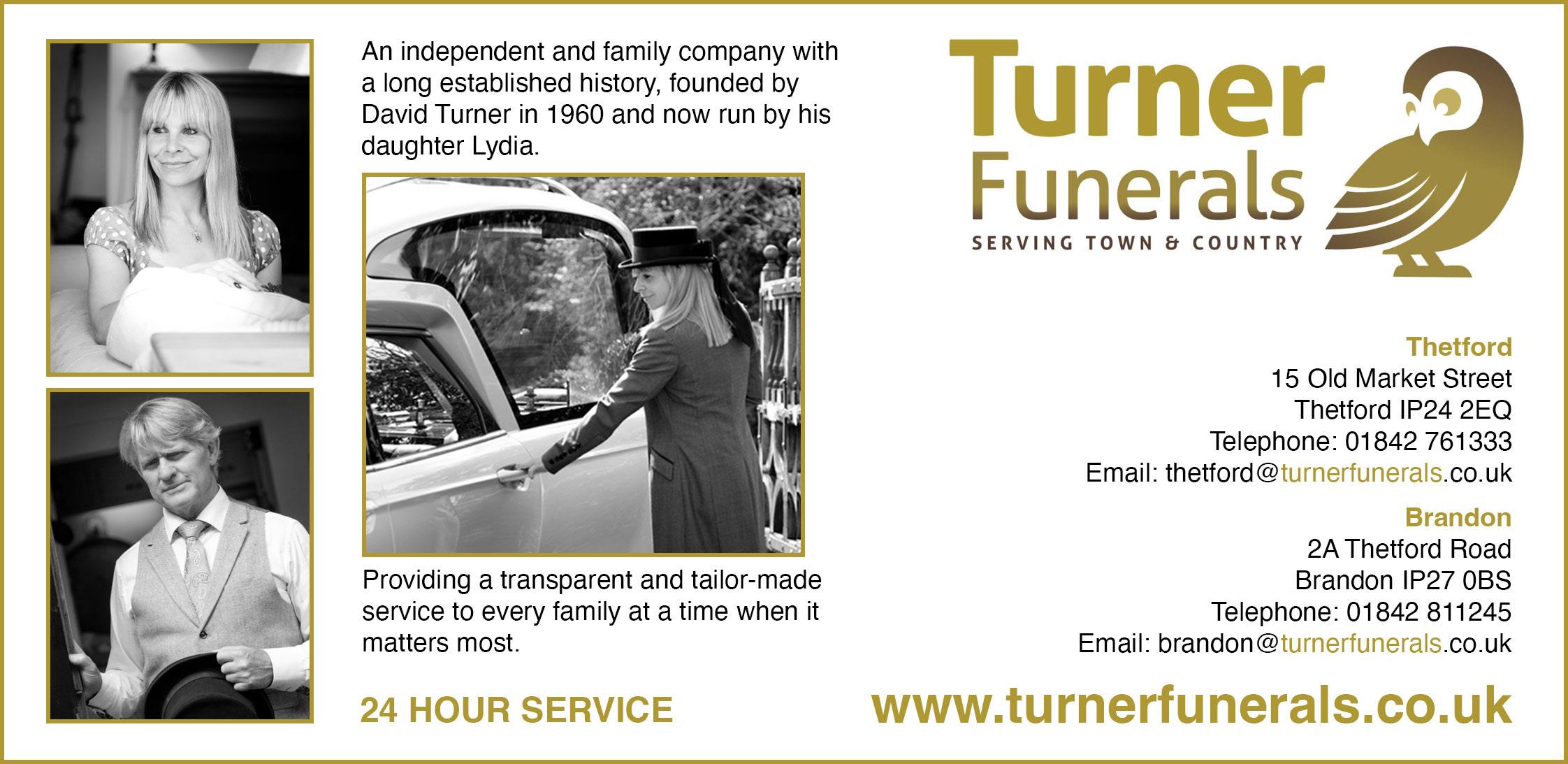

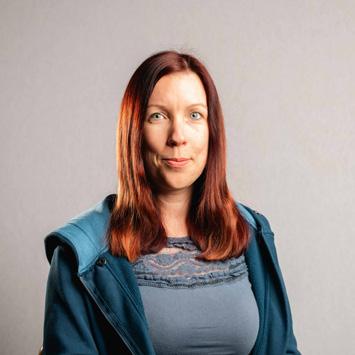
Written by Liz Gibbons
Studio Five is Thetford’s longest running business, boasting 72 years on the high street. I had the great pleasure of meeting business owner and life-long photographer, Graeme Jacob. Recognised for his 50 years of service, Graeme received an award from the British Institute of Professional Photography.
How it all began - Graeme’s older brother, Philip, was a photographer for the RAF. When he left in 1947, he decided to set up a local photography business. Graeme proudly tells me about his brother. “Photography was his ambition, his dedication you could say.” Still at school at the time, Graeme worked a local paper round but was inspired by his brother and assisted him however he could. With no photography courses offered at the time and later, when they did become available, they were very expensive. Graeme

instead, learnt on the job alongside his brother, finding his own style.
“I’d go and photograph everything and anything, whatever anybody wanted done. Come to that, we still do that now.”
Opportunities were few and far between in the late 1940s and in its inception, the studio was run from the Jacob brothers’ family home. As the business took off and the house became too full of all the equipment, the two brothers decided to look for a rentable space. They ended up sharing the club room in the Five Bells in Brandon. This is where the Five originates from in the name Studio Five.
As the business became more established, Graeme and his brother felt it was time to find a place for a permanent studio. They looked around Brandon but the high street was full. The vibrant

town had nothing available, leaving them no other option than to look further afield. Thetford is grateful they did because in 1952 Studio Five moved to 12 Bridge Street in the town centre and has been there ever since.
Graeme remembers the first camera they used was a Leica and how much he loved using it. Once Graeme became more confident, his brother started to send him out on jobs on his own. In the beginning Graeme recalls relying on his bike getting him to the different jobs and the challenges this entailed.
With his career in photography set, Graeme went on into the world of Press Photography for Fleet Street. This meant using a Speed Graphic camera, “this was the highly desired camera that everyone wanted.” I must have looked blankly at him, so he went on to explain, “If you ever watch the American films with a photographer in, they were the cameras with the big flash bulbs.”
During the period of using flash bulbs, Graeme talked about the many challenges that went with them. “They were quite large, expensive and in short supply. So, if I had a job that needed a flash, I had to be very economical. You might order 20 bulbs but you might only get 10.” Through this, Graeme learnt through his experience and initiative when to use them. He remembers how encumbering they were, “the pack hung heavily on my shoulder and dragged on the ground.”
Later in his career, Graeme was able to move on from flash bulbs to electronic flash guns. From there the technology improved again, the camera flashes got smaller and smaller making their use a lot easier.


Photography days. “During the early days, five by four glass plates were used and then sheet film came in. Once I had taken the shots I would either go on the train or drive it to Fleet Street. If there was a big story that broke in the area, the newspaper’s darkroom boys would go to the closest telephone exchange. I would shoot the shot, give them the film, which hopefully they would use. It would be a large format negative processing which would be on glass plates and could be printed wet. They would then use a processor where it would be fixed and washed. They would take it out of the water, wipe it down and put it in on enlarger print. It would then be sent and wired to Fleet Street. As technology progressed, they would bring all the equipment on site and scan it. Nowadays of course, everything can be sent immediately.”
Graeme goes on to tell me that he has had more than his fair share of celebrity photography opportunities in his time and regales me with a few example stories. Some of them involve the local filming of Dad’s Army and ‘Allo ‘Allo (filmed at Lynford Hall.) Graeme provided photos used in the Dad’s Army television series, “When they wanted stills of particular things that they couldn’t get in with a camera or if it was going to take too long to shoot.” Continuing, Graeme goes on to say that he would also take photographs during filming. The shots would then be used for press releases etc.
We had talked a lot about how technology moves on so quickly within the photography industry. Graeme remembers how film development started to decrease in demand as people got into using video cameras instead. From there, digital came in, so everything changed again. Taking us back to modern day, Graeme surprises me by saying, “Recently, there’s been a film revival and we are
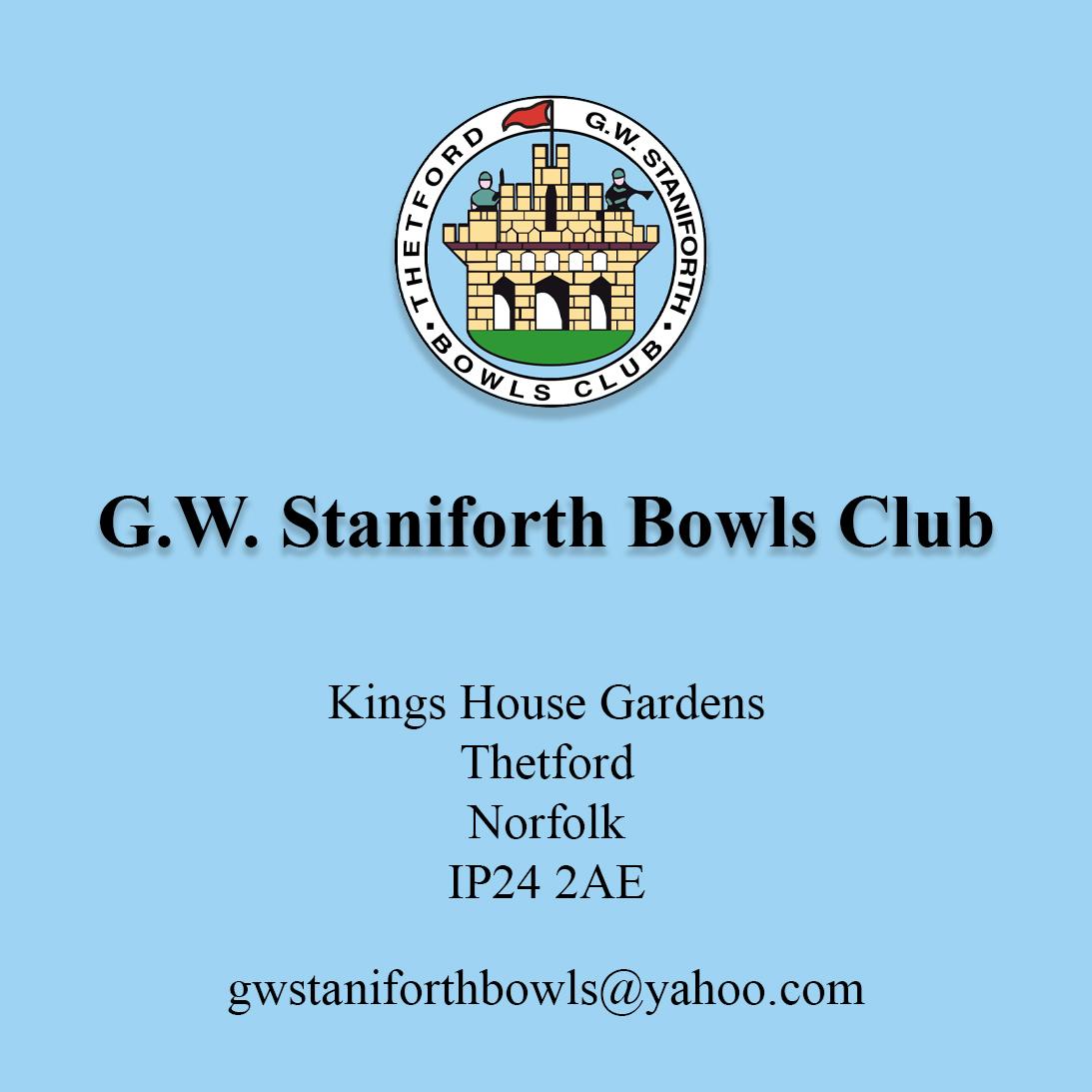
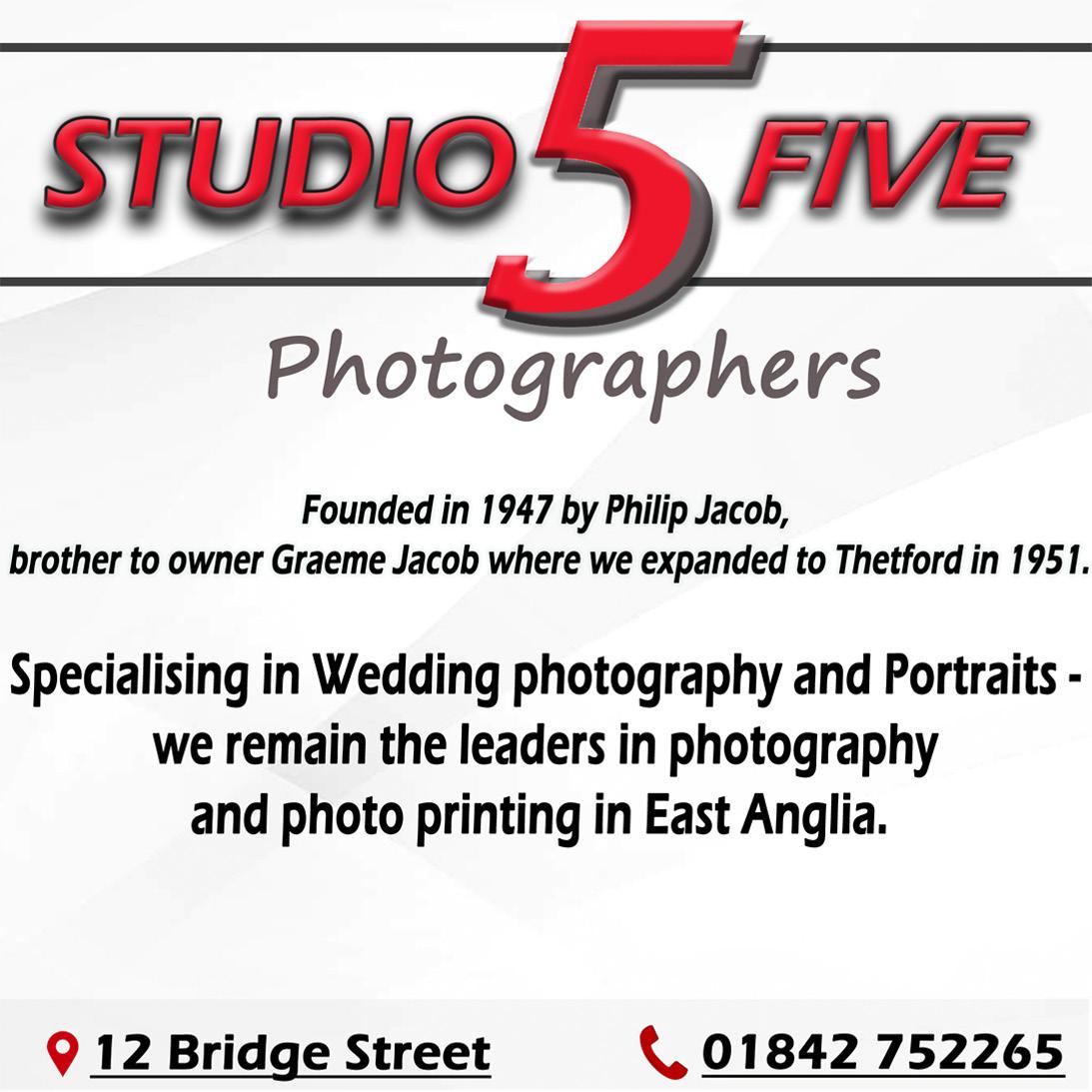

now back to processing as much film as we did in the 1960s.”
Although Studio Five offers a wide range of services including passport photos, business photography, family portraits, headshots and digital photo restoration, unsurprisingly, wedding photography has remained their biggest business. When asked about his photographic style, Graeme replies that he is a traditionalist. “Of course, we do all the photographs that are requested for the big day but I try and remain discreet.” He continues with a smile, “I don’t go clambering over people to get pictures.”
Over the years technology has progressed at great speed and Graeme has always moved with the times. I asked him how he manages to do this. He laughs and says, “I surround myself with young people.” He continues, telling me about the work placements offered at the studio and how some have gone on to become staff members.
As we come to the end of our time together, I ask if Graeme follows the works of any particular professional photographers for inspiration and new ideas. “I look at everybody’s work and I think: Do I love that? Could I do that? Could I make that work?” From Graeme’s answer, I think perhaps you never switch off from being a photographer and I think you see the world in a different way, see things from a different angle.
Finally, I ask Graeme if there is anything he would like to add. “I would like to thank my customers. They are incredibly loyal and keep coming back and we’re always pleased to see them. I encourage all my staff to be friendly and I think that’s so important.”
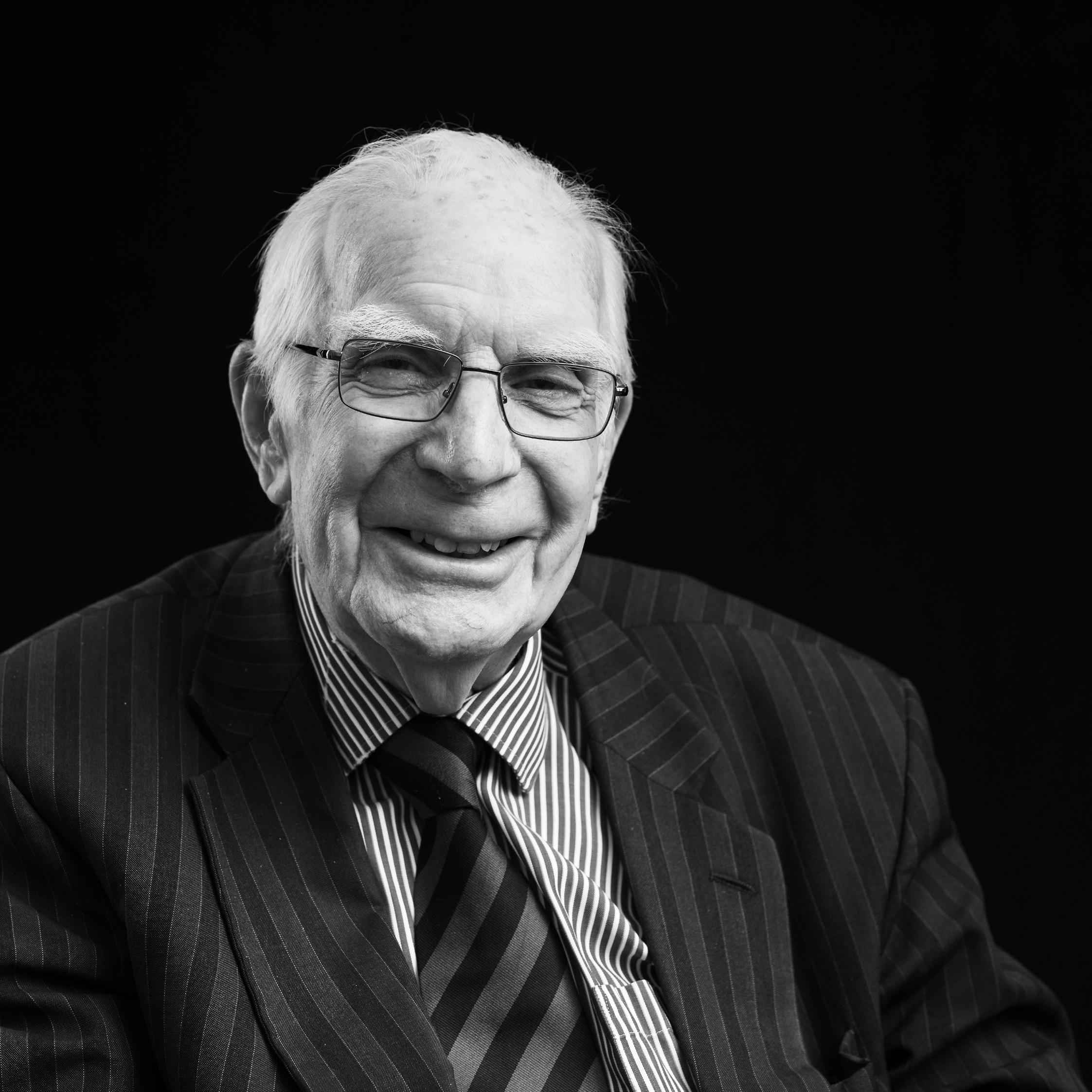

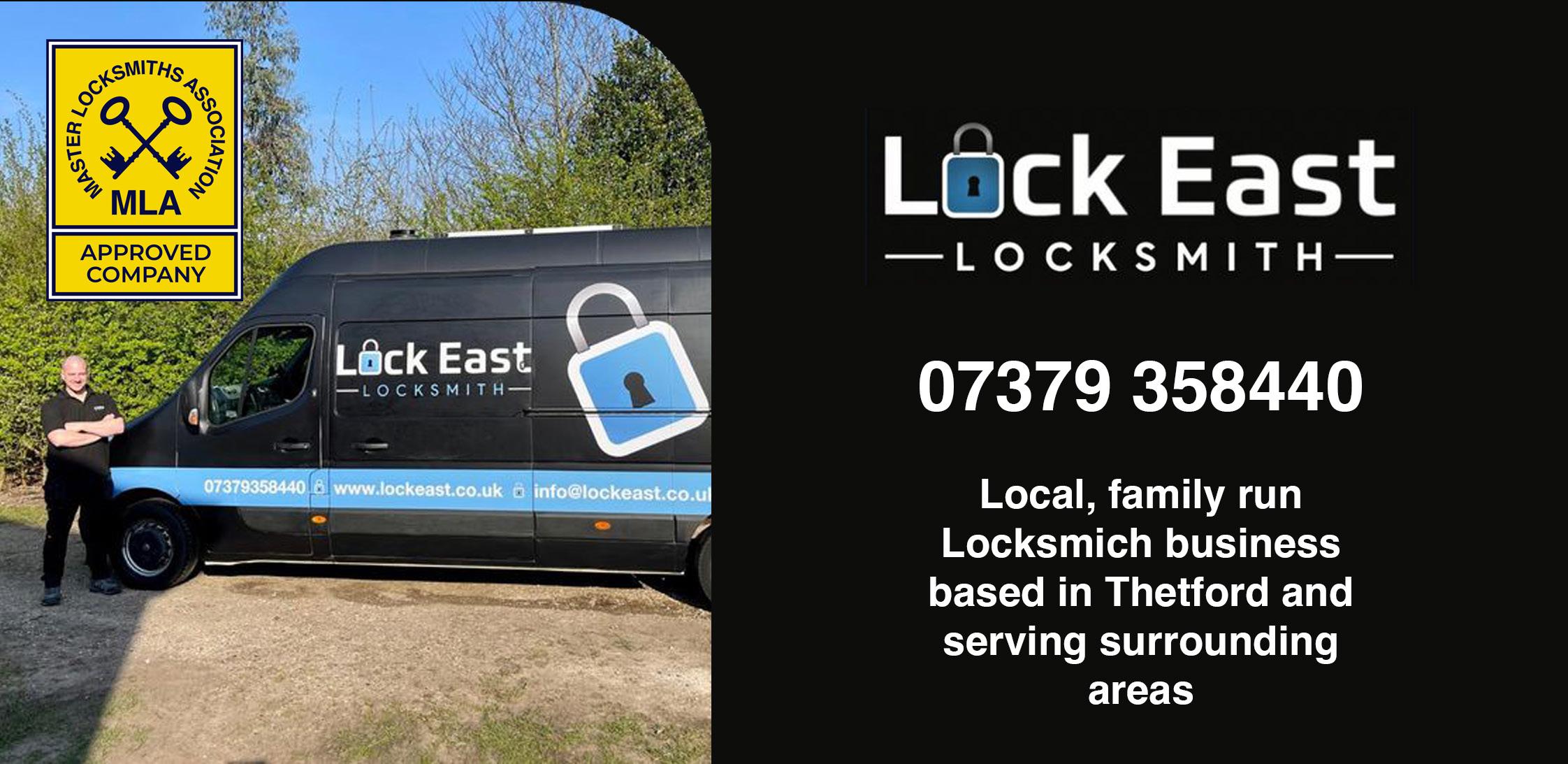





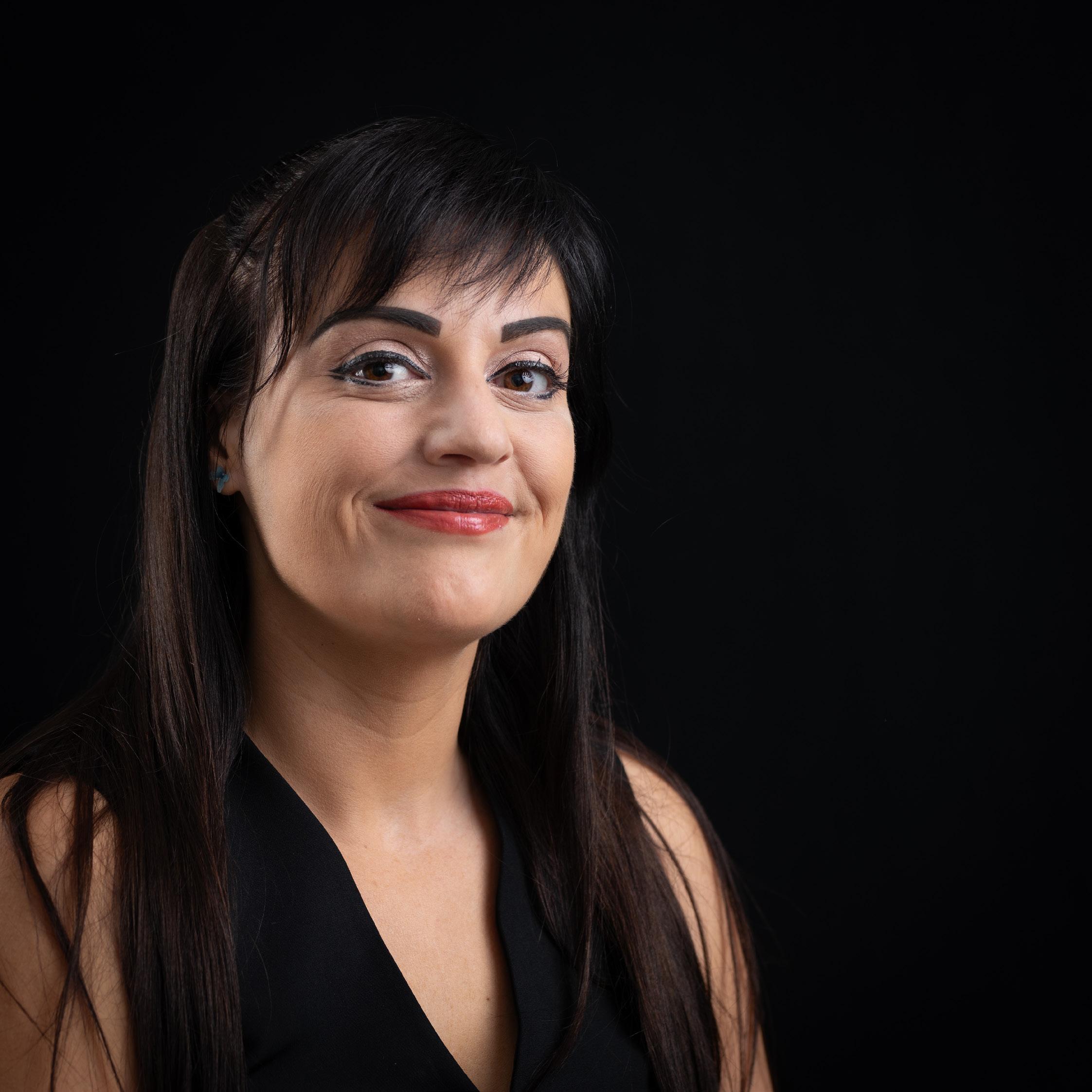
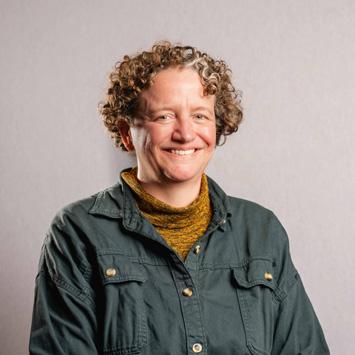
Written by Joanne Lock
Wandering around Thetford mid morning on a Wednesday in July it felt really quiet around the shops, until I reached the end of King Street.
Standing on the corner opposite the Bell Inn is a stylishly grey shop front with thoughtful and well put together window displays. Go through the door and be drawn into a lively atmosphere with a positive vibe of music and a very warm welcome from smiling, enthusiastic and attentive staff and it’s easy to understand why even on a quiet day in town this shop is full of people browsing and a steady stream of customers at the till.
This Thetford shop is one of over a hundred YMCA charity shops, helping to raise the vital funds which support over 500,000 young people each year and realises the charity’s mission to: enable people to develop their full potential in mind, body and spirit. Inspired by and faithful to our Christian values, we create supportive, inclusive and energising communities, where young people can truly belong, contribute and thrive.

Manager Camille Harrison is one of the most cheerful, enthusiastic and engaging people you could ever meet, she has an energy that is infectious. Volunteers love spending time in the shop, enjoy their work and in turn create an enjoyable experience for customers regular and new.
As a young person Camille experienced and overcame her own struggles and is passionate about helping others. Her empathetic and friendly nature helps volunteers to feel at ease and she focuses on playing to a person’s strengths to enable them to build confidence and develop skills. Volunteer engagement is everything, the whole team mucks in with what needs to be done and no one is stuck doing the same task day in day out, everyone takes turns in doing each job within the shop. Fun is encouraged and the shop even has its own mascot, a big toy sloth, a donation that was adopted by the volunteers and sits on a table in the sorting area to encourage people to smile while they are working.
Volunteers of many years Barry and Viv enjoy their work


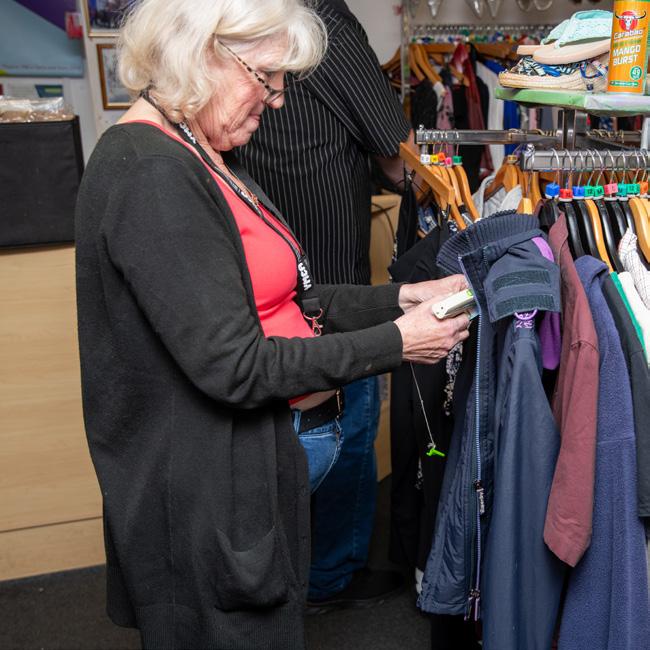

At the YMCA I have fun and a laugh, I find people I work with easy to get on with. I enjoy steaming the clothes, it gives me a new skill and helps with my stress.”
Paul
“I have been a volunteer for about 2 years. I like working for the YMCA, I enjoy meeting new customers and there is always something to do in the shop. Workinghere has helped me with my anxiety and depression after losing my mum 4 years ago.”
Barry
“I have been volunteering at YMCA for four years, since being at YMCA I am not so shy, I have learnt new jobs, and enjoy meeting and chatting to customers. YMCA is a friendly place to volunteer.”
Vivien
“I joined the YMCA because I was struggling with my mental health, to get out more, and to make new friends. I have learned to do many jobs in the shop.
Chelsea (on the right)
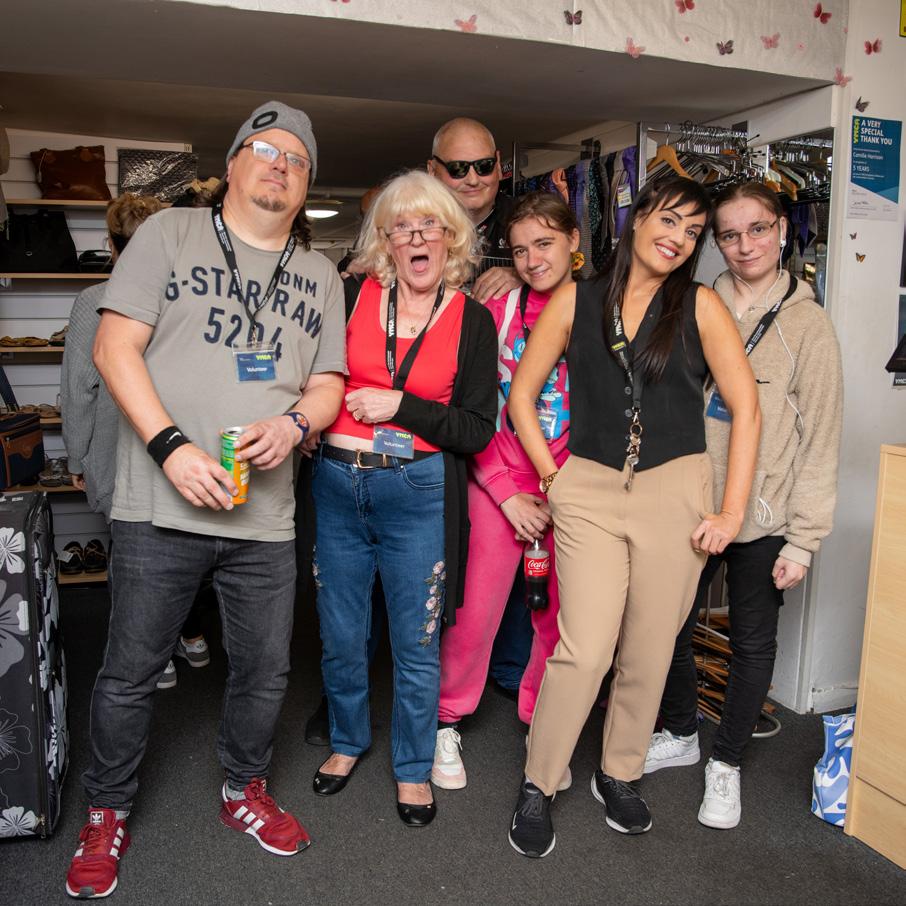


“Always here to help, I feel like I have made new friends and feel I can talk to Camille about anything, I really enjoy coming here.”
Vicktoria
“I have been working at the YMCA for about 4 and a half years, I enjoy the variety of jobs in the shop. I love working here with nice people and meeting new customers, it has helped me with my confidence. We are all one little family.”
Sam


so much, they choose to spend their time working in the shop most days. The shop was a place of company and comfort when Barry’s mum died and gave him a sense of purpose. Viv, a former work colleague of Camille’s, the pair were reunited when Viv started volunteering at the shop. She enjoys the atmosphere and having a laugh, saying that she used to be shy but is more cheeky, chatty, and confident since working there.
Camille has a perfect blend of experience drawing on her retail and customer service role at New Look, working with the team to create a shopping space that flows, where merchandise is displayed with flair and has a great atmosphere. Stock is regularly rotated so there is always something new to be found at a fair price and donations are always welcome on any day during opening times. Motivating and managing the team in an understanding and empathetic way comes from her own struggles and also from working in a nursing home caring for people with dementia and providing end of life care. Camille appreciates the many challenges people face and how hard things can be both mentally and emotionally.
Success has followed happiness. A young lad who was living in the woods came into the shop seeking help. A hostel place was found, he volunteered at the shop and built up skills which led to employment and this was recognised at national level, he won an award and attended a ceremony in London to receive it. Assistant Manager Kay Evers also won an award and the shop is No. 1 in the regional area for Gift Aid.
Sometimes the work of a charity shop can feel distant from the work of the charity, but charity does start at home in the shop. Volunteers have gained in confidence such as Victoria who has learning difficulties and former volunteer Chelsea whose mental health left her struggling to attend college and about to complete her studies, still pops into the shop for a chat.
From time to time people who are struggling have come into the shop, bedding and utensils have been found for the homeless and / or the staff have signposted others to the help that they need.
Camille is very supportive of and open to any volunteers who may wish to experience the work carried out by other parts of the organisation such as taking part in the sleep out or helping out at the Hub or hostels in Norwich.
Everyone can support the YMCA by shopping, donating or volunteering at the shop.
It well and truly is a destination shop and I’ve struggled to find the words to convey the atmosphere and the experience, so it’s worth taking the extra steps to the quieter end of the street where a warm welcome is guaranteed.
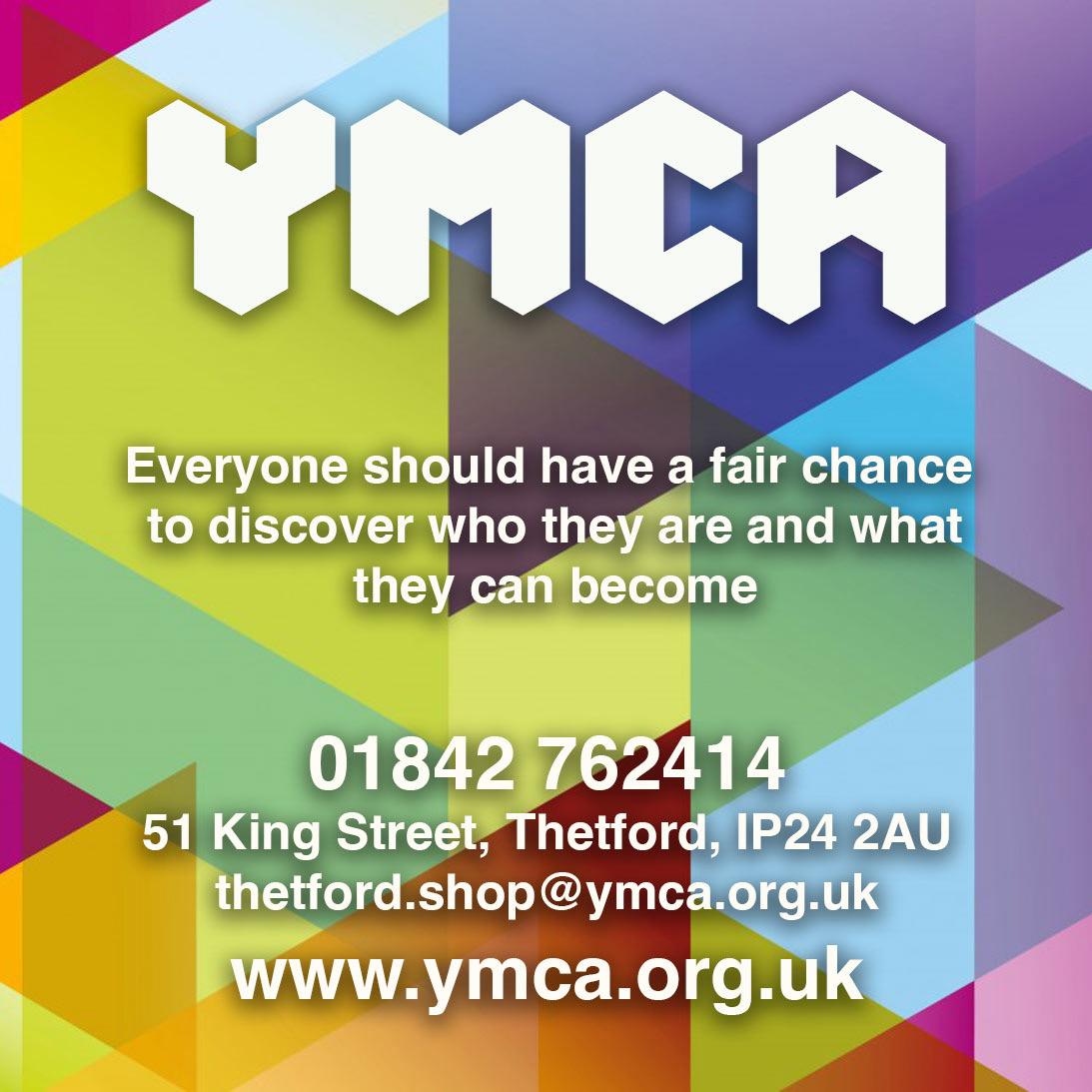


In the world of flooring installation, there are projects that stand out as true testaments to skill, precision, and dedication. One such endeavor involved fitting herringbone Luxury Vinyl Tile (LVT) at an exceptionally high standard after an extensive amount of preparation. The task?
Transforming a floor that had previously been a maze of different levels and channels, necessitated by new pipe work and walls being demolished.
Before laying a single tile, the groundwork was laid— quite literally. The team embarked on a journey of preparation, smoothing out the surface, filling ingaps, and leveling out discrepancies. Each imperfection was addressed, ensuring a flawless canvas for the intricate herringbone pattern that would soon grace the space.
The complexity of the project lay not only in achieving a smooth surface but also in navigating the intricacies of the herringbone design. Precision was paramount; each tile had to be carefully placed to ensure perfect alignment and symmetry. The herringbone pattern, with its interlocking angles, demanded unwavering attention to detail and a steady hand.
Despite the challenges posed by the uneven terrain of the existing floor, the team persevered, their dedication unwavering. Countless hours were spent measuring, cutting, and laying tiles with a precision
that bordered on artistry. Each tile was not just a piece of flooring but a testament to craftsmanship and expertise.
As the project neared completion, the transformation was nothing short of astounding. What was once a patchwork of uneven surfaces had been reborn as a seamless expanse of herringbone LVT, evidence of the team’s skill and dedication. The once disparate levels and channels were now seamlessly integrated, proof of meticulous preparation that preceded the installation.
The end result was not just a floor but a masterpiece—to the artistry and dedication of those who had brought it to life. It stood as a reminder that with patience, perseverance, and a commitment to excellence, even the most challenging of projects could be transformed into something truly extraordinary.
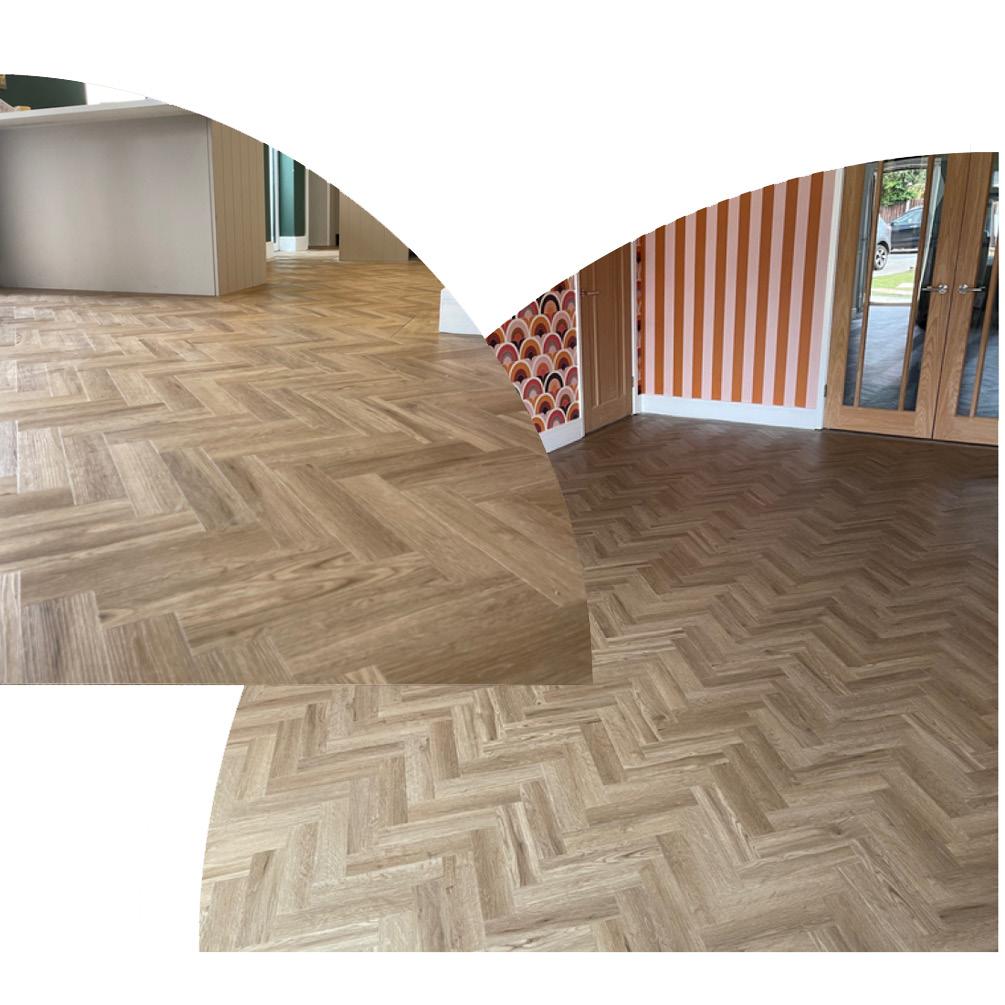


Drona Diaries, a family day out in Elveden and introducing the Bambi Cam.
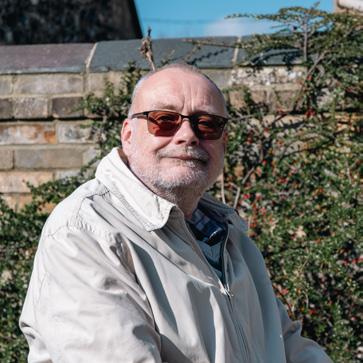
Written by Bob Blogg
Firstly: The Drone Diaries
Ihave got a kick-a** (excuse my French) drone now called Drona. She’s a DJI Mini 3 Pro with loads of features and comes in at a lightweight 249 grams.
I don’t exactly pilot her, she sort of follows me around like a worried mother hen – make that a concerned eagle. I have even got a pilot’s licence from civil aviation authority to prove my incompetence.
As you may know or may not know there is no street view from the Market Place to the statue of Captain Mainwaring by the river. So we decided to take Google Maps on and rectify that.
How hard can it be?
At silly o’clock one morning my plan was to fly Drona from the Market Place, down King Street to the river. Why silly o’clock? Because I am not allowed to fly my drone over people’s heads without their permission (I

learnt that when I took my pilot’s test – along with a lot of other nonsense!).
I did think of asking the council to close King Street for the day for filming and put up signs offering people the opportunity to appear as extras in the forthcoming blockbuster, but I didn’t want to be signing autographs all day and Drona didn’t want the ordeal of posing for endless selfies.
So 5:30 am it was. Well...
We made it as far as Greggs before running out of battery. Admittedly this was mostly due to the fact that I couldn’t remember which buttons to press and spent most of the time sitting on Tiglet, my little boot scooter, scratching my head and staring blankly at the controller.
So if at first you don’t succeed...
At silly o’clock another morning the new plan was for Drona to follow me from the Captain Mainwaring


statue by the river, up King Street to the Market Place.
Guess what! We made it as for as Greggs before running out of juice again.
This time Drona kept losing sight of me in the early morning mist and I had to come back and find her. At least it wasn’t my fault this time, although Drona said I had the wrong colour coat and trousers on so she couldn’t keep her eagle eye on me, therefore it was still my fault.
They weren’t even open yet so I couldn’t get a consolation bacon roll.
Anyway, third time lucky. I am going to get a black uniform and wear a black hat, and then we will try again. You can watch the whole sorry saga so far here:

Secondly: A family day out in Elveden.
I can’t believe it’s the school summer holidays already but it has got me thinking.
Where can you go on your mobility scooter or power chair, along with your sons, daughters and/or kids on their feet, bikes, trikes, skateboards and other perambulation devices, and the dog probably with even more energy, that is not in Thetford and that doesn’t require other transport like a bus, car or train?
(That is a horrendous sentence and the grammar is terrible but after spending about half an hour
continuously trying to reword it – I’ve given up!)
Anyway the answer is Elveden.
You can easily get there on an 8mph road scooter, 4mph pavement scooter or any equivalent power chair.
There is good pavement nearly all the way, there is very little traffic and you can have a pint and lunch when you get there. It’s only three miles from Sainsbury and a healthy few hour’s wander for everyone.
This is what you can expect to see on the journey. There are also a lot of other interesting paths to explore.
• Elveden Cemetery
• Maharaja Duleep Singh’s Grave (he was on the cover of the last issue)
• St Andrew’s and St Patrick’s Church
• Elveden Village Hall
• They have quiz nights
• Elveden Courtyard
• Farm shop
• Butchery
• Restaurant
• Dog Friendly (they even have Dog & Scone afternoon teas several times a week)
• Elveden Inn /Beer/Lunch
• Bed even (if you are staying for the quiz in the village hall)
• Dog Friendly (in the bar area and bedrooms)
• It really is an easy route and it gets you out of town in no time.



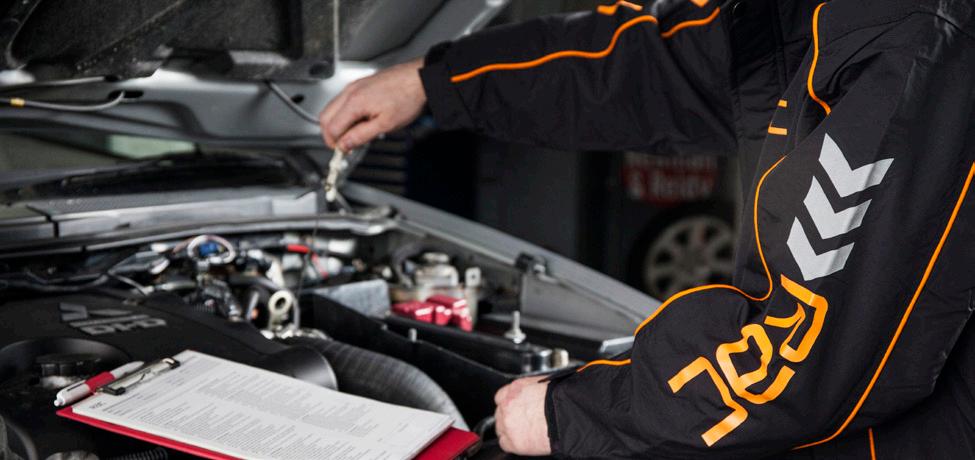

You can watch me on my road scooter, Tigga, waffling my way to Elveden here: Unit 5 Faraday Place, Thetford, Norfolk IP24 3RG 01842 337447


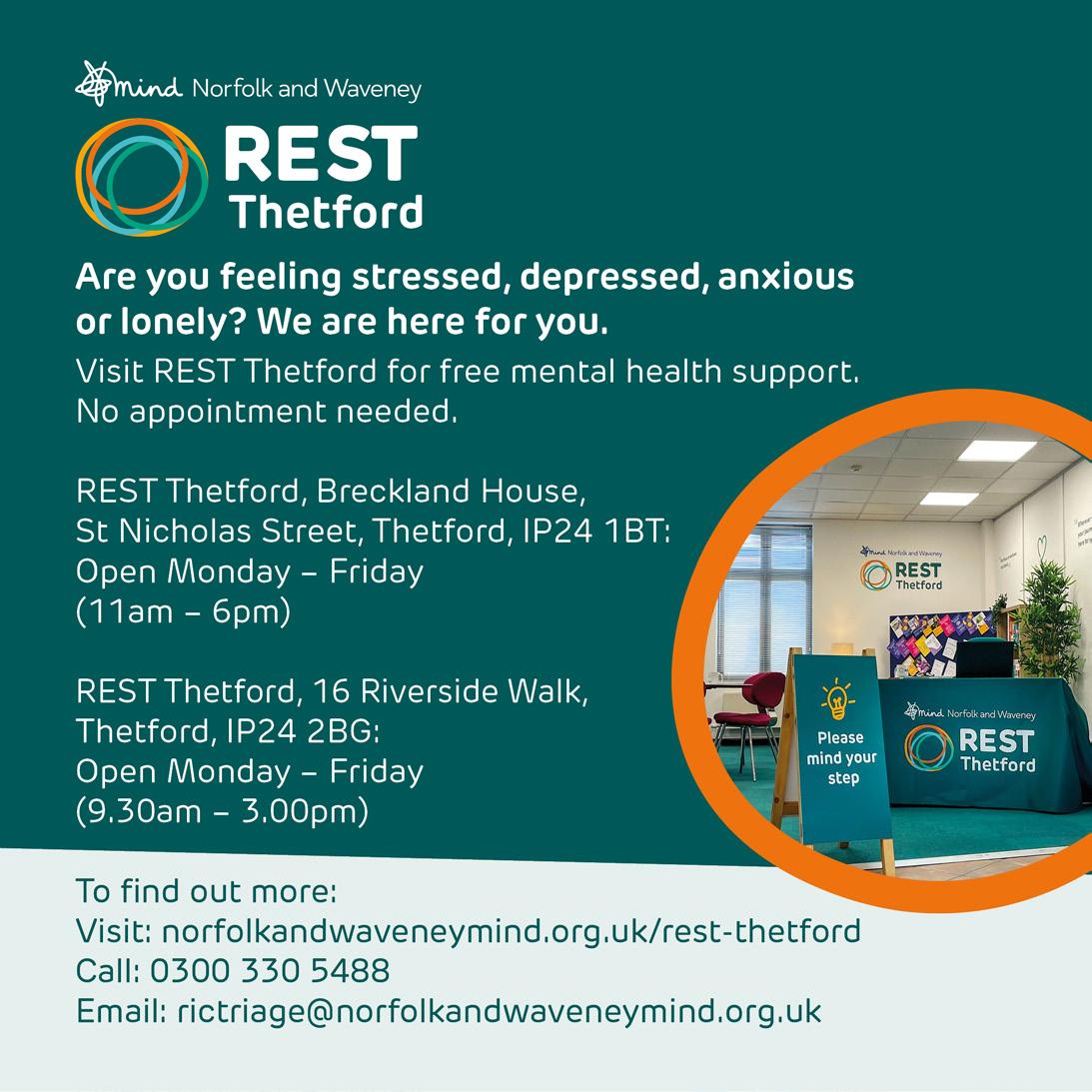


I’m currently working on the second episode of ‘Rolling along the River’ which follows the Little River Ouse through town and I realized there is a lot of wildlife that sneaks out at night whilst we normally are catching flies.
Aha! I thought I would get a trail camera. It’s a clever little thing that senses movement and then uses passive infrared to film at night.
I want to put together a montage of these night creatures (I don’t mean the clubbers!) to include in the video. So far I have got a pigeon, a cat, a rat and my first muntjac deer aka Bambi.
Send me your suggestions about where I can put it to capture the best action by the river at night.
Only polite suggestions, please.
I’m going to try and catch up with those ladies at enAble Thetford soon. I still haven’t raced the rickshaw on Tigga!
Happy scootering.

Follow the QR code to Bob’s amazingly informative YouTube Page



Thetford is in the heart of the Brecks, a landscape of sandy soils, wide heathland, fen edge, forest and rivers. The classic Breckland scene is a row of twisted, ivy-grown Scots pine at the edge of a field. It’s a landscape created by glaciers and shaped by agriculture, and unlike any other in the UK. This is reflected in the wildlife of the area. With validated records of over 12,845 species and over 35 designated sites of special scientific interest, it is recognised as one of the most important parts of the UK for biodiversity. Yet, because of the historic humaninfluence over the landscape and because it doesn’t fit the traditional views of beauty, it is not possible to protect this stronghold of biodiversity with National Landscape status.
However, for over 12 years, the National Lottery Heritage Fund have supported a Landscape Partnership to promote and protect the Brecks. Originally under a scheme called Breaking New Ground, the current scheme is the Brecks, Fen Edge and River Landscape Partnership (BFER) and, of course, it is based in Thetford.
For the past four and a half years, BFER has worked to create a strong network of organisations and projects across the Brecks to educate people about the area and promote and protect the landscape. Here is a whistlestop tour of just some of the work they have done.
The history of the Brecks is visible in the land, from the human influence of the iconic Scots pine lines planted by farmers to stop the sandy soil shifting, to the pingo pools carved by the ravages of the ice age. BFER has worked with the Breckland Society to research and write booklets on various areas of Breckland history.
The first focused on the Anglo-Saxon and Viking history of the Brecks and the work shows just how far back Thetford goes. In AD 865, Vikings landed in East Anglia in the form of a “Great Army” and the research under this project discovered that, because the rivers provided Thetford with such a strategic position,
“The
{Viking}
army stayed in the town during the winter of AD 869–70, following the murder of King Edmund.” – River Raiders by The Breckland Society
Moving into more recent history, BFER has also worked with Ancient House Museum to create a exhibitions and events around the use of the rivers in industry in the town. Thetford and its rivers have been the hub of many industries from tanning leather, making goods out of pulpware, brewing, canning, milling corn and coffee, making fertilizers and, of course, building steam traction engines.
The Charles Burrell Factory used the river to transport parts in its heyday, manufacturing world-leading traction engines from 1848 to its closure in 1928. The
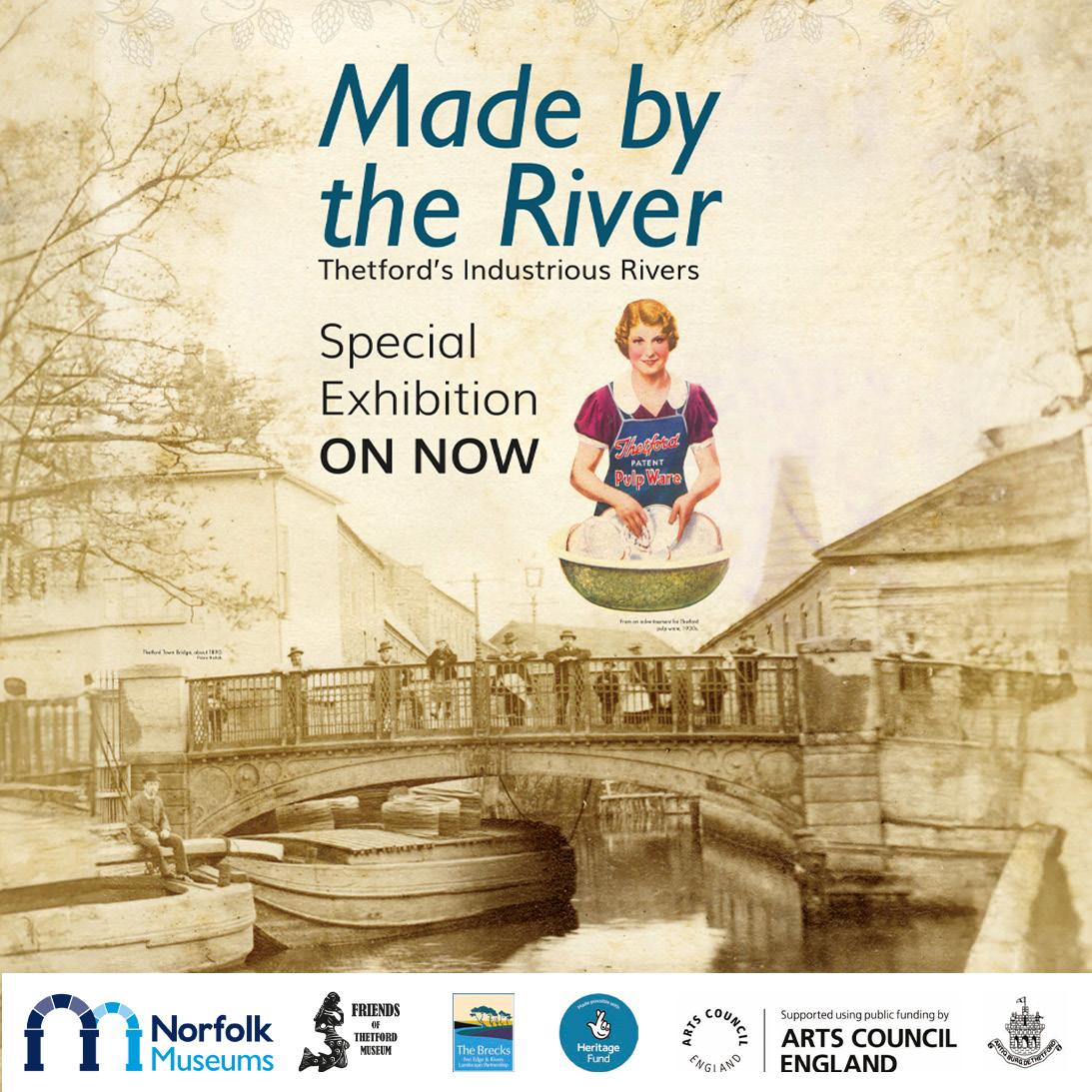
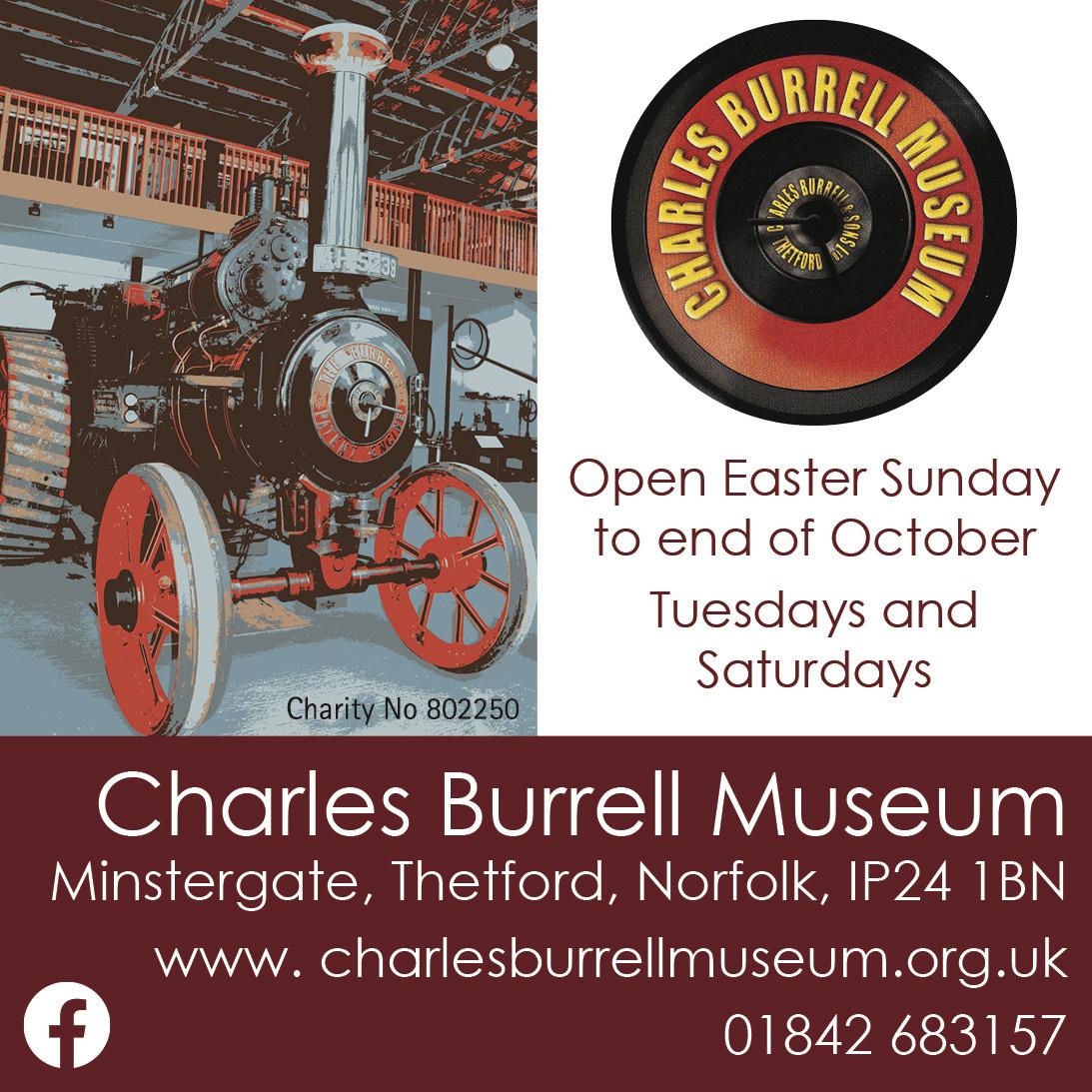
Museum in the factory today was gifted a miniature engine in 2023 which needed a new boiler before it could be used. The Museum received a grant from BFER and, after being dismantled by volunteers at the Museum, the miniature Man of Kent engine has been packed off to Pontefract for its new boiler. When it returns, it will be a perfectly portable version of history to take to events and shows.
“Our steam engines are living history. Built by the river in the Charles Burrell factory, the engines the Museum have today aren’t just exhibits, but functional, local machines.” –
Living history is something BFER tries to incorporate across its many projects, extending the Viking research into schools and events with Thetford theatre company Magic Floor Productions, funding (and even helping to build) an Iron Age roundhouse at West Stow AngloSaxon Village, and working with libraries, such as Thetford Library, to collect and make audio recordings of locals’ recollections of growing up beside the river.
“In 1988, a charity tug-of-war was held between The Anchor and The Bell Hotel in Thetford across the river so, whichever team lost, was pulled into the river!” – Tales from the River
The rivers that meet in the centre of Thetford may no longer be the lifeblood of industry in our town, but they are still a vibrant part of everyday lives. Many BFER projects have harnessed the inspiration given by the river to produce artistic works. The Guildhall Writers created a collection of river-inspired works which were performed on Butten Island in 2022, and writers across the Brecks created river-inspired poetry which was turned into folk music sung at West Stow Country Park in early 2024. BFER has also provided materials for Thetford Craft Group to create beautiful and intricate tapestries inspired by the river, one knitted and one
embroidered, both of which have been exhibited across the Brecks.
Recent oral history shows many generations in the town first learned to swim in the chalk streams and, still today, there is a culture of getting into the water when the weather is fine. BFER has worked with volunteers from Outdoor Swimming Brecks (OS Brecks) to run years of introductory outdoor swims for those who haven’t tried it before, or those who don’t want to swim alone. These sessions have been attended by hundreds of people and also provide a chance for swimmers to learn about basic safety and risk assessment when swimming outdoors. Recently, there has been public outcry against the systematic pollution of our rivers and the resulting compromised safety of swimming in them. Every BFER outdoor swim event has started with testing the water for Total Coliforms; E. coli; Faecal Streptocci/Intestinal Enterococci and, so far, all results have been graded ‘Excellent’ according to EU bathing water directive standards. Though these tests only illustrate the on-the-day state of the water, and don’t test for all pollutants, it is important to BFER and OS Brecks, that locals know that many of our waterbodies can be safe for swimming. It is something we can be proud of in the Brecks.
Science and data collection has played an important role in many BFER projects, especially when it comes to recording the state of the Brecks’ environment. In 2022, BFER and the Freshwater Habitats Trust trained over 100 local volunteers to conduct environmental DNA testing of waterbodies to see which species of fish, amphibians and aquatic mammals were living in or visiting the water. They also tested the water at nearly 500 ponds, ditches, rivers and lakes for nitrate and phosphate pollutants.
Thetford’s schools have been involved in many of BFER’s environmental projects. A highlight of the scheme has been the “Eels on Wheels” project which worked with a number of schools to raise eels in classrooms in order to release them into our rivers
under BFER’s Sea to Chalk project delivered by Norfolk Rivers Trust.
“We absolutely loved having the eels. At first, we thought they were going to be scary, but it took the stigma away from them and we actually became really attached to the eels!” –
Building an understanding of nature in the Brecks is an essential part of the work of BFER. If more people living in Thetford, understand how precious the environment around them is, it will be easier to protect. BFER has worked with many partners to provide free training so that anyone living in the Brecks can get closer to and have a better understanding of the wildlife here. Part of their work with Thetford Conservation Group has involved running workshops to teach people to identify frogs, toads, newts and spawn for the Spawn Survey, or identifying butterflies and moths or even just recognising the wildflowers that grow here. Discovering more about our environment doesn’t just allow us to protect it more but brings us benefits too. It is now well established that feeling connected to nature and spending time in it is beneficial to our mental health. BFER’s Breathe in the Brecks project has focused on the wellbeing of the people who live here and the benefits being in nature can bring. Recently, BFER worked with Thetford-based Sound and Ground to run a forest bathing session on Barnham Cross Common, introducing a new group of people to a Japanese medicinal practice right here in the Brecks. Now, BFER is in the process of setting up connections between local organisations and social prescribers to widen our use of the landscape for mental health even further.
“The walks through the forest have assisted me greatly in calming my emotions and helped me paint a beautiful watercolour.” – Participant on a BFER Social Prescription
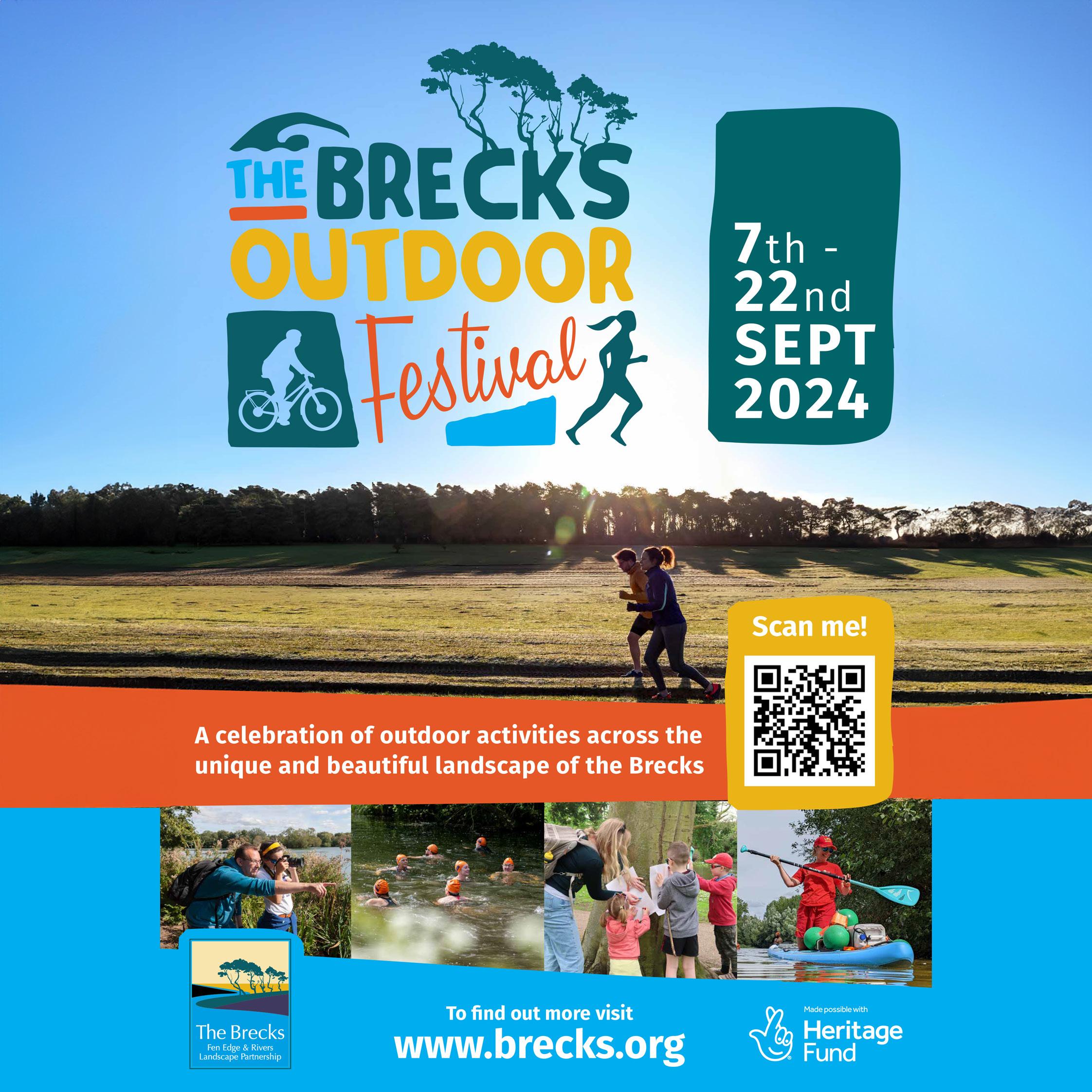
Because the Brecks isn’t just a unique landscape with a rich history and diverse nature – it’s a home for over 141,000 people too, and around 20% live in Thetford. That’s why BFER is based here, and why it has invested so much of it’s time and money in this town and run so many events on Butten Island and at The Carnegie. The more that’s going on in Thetford and the more connected we all are, the better for all of us. And the majority of the work BFER has done has been in supporting local groups and organisations that are already doing so much for this community.
To name just two, Run Breckland, an entirely volunteerrun organisation who have responsibility for Thetford Park Run, has been a steady partner of BFER throughout, providing running opportunities throughout the Brecks but, perhaps most joyfully, the Easter Bunny Run and Santa Runs in Thetford each year. Similarly, when BFER put out a call to provide training and support for young people in the area, Bush Adventures answered it, developing a six-week programme with BFER funding to encourage, support and provide training for young people with special educational needs or who are not in education, employment or training.
And that’s the beauty of the work being done by BFER – it’s all about collaboration and connection. It’s about taking what is already there and learning about it, promoting it and strengthening it. Sadly, the funding from the Lottery is coming to an end and, with it, the BFER scheme. The hope is that a new Landscape Partnership, perhaps with more longevity, will take its place and continue this essential work. However, for now, BFER will continue to make connections and promote and protect the Brecks while it is still here and, this September, it is celebrating all that it has achieved so far with a brand-new festival: The Brecks Outdoor Festival. Two weeks jam-packed full of outdoor activities that reflect the breadth of the Brecks project. You can find out more about the Festival, as well as all projects mentioned in this article, on the BFER website: www.brecks.org

“We absolutely loved having the eels.”
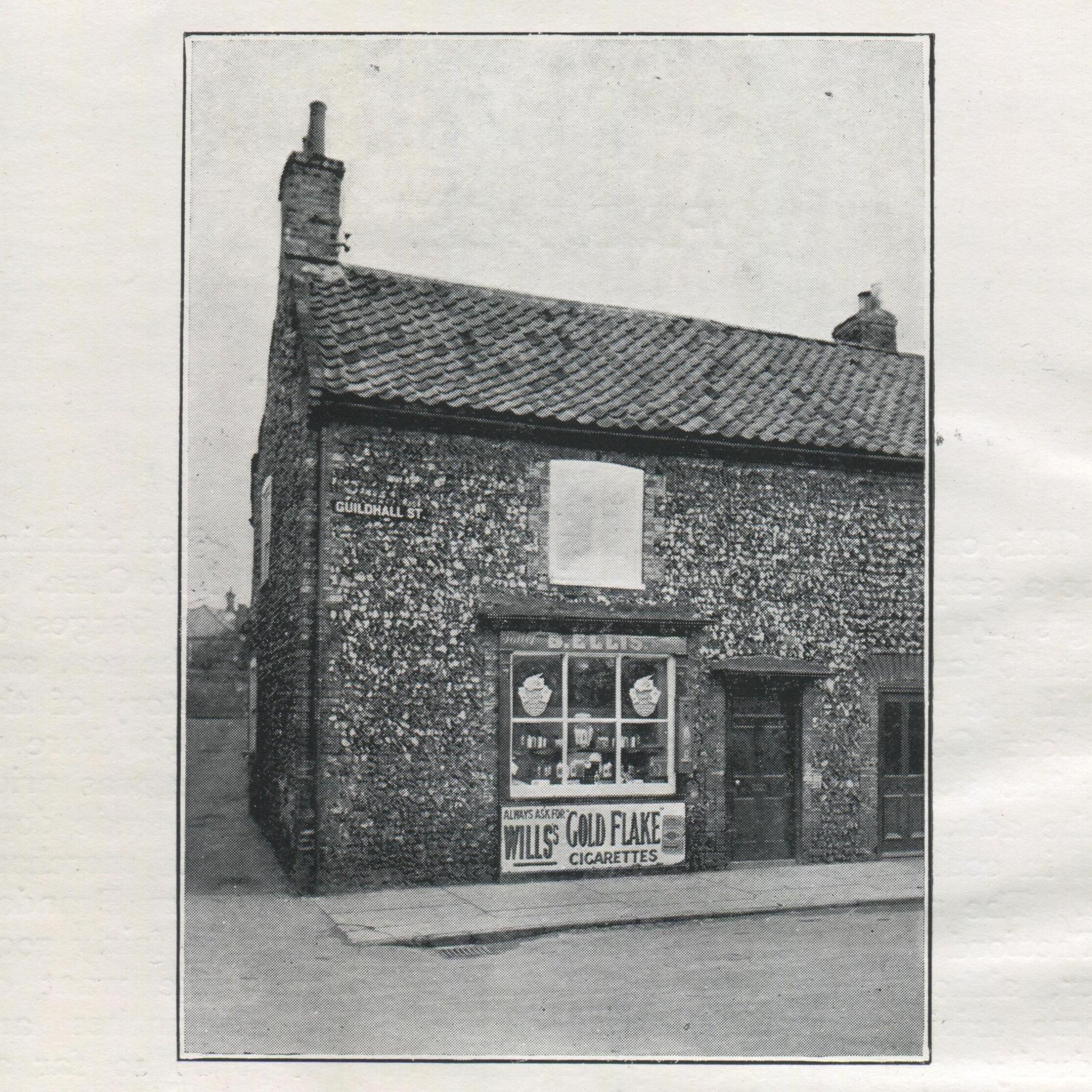
Thetford’s first Co-operative shop 1861, this is where the entrance of Roy’s shop now stands.

Written by Craig Plumley
It may seem rather obscure that Thetfords’ leap into the Co-operative World would have come from a sack of flour, but this was its humble beginnings in 1861. Mock as I might, I cannot help but admire the simplicity of community business, and the subsequent boom in local trade. Now, don’t get me wrong, we have been trading for thousands of years around the rivers of Thetford, who could ignore the Vikings for starters. But it feels very much like the Thetfordians of the late 1800’s had a more progressive plan.
Like those Vikings previously, the trading around Thetford in the 1800’s relied on the navigation of the Little Ouse, and Kings Lynn was a preferred destination. The river’s upkeep between Thetford and Brandon was instrumental in keeping business thriving, as these riverways of Thetford had for many years been a supply of coals, corn, flour, timber, and other kinds of merchandise, for the enterprising trader.
A Thetford miller was one such trader, who along with a ‘gang of lighters’, would regularly take the flour from

Thetford to Lynn, and sell it for 3d per stone less, than he would sell it to his own Thetfordian bakers and customers. I have briefly stopped typing so I can look up ‘gang of lighters’. It would appear to be several barges tied together, and operated by lightermen. It would also appear that the nefarious sounding ‘Gill’s gang’, were to be the engineers of this ruse. I say ruse, it is of course, just common practice of businessmen to seek profit and create new markets. However this was seen as a rather underhand practice and caused much consternation among our local townsfolk, as they found the fairness of this system fell considerably short. So what did they do about it? A few working men opened a fund and as soon as they had raised enough capital, they bought their own sack of flour from somewhere else, Norwich to be precise. They managed to yield a satisfactory profit, and so began a new business with one of the working men trading this flour from his cottage in Magdalen Street. So the flour trade began, and flourished, becoming so successful that more items were sold by the amateur grocers, such as cheese, lumps of bacon, and butter. The purchasers would even bring their


own wrappings, which appears very similar to how we now bring our own plastic bags to the supermarkets.
I don’t profess to understand the finer details of the co-operative society of the 1880s, but it does appear on the face of it to be an honourable system, whereby the customer genuinely did get a better deal by shopping at the Co-operative. We, of course, have similar sounding loyalty schemes these days, but that’s as far as it gets... similar sounding!
So, there had been success to this new enterprise, and the monopoly of ‘Gill’s gang’ was seemingly broken, and so began the Thetford Industrial Cooperative Society.
The Society started in earnest in 1861. The cottage on Magdalen Street had become too small, and an extension was sought. The store was moved to ‘a decent sized cottage with a large outhouse in the rear, and situated near the Market Place.’ The site was a cottage on the corner of Guildhall Street, where it meets Pike lane. It would eventually make way for Roys, but not before it had been a barbershop, and a fish and chip shop in the 1960’s.
Anyway, back to the main plot. It would appear that the Co-operatives early years were far from straightforward. ‘Gill’s gang’ and other traders had complained about undercutting of goods. I must confess that I have in my head, ‘Gill’s gang’, impeccably dressed and operating like Breckland Peaky Blinders, or with a mafia-like impunity. However It is more likely the ‘gang’ is indeed the barges, and Gill is just a good old ’boi’. I’m sure a local historian has the answer, but for now he is my Al Capone of Thetford.
There were frequent management changes over the next 20 years, after poor purchasing decisions which had resulted in losses. However neither of
these stopped the growing Society, and a newly appointed manager, one Mr George Foulger, a Thetfordian, described as a ‘thorough, honest, sober and industrious young man’,took the reins. We will accept ‘sober’ here as being serious and sensible, as with 25 plus local pubs to Thetford’s 4300 residents, it’s unlikely anyone was in the truest sense sober in the 1880’s.
In 1882, after several years Mr Foulger’s perseverance and hard work paid off, and the Committee looked to move premises once more, as the cottage shop was now too small. A site on King Street was chosen but fortunately the proposed purchase fell through, reportedly due to the lack of further space for development. As, so often happens in these situations, a far more suitable property revealed itself, just across the road from its present store. This was to become a well known, and loved store, with many memories of the store and its workers, still with today’s townsfolk. This new prospect ‘...contained two excellent cottages, a large house and extensive stone mason’s showroom workshops, offices and yard…the rear of the property opening into Raymond Street, and had a capital blacksmiths and a shoeing forge.’
The building cost a mere £756, and by mere I mean with inflation taken into consideration it would be £77,000 in today’s money, so says The Bank of England. I’m not entirely sure of the relevance, but I will leave it in for the reader to ponder.
A grocery, drapery room, manager’s office, warehouse, and caretaker’s rooms were all built with a speaking tube in the corner of the manager’s office. The tube, no doubt a fashionable, new fangled, addition of that time. This fine store opened on the 27th November 1884
Thetford Co-operatives expansion was to continue
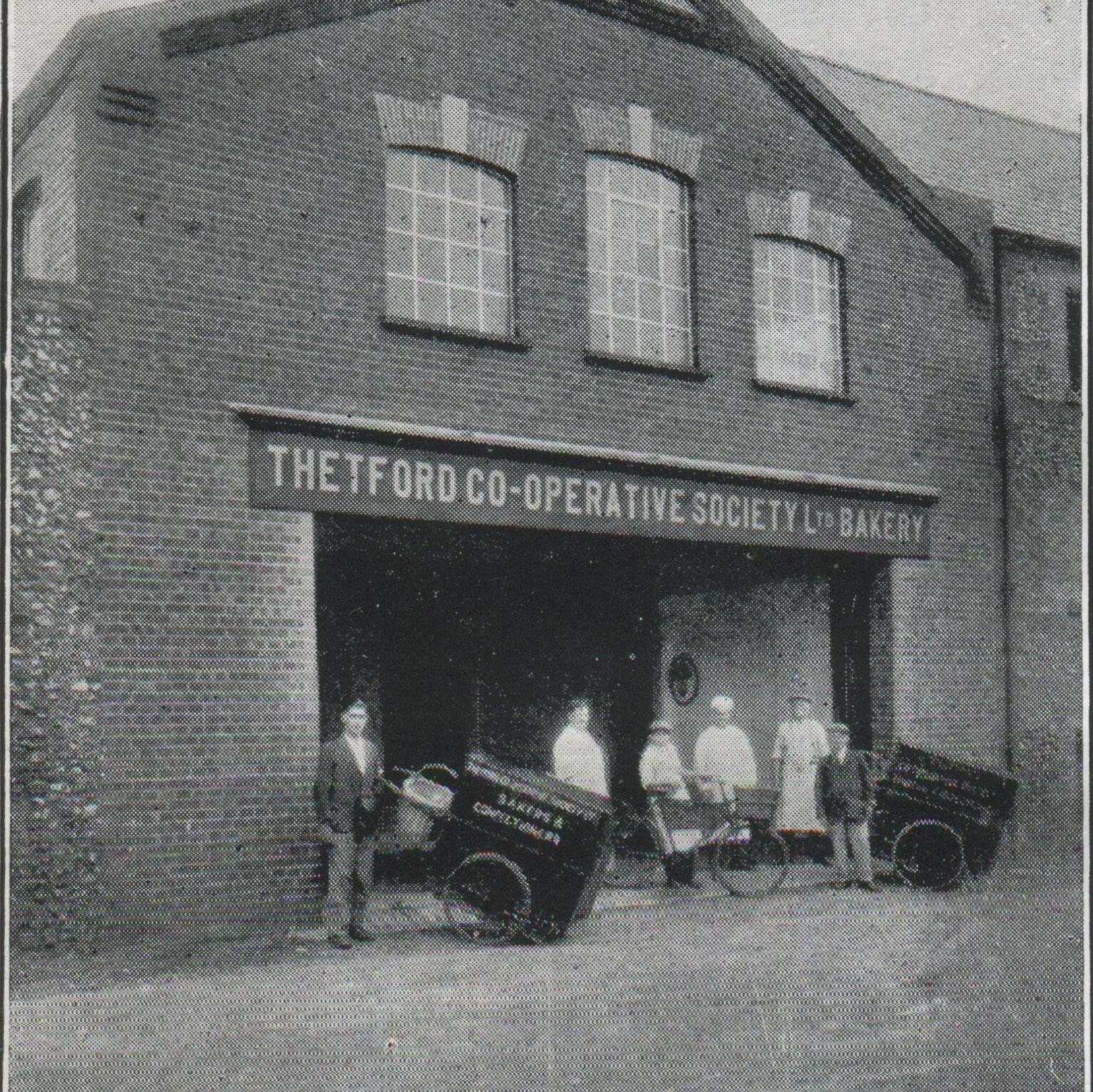
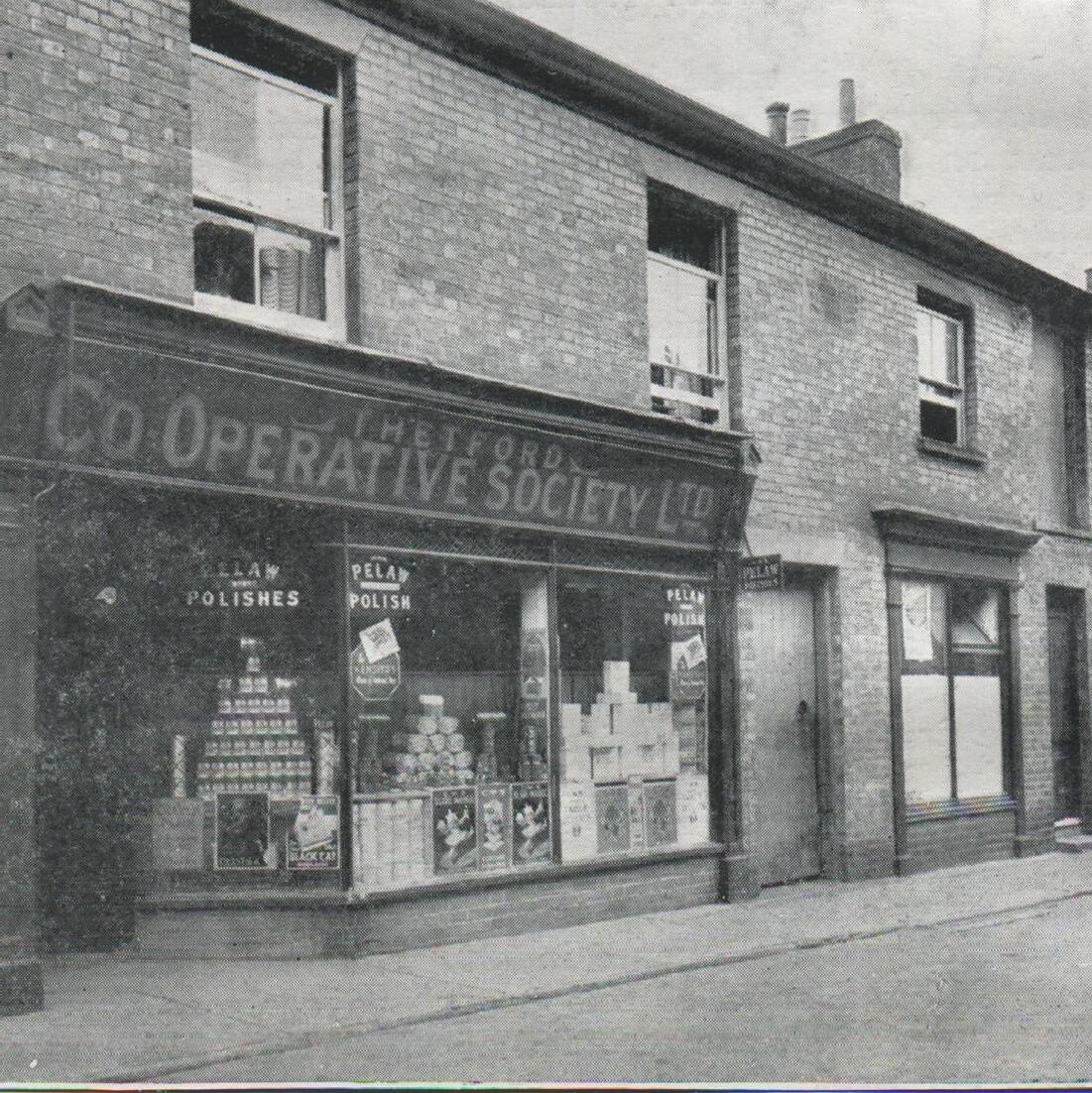
with a premises in St Nicholas Street purchased in 1893, which would become the bake house. It boasted a new double oven which separated the coke fuel from bread and cakes, preventing direct contamination. It would have been the talk of town. With multiple Co-ops in town, this one was known as The Back Street Co-op, not because they dealt in hooky goods, but because St Nicholas Street was formerly known as Back Street.
A third shop was opened in 1913 on the corner of Bury road and Mill road. This would complete the co-operatives expansion for that period. Some questioned whether three stores were too many for Thetford, with modern means of delivery, etc. However all the stores were to thrive for the next 50 plus years, and one would surpass 100 years before yielding to market pressures in 1987.
So this article, albeit brief, gives an overview of the Thetford Co operation Society’s marvellous growth over the late 19th and very early 20th Century. I don’t for one minute claim to truly understand the dealings of dividends, profit sharing and the intricacies of ‘economic participation’. If I’m completely honest that part made my eyes scrunch up tight, but I do like a good story.
Which brings me rather untidily to a short excerpt from a local paper in 1925. It reported that one Sunday morning local police constable Warren whilst cycling past the rear gates of the Co-op on Raymond Street, heard a noise at the rear of the property. He immediately proceeded to the police station and reported the matter to Inspector Banyard. The two officers at once returned. They had raised some private individuals to assist in keeping watch.
It was reported as ‘the perpetrators had a somewhat exciting experience in making good their escape.’ It

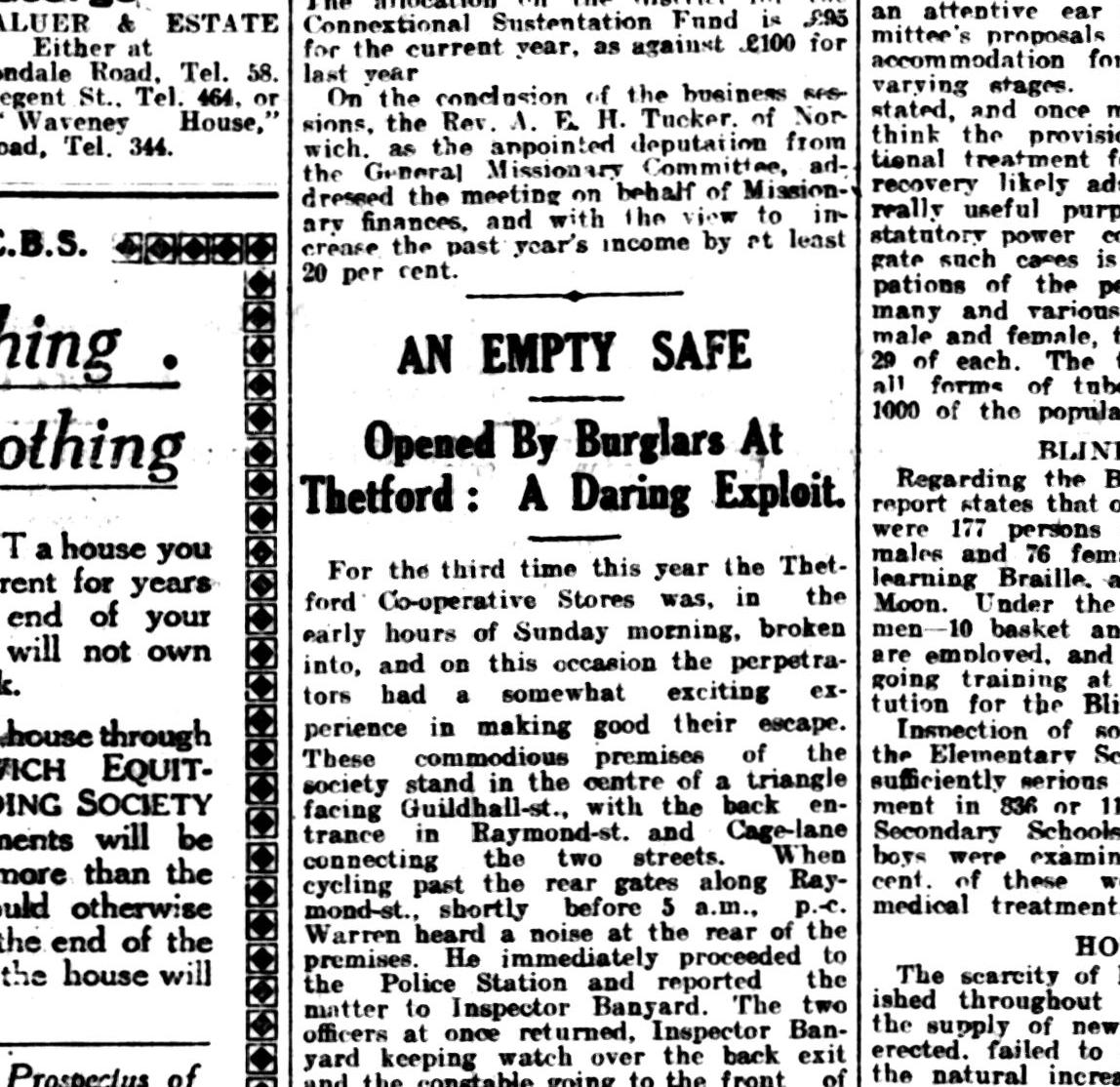
immediately made me think of a robber garbed in a black and white jumper with swag on their shoulder bag, and I wondered what today’s baying mob on Facebook would make of this situation. A different description, at the very least!
At 5:30am as the sun was rising the burglars were flushed from cover and ‘..emerged over Mr Gill’s gateway on Guildhall Street’ I have for the purposes of satire decided that this Gill* is somehow related to the dastardly Capone Gill of 1880’s. I mean how many Gill’s can there be? However, in the name of fairness and of course any offence to living relatives, I have to have decided that this Mr Gill was an upstanding citizen.
So, we return to the caper, and it would seem poor old PC Warren isn’t having much luck.
‘..to obtain this means of exit they had to negotiate no fewer than four walls seven or eight feet high. PC Warren observing the men escaping raised a hue
and cry, and chased them down Nether Row, but was unable to overtake them, and they made good their escape.’
The newspaper report goes on to describe how they came away empty handed as the safe was still awaiting repair from a previous escapade, and therefore empty. Further misery for our unlucky pair as in the excitement of discovery, they left behind their swag, which consisted of cigerettes, a few eatables, and also their thiefly tools, a ladder, a hacksaw, chisel, and a small iron bar. But it was not a complete loss for our rascally robbers, as a very old pair of shoes were left behind in the stores and it is understood a new pair boots is now missing from the outfitting department.
The Thetford Co-operation society clearly has a story to tell,and I’ve only just lifted the lid for a quick peek. Similar named businesses continue to be in business in the town, with the Co-op Travel**, on King Street, and East of England Co-op Funeral Services**, on Bury road. A funnier person than me might comment on them both being travel agents, but I won’t as I’m probably still in trouble with the lovely Gills of Thetford.
Editors notes
*Mr and Mrs Gill ran a Funeral Business in Guildhall Street at the time of the robbery, there is no association known with the ‘Gill’s Gang’.
**Co-op Travel and East of England Co-op Funeral Services are completely different companies, and have no association with Thetford Co-operative Society, reference made due to the similarity of name for editorial and entertainment purposes only.
All photographs kindly submitted to Reflections of Thetford magazine from a private collection.


Written by Hannah and Keri
Edited by Andy Eden

William Blake once said ‘hindsight is a wonderful thing, but foresight is better.’
As we sit and ponder the last year we ask ourselves if we would have made the same choices and If we hadn’t, then would we have ever met each other and how different would things be now?
To see things through hindsight and the struggle that we have both equally endured through our lives, we feel grateful that we did not foresee what our stories would be and how we would be brought together.
As the past year has flown by we have shared our histories and planned the future that we want to see within our business. We share a multitude of idea’s and spend a lot of time day dreaming of ventures that we know will never become reality. We are aware that we are living a dream that we have been able to make come true, and that has required our full focus. Something we both find extremely difficult. No two journeys are the same, even though we have ended up in the same place, so we have decided to tell our stories seperately.
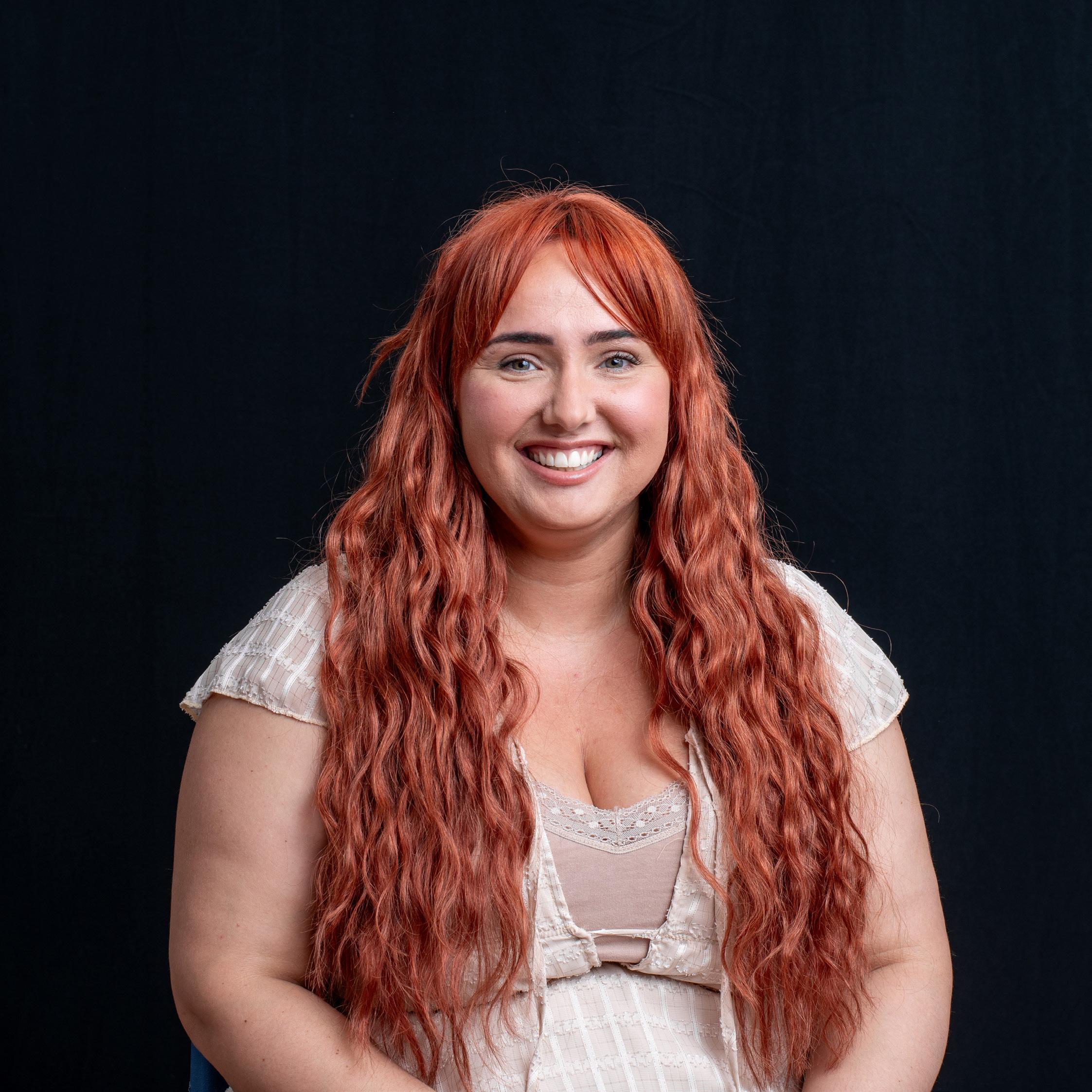
Idon’t remember a lot from my childhood, but What I do remember is that I was always day dreaming. So much so, that a nick name I had was Dolly for Dolly Day Dreamer. I felt like it would be said with negative connotations but I quite like it. I loved blocking out the world and being able to live in my own world.
In one of my earlier memories, I would dream that I was a hair dresser. I would see myself so vividly, I had on the Levi skinny jeans that my Mum lived in at the time. Only I had the highest stiletto heels and would be working behind the chair spraying hair spray as though it was going out of fashion. What can I say, I’m an 80’s baby.
I remember watching the original ‘Hair spray’ with Rikki Lake on repeat because it involved hair, music and dancing in heels. Please don’t ask me to remember any details! My memory for films is horrific! I spent a good portion of my 20’s dancing in Stiletto’s on random Friday or Saturday nights but I never made it to wearing any heels when behind the chair. All these dream’s I had, yet when I left school my confidence was so low that I went straight into working in childcare. It seemed like the most logical thing to do as I’d always been good with kid’s. By the time I was 19 l was a Mum and I took a job in a bakery as a sales assistant. Working in child care was not for me! For year’s and year’s I would look at different job’s but nothing really captured my attention. I’d done business administration, Media Studies, worked the stalls in the high street, property management... bouncing from job to job and feeling like my chance to be a hair dresser would never be a reality.
By 23 I’d had my second son and the reality of my
Levi’s were a grey pair of Adidas Jogging bottoms and unwashed hair. Sleep deprivation was real between a 4 year old who needed to attend school and a new born who refused to sleep. All my focus was taken by my children and I soon become a bit of a hermit. I stopped visiting friend’s and family, I was barely making it through the days. Each day turned into a blur.
At 26, Just as I was coming out of the mist. I received the devastating news that my Dad had passed away. My heart broke. I was absolutely devastated. How do I tell my Nan? My Grandad? My Sibling’s? I got in the car and drove towards the hospital, in a haze I passed my Uncle’s garage. I pulled over and got out the car to tell him. My legs collapsed under me and I was in a ball crying uncontrollably.
My Dad’s death hit me hard, I’d feel devastated for everything that he had missed out on whilst bringing us up. He’d never been abroad and after my first holiday a few month’s before his death, we’d talked excitedly about his upcoming holiday planned for the year after. He never got to go on that holiday, so many things he never did. I was in a daze driving through my local town when the college come into my sight. I swapped lanes and drove into the college car park.
Without any thought or hesitation I enrolled for Hair dressing. I had to apply for all sorts of funding to help with child care as that was my biggest worry! My car had broken down by the time the course started. So I would get the bus every day (luckily I’m from London so bussing wasn’t so bad). Then I moved and had to wake up at 5am with my 7year old and 3 year old, we would get the bus to the school’s they attended and then I would return to the same town we lived in to attend college for 9am. But I sure as heck was not giving up!
I completed both level 2 and 3 with distinctions. Studying was difficult, I couldn’t take in the information whilst in the classes so I would go home, read and re-write in my own word’s everything on the subject we were studying until it sank in. I left college and got a job straight away, I was extremely lucky but I was also working at a fraction of minimum wage. I just needed to gain the experience in order to create a career. I eventually found a better paying job and my career continued until we hit another brick in the road. My son wasn’t coping well in school, my Nan had a minor stroke, my cousin had been murdered, my Grandads Dementia was deteriorating and my Mum was eventually diagnosed with Cancer.
Yes! All at the same time! It was my number that my family called for support, so the career I worked so hard to get needed to be put on hold. I honestly felt like I would never get to where I wanted to be. But

some thing’s are more important. I found a home suitable to take care of Grandads needs. My Nan, she’s a warrior even up to this day. My cousin’s murderer was sentenced to a minimum of 25 year’s before parole. After my Mum’s diagnosis, came my uncle’s. But in true Smith style (always outdoing each other even in death, siblings hey!) My uncles passed away in the November then December and my Mum in the February after. By this time I was numb and within the remaining year, my Grandad also passed away. During all of this My Son had been excluded from school and was undergoing assessment for ASD/ADHD. He began to attend a PRU (Pupil Referral Unit) and over time his behaviour began to improve.
In 2019 I decided that a fresh start would be the best thing for us. We moved from London to Thetford. My eldest started school however things were not so straight forward for my other son. He was out of school in the new town for over 2 years before a suitable placement was found for him. During this time he was homeschooled.
I fell pregnant with my third son and received the shocking news that he may or may not survive the pregnancy. If he did survived he would need treatment. Then Covid hit.
All these appointments to go to and the uncertainty of not knowing. I had to deal with it all on my own. My friend’s and family were all in London whilst I was isolated in a new town where I knew no one.
After a very traumatic birth, an emergency Caesarean and 3 month’s of blood transfusions my baby boy was in the clear and full of health. Desperate to be apart of the world again I looked for a part time job. I replied to an advert that I found on Facebook for a position as a hairdresser on the Air Base. I become a part of the team for 2 year’s. Being aware that I was in a new environment where no one knew me and hairdressing
being a very sociable job, I felt that I needed to make myself more available. I found a couple of positions where I rented a chair, to help rebuild my career and get a portfolio together. I need as much experience as I could get and I needed to rebuild my career from the bottom up.
When I moved to Thetford, I would drive past a neighbour on my road, they would be getting ready to go out on their quads and I really wanted to ask them where they took them. It looked like so much fun and in London we would never get away with quads! I never knocked and never asked but I was always so curious about this family that lived up the road and hadn’t had their quads confiscated!
I was chatting to a client one day, I said how I’d seen this advert asking for Stylists that wanted to rent a chair. It was close to me so would be perfect but I had already committed myself to two other salons. Without hesitation she told me to go for it, after some words of wisdom of course. So I sent the message and that is how I met my curious neighbour with the quads, Hannah Gilson.
It was the 27th of January 2023, I wasn’t sure what floor the salon was on so I called Hannah as I walked towards the Charles Burrell Centre. What a touch that the salon was up the road from me! She answered but seemed confused by my question, the salon was not in the Charles Burrell centre. It was in fact on Station Road. I rushed off to the car to make my way over. I walked into the salon and said hello. It’s a nice atmosphere and everyone is all excited. I love how it’s been decorated and everyone seems so nice. I’ll take on one day a week to start with and we will go from there. I hit it off with Hannah, she gets excited over the same silly things that I do and we spend hours sending each other reels to do with hair and new products. It’s so good to meet someone who has the same interests
as myself and to get overly excited over the simple things in life!
We started to talk about teaching, I’d always known I wanted to go down that route as hair dressing is so strenuous. I needed to look after myself before retirement. Hannah had already taken the route of teaching and had gone on to do her mental health degree. After everything we had been through we could understand each other’s struggles and emotions. This led to us becoming each other’s support.
People would come into the salon and say how much they loved us as friends, they would ask if we co-owned the salon. After a few months of encouragement from our clients and months of day dreaming and bouncing around idea’s, we decided to give it a go! So we set off on our journey together. We have students from West Suffolk College to help with work experience, children from schools who have struggled severely in a mainstream setting. We work alongside social service’s providing one to one classes for students who come from more troubled back grounds, we also work with Norfolk County Council. As much as we love what we do, we hate paperwork! We sit together and support one another to get through all the that! Something neither of us could do without the support of the other!
As I sit here writing now I cannot express how lucky I feel to have met someone who shares the same visions as myself, someone who understands my family dynamics, who accepts me as I am wholeheartedly and has welcomed me into her family. We are also extremely grateful to Barry (our Masseur at The Elite) and Hannah’s husband Daryl for reminding us to keep our dream’s realistic and doing all the DIY.
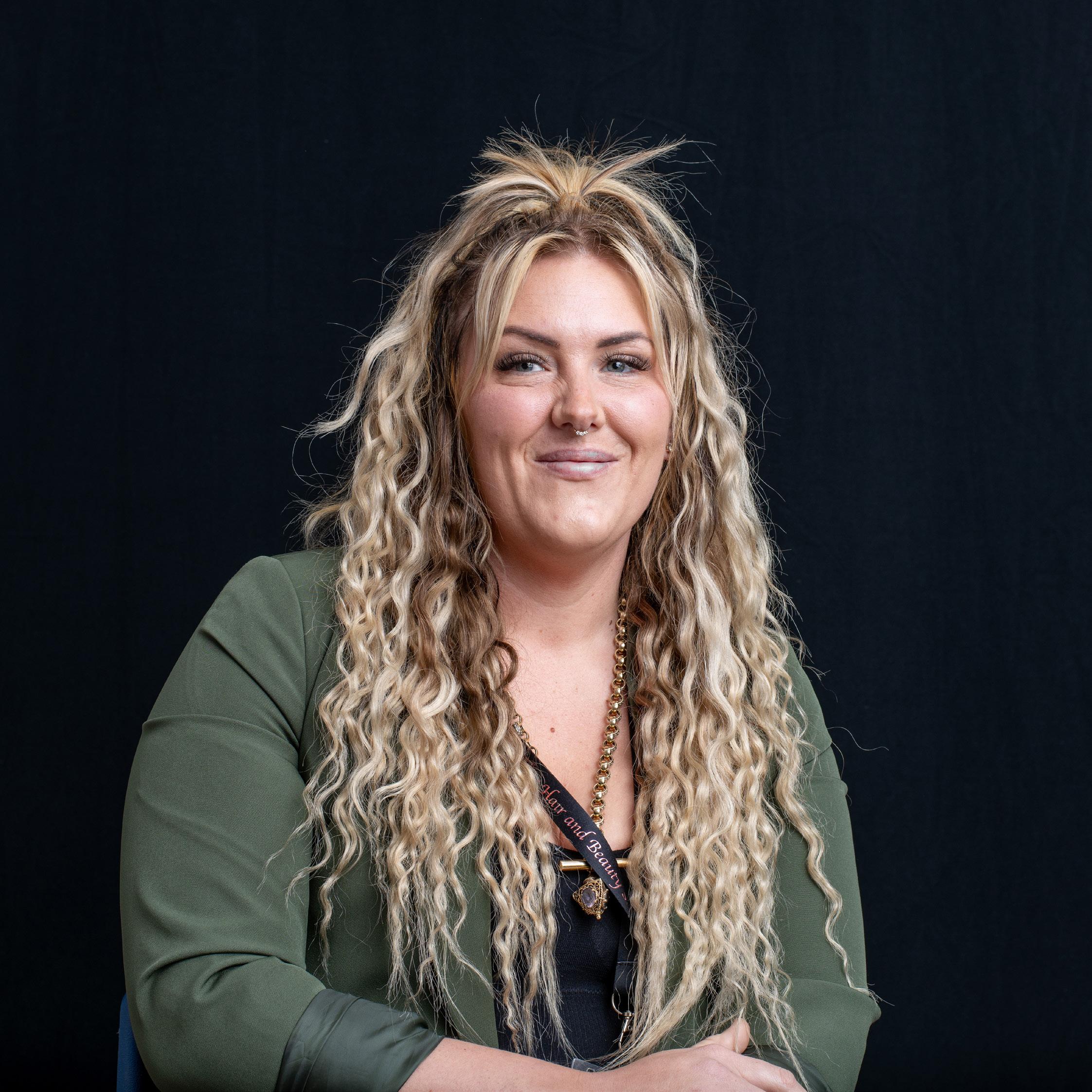
As a young girl I was pretty oblivious to life or gaining grades at school, it was all a blur. I hated the thought of school. I liked school itself but I didn’t like the thought of knowing I’d be wrong all the time..
I just learned over time to block things from my mind and I learned to go away with the fairies or as my people will say, live in unicorn land. But did I learn this coping mechanism or is this just a part of me?
I’m still as confused as I was as a young girl when it comes to words and numbers but what is clear to me is that I get great satisfaction from helping people.
In 2007 I met my husband Daryl. I was in my final year of college. I had done an extended year of hairdressing’s more advanced work. I remember wanting to give it up because I couldn’t understand the theory side. I couldn’t concentrate and I remember the words would float around the page. I thought I was becoming even more crazy than I already was!
I remember ignoring the phone to my parents when the college would call them and talk about their worry’s about my written work not being completed. I just wanted to give up. My husband convinced me to continue as I only had a few months of my course left. At the time I was staying with my granddad in Feltwell as the bus journeys were so long each day.
My dad would sit in the car park waiting for me for hours while the teachers at kings Lynn college put in so many extra hours for me to get the pass I
needed, for which I will be always so grateful.
I did pass and the feeling was amazing, At the time I was working on the Market Place at a little salon called clippers it was great experience, the girls were all so caring and lovely.
It was a nightmare getting from Feltwell to Thetford and back so I decided to go for a job at Deb and Hair based in The Sanctuary in Feltwell. As I was staying with my grandad it was a win-win situation. I was in my element. I was getting to do all these lovely little lady’s sets and blow-dries whilst hearing all about my nan and grandad and how they worked on the fens and at the airbase. It was a great feeling, going home smiling and enjoying something so much.
My grandad would meet me from work and we would take the short 5 minute drive back to Wilton road where I spent many happy years as a child. My grandad at the time was around 83 years young, It was then that he had a fall and it all went from bad to worse at this point.
I decided to move back in with mum and dad. As the months went on I was a nightmare, fluctuating through different jobs to suit my lifestyle. Being so young, l laugh to myself now, thinking of how impulsive I was. One of the salons was a 5 star salon called Jazzy D’s and I really enjoyed my time there. One of my friends from school also got a job there, and it was a great vibe. We did lots of in-house training and went to London, worked with L’Oréal.
I still couldn’t find my normal self, if there even is a normal? In an industry that’s so big and wealthy I just couldn’t be pleased. I then applied for a job
at Centre Parcs in the spa. I loved it. I met friends there and even famous people who visited the Aqua Sauna. It was so tranquil and peaceful and the hours worked perfectly with my life.
One day I was poorly. I was always told I would never be able to carry children because of a car accident I had in my teens so I knew this couldn’t be the case.
It was 2010 when I fell pregnant at the age of 20. Despite being told about complications that could occur, we still went through with the pregnancy and had a beautiful healthy baby. We named him Reginald. At this point our lives changed for the better, we went on to have a healthy little girl in 2012. we had planned to name her Gracie May but there was definitely no grace in those lungs. We decided on Paige which was the perfect name for our beautiful girl, although the pregnancy was as the doctors had suspected.
I suffered postnatal depression at this point in my life. We worked through the bad days as a family and carried on. I did little bits of hairdressing as well as being a mum but I had lost the love for hair. Around this time, I remember visiting my brother Terry. Me and my husband would travel to Dereham daily to visit and we would talk about the memories we had as children.
As the years went on I fell pregnant again for the final time. It was 2016. I was so worried about the next stage as the pregnancy was terrible. But we kept high spirits and had a beautiful little angel called Ellis. I can’t emphasise how much we, as a family needed Ellis at this time in our lives.
The day after we told our family we were having our daughter, we sadly lost my husband’s father,
Darren unexpectedly. As the months went on we all grieved the loss of a father and a grandfather but as the months went by things where getting back on track, The kids were struggling a little at school with suspected ADHD and autism but that was ok. We were learning to deal with these challenges. From what I remember we then received an unexpected call from the hospital. Daryl’s mum had been admitted for a water infection. We went and picked Daryl’s younger sisters up although one sister was on a flight home from her holiday. As we arrived at the hospital it was the worst news we could receive. The doctor said we have some bad news and just said your mum passed away in the night. We were all heart broken.
We didn’t know which way was up at this point, we were all so numb. As the weeks went by we had to arrange another funeral and pick the broken pieces up, not knowing if they could ever be fixed. It was so devastating, I had 3 babies, a husband and 3 sister in laws all broken hearted. We all lived together with them camped out on my front room floor. trying to look after each other the best we could.
A few months went by and the house next door to us came up for rent. It was perfect for the girls. We even took the back fence out and no matter how much of my toilet roll or ketchup went missing, we were happy. We were such a close family unit and we still are today.
Me and Daryl even got married in the July! It was only a small do. We had my mum, dad, brothers, Nan and grandad and Daryl sisters and aunties and nieces and nephews. It was nothing special at all.
It was around September my lovely nan Josephine,
passed away with cancer. She was a queen to our family. In my eyes I couldn’t have asked for a better nan.
I remember being excited around November time as everything was going so well. the girls had got jobs at Baxter’s along side the rest of my family (Baxter’s through and through like my brother Craig emphasises on a daily basis). I’m so proud of all of them they have whole heartedly held their jobs down for all these years and still continue to do so. Even after grieving their parents at such a young age.
My son Reggie’s birthday was a few weeks later so I arranged a Mexican night at my house to try get us together without being at a funeral! I had my brother Craig, mum, dad and brother Terry with all my nieces and nephews coming over. My brother Terry was late as usual. I remember saying to him when he walked in, “you’d be late to your own funeral you would.” He gave me a slight laugh. It was the perfect night. All the grandkids played together so well. Everybody went home humble and full of love.
The week after that, I had a phone call in the early hours of the morning. Answering it, all I heard was ‘brother died.’ I was so confused. My dad came to the phone and said sorry Han.
Daryl drove me to my mum and dad’s house right away. Feeling confused and empty, the car journey felt like it went on forever. As I walked through my parent’s front door, a notification came up on my phone. On Facebook, it was a photo of my brother on the front page of a newspaper.
I remember feeling nothing but pain if that is possible?


The Elite hair and Beauty Studio also known as The Elite Hair and Beauty Training Academy are able to offer the following services.
Make up/prom/bridal, Session styling, Eyelashes, Manicures, Basic and Luxury Facials, Dermaplaning, Skincare , Eyelash extensions, Waxing, Eyebrow Definition.
Colour, Colour corrections and Vivid Colours, Cutting, Styling/Hair Up, Hair Extensions and Fitting (most methods), other treatments available.
A wide Variety of Aesthetic treatments available including, Botox, Filler, Chemical Peels, Fat Dissolving. A lot more treatments are available, feel free to contact us with any enquiries.
BIAB, Gel Polish, Acrylic , Extensions/Tips, Manicures, Pedicures, Nail art
Massage Therapy, Hypnosis, Holistic Therapies, Hopi Ear Candles, Pamper Parties, Bridal/Hen Parties and Children’s Parties.

19A Station Road, Thetford, IP24 1AW
01842 630923 or find us on Facebook
As The Elite Hair and Beauty Training Academy we offer support to the local and wider community. We are able to offer 1-to-1 training for private student’s. We also offer smaller classes and classes that offer additional support for those that feel like they need it.
We have been working with the Pathfinder Trust, supporting individual student’s and doing larger project’s with the schools. We work in partnership with the following organisations: YOT (Youth Offenders Team), NCC (Norfolk County Council) and Social Service’s.
Local Schools, and Virtual schools, to help prevent exclusion and provide recognised qualifications. We also offer community support working with local counsellors, to be able to do referrals for food bank and gas/electric vouchers.

My brother had custody of two of his children and they all lived with my parents as well as my brother Terry. It’s the hardest thing I’ve ever had to deal with in my whole 27 years. Another funeral. It was all such a blur. The support the Thetford community gave our family was heartfelt. My brother was one of the kindest, most loyal, caring men anyone would ever meet.
As the months went on, my mum and dad took on parental responsibilities for Harvey and Abbie, we helped as much as we could.
My mum and dad tried to go back to work but it was too hard for them to cope with the loss of their son so they took early retirement. In the January my mum was admitted to hospital with pneumonia. She died on the ward that night but an angel was looking over her. A nurse was with mum as she lay there, and pushed the panic button. They resuscitated her but we were told to expect the worst. she was put in an induced coma.
The medical staff tried to bring her out of the coma twice without success and I felt I was cursed. I thought she was gone but a third attempt brought her round. It took a long few years of building her self back to good health. My dad then went on to be mums full time carer.
I was so confused In the years after my brother died it is still a bit of a blur.
After a terrible few years struggling with my mental health, I decided to hide away from the world. I didn’t want to be happy Hannah any more. The only way that could be done was to become a recluse. I had friends pick my children up from school while I would pretend I had meetings and I would get food shops home delivered so I didn’t
have to see any one. I got so sad that I didn’t know what happy was any more. I gave up my role on the PTA (Parent Teacher Association) at my children’s school which I loved dearly, but I didn’t want any more people to be upset by seeing how empty I was. I knew they would ask questions and I thought no one would understand.
I was always the one who cared for people and I felt like I’d let everybody down. My children were suffering and I’d put on so much weight while being depressed. I would have bad thoughts go through my head on a daily basis. I didn’t want to be here any more.
I obsessed over my brother’s death I thought of many reasons as to why he was killed, other than just a road traffic collision. On the nights I slept, I would wake up from nightmares of my brother in that car. At this point I was ready to take my own life. I was a manic depressive.
Finally there came a day came when I just cried constantly. My husband looked so lost, having run out of idea’s of how to help. He had tried everything.
I eventually got some plain drawing books and started to draw and scribble how I felt and I also started to write poems. I didn’t realise at the time, but it must have helped me because I then went on to start going out the house again. I even started speaking to a friend of mine. she didn’t judge me and after a while she asked me to do her hair. I agreed and things moved on from there.
I started researching to see how far behind I was in the industry and it seemed I was just a bit dusty so I took some courses to refresh and bring myself up to date. I even rented a chair at ‘Sarah’s Scissors’
in the community Centre. Apparently, what I thought of as ‘my crazy self’ was normal to her and she took me on just as I was. I soon found myself laughing more days than crying!
Clients would say how do you do it? I said ‘I’m just Hannah.’ The look of confusion on their faces would make me laugh because I was just winging it…
But they thought I was amazing.
I was just being myself. sometimes I’m too honest and my face shows it all. It says honest in capitals letters, let me tell you. I was amazed that people were rebooking and I was fully booked without needing to advertise. I decided to push myself and do my teaching degree. I’ve always wanted to do it just to sound posh.
With me being such a unicorn in the past and not being able read or write, it was kind of laughable. I carried on despite this and I had to set my alarm for 3 am every morning to take medication and set a routine for myself. I had to stick at it to prove myself!
This is how I felt. I’d told everyone I was going to do it and I didn’t want to let anyone down including myself. There was no going back!
I met a tutor who has helped me tremendously. I paid privately out of the money I had earned and she let me pay her weekly over the time of the classes!
When it came to the exam, I passed with flying colours! I had such a confidence boast! Me ! A teacher?
This set my brain on overdrive I had unicorns and flowers flying around in my brain!
Honestly my family was so proud of me, especially my husband who’s my number one fan. He has sat with me hours on end, helping me understand questions in the way my brain would take it in. It felt amazing!!
It was only at this point in my life that I felt normal… I’m always being told how calm and caring I am but my autistic brain went into overdrive. I wanted more! I decided I wanted to open my own shop to help people on low incomes be able to pay a low rent. It would only work if there was enough of us to make it achievable.
One day I bumped into a jeweller in town who had been my boss when I was 14. He told me how proud he was of me and that he had just passed some certificates himself but he was struggling. I wanted to help him! I set out to make it my mission. Here I am now 3 years later and I am his boss!
He rents a room from me with in our thrivi ng community environment!
During the time setting The Elite up, I was homeschooling two of my children as my little rage (Paige ) found school challenging and it was an uphill struggle every day. It is understandable as she is being diagnosed for autism and ADHD and has been diagnosed deaf and wears hearing aids. My son Reggie had suspected autism, now diagnosed. At the time they both held Education, Health and Care plans (EHCP) which, at the time, I didn’t have a clue about but I have come to realise they are one of the most important pieces of documentation they need. People who struggle like me will know my pain.
I then went on to not understanding autism. I knew so much about ADHD but that’s a story for another day. I have already gone off subject numerous times, but that just what I call my ‘tisms’.
So back on track. Autism, no clue at all. So I decided to use my spare time to go to university and do a degrees in mental health and well-being along with counselling. Little did I know where it would lead me to today. Back to 3 am wake up alarms, in place structure is back in the Gilson household. Tears were had and tantrums, excuses were tried. During the year and a half of doing my degree I struggled with homeschool, work, running a business and keeping up with all my family’s ‘tisms’.
Normally at this stage I would hide away silently, but I spoke out about it at our salon and all the staff rallied around and helped me with the running of the business. I wasn’t used to getting help. I had struggled but I had done it. I qualified as a mental health practitioner.
In a Year of learning and building bonds and without knowing it, I had made friendships I never knew could exist. We were working with Oxford university on a neurodiversity project. so one day, if you know me and Keri you will totally get this next part, a spectacular moment came to light. I decided I wanted to put my knowledge of our life experiences and children, my mental health degree, my 19 years experience in the hair and beauty industry, and my teaching degree together.
I wanted to link them together!
How? I didn’t know. ‘When’ seemed to be right at that moment somehow. The ‘why’ was to give people the feeling I get when you achieve
something that people always thought you would never be able to!
So back to my tutor I went to clarify that this was something I could do. I was already DBS checked. Around this time our salon workers had been helping me and sharing the same interests. I became really close to one of the girls down at the shop. Of course this led to her becoming my business partner and partner in crime. Our friendship just flourished and every problem or hurdle seemed so much easier with Keri by my side.
So off we went, sharing the same interests.
We are both devoted to seeing change and understanding problems also thinking outside the box and we are both very easily pleased. An
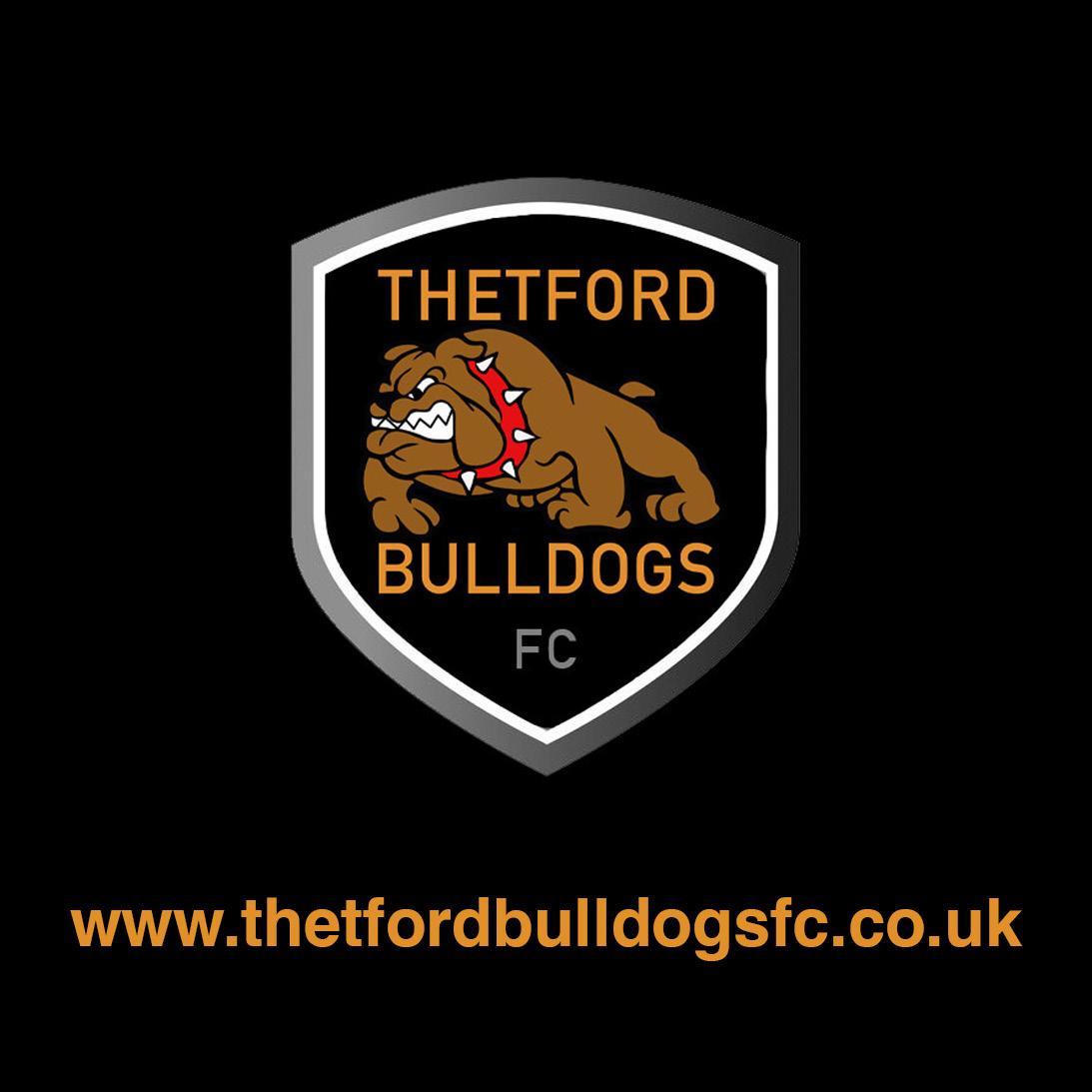

autistic mind mixed with an ADHD brain and a packet of Haribo is Dangerous! We came up with the most random ideas but I wouldn’t change it for the world. The next stage was like dragons den so we had to work with what we had.
Along the way we had met people who were willing and able to help us. So we got them to proofread our findings and we came up with a presentation and a proposal. We sent it out to Norfolk County Council, teams in social services and academies and schools around Norfolk.
It went off like a unicorn flying over a rainbow. We had calls and emails from virtual schools in Norfolk and we had youth offender teams contacted us as well as path finder schools and social services. We started working at schools in Kings Lynn each week and we even met the head of path finders schools. He personally came and met us for a 20 minute meeting which ended up in being 2 hours with lots of ideas. Looking back it feels insane.
Since we’ve taken on the role of mentoring, we have hired full time staff to take over some of the work load. We have also been approached with lots of new ideas for 2025.
We have now been approved after many safe guarding health and safety checks and of course the dreaded paperwork. We’re even on the data base as our own ARP (Additionally Resourced SEND Provision).
What an achievement!
We are a school for children and young people across Norfolk. Whether it be hair & beauty, mental health wellbeing or just mentoring young people
who have had a disadvantaged start to education. It could be that they have other underlying issues like anxiety or depression and can’t cope in a active mainstream school.
So my point to telling my story is …the glass is never half empty, it’s always half full, and it only takes one person in life to give someone an opportunity or a chance.
The Elite offers affordable rent for our team of trusted staff members, it offers a relaxed environment where no one will be judged, an array of treatments along with the training and mentoring of our young people from our community today. It took me 4 months to even put pen to paper as mr Bubbly Hub wanted to know my story. The thought of revisiting all those bad memories made me feel quite anxious and I didn’t know how it would make me feel, telling people my actual story. I do know one thing about telling it though, if it helps just a few people with a grieving heart, it will be worth it. To prove grief takes as much time as it takes. You are not broken or wrong for feeling the way you feel, you are human and it just proves how big your heart is.
In the words of Mahatma Gandhi, “Be the change that you wish to see in the world.”
And the moral of my story is that you don’t have to be the brightest spark in the book to succeed, you can even be an autistic unicorn like me… just be yourself.
“Be the change that you wish to see in the world.”
Mahatma
Gandhi




Written by Xanthe Cross
As she looked up from weeding, she was surprised to see that the sun was setting, draping its silken scarf across the wide Norfolk skyline; dusty grey, burnt orange, languid lilac. With a working life punctuated by the school bell, here on the allotment is where she forgets time.
This was one reason why she had not wanted to move house when she had been appointed five years before. She would have missed her plot too much or would not have found time to travel here as often as she would have liked. This was her safe space, her thinking place.
She had been musing about her appointment and remembering her inner dialogue at the time when deciding what to call herself in her new role. She had been the first female ‘Headmaster’ in almost a thousand years since the school had been founded.

Headmaster. Head of the masters. This of course presumes that all the teachers are ‘masters’; men in their black gowns, with canes and moustaches. ‘Yes, sir, no sir’, surnames only, ‘stiff upper lip, boys don’t cry’.
Headmistress. A similar assumption in this title with regards to the other teachers. Echoes of Enid Blyton and being sent to Coventry. The whiff of boiled cabbage, dark wood-panelled hallways, wrinkled woollen stockings, jolly hockey sticks. There have been centuries of examples of Headmistresses though historically usually of girls’ schools. Nowadays, in the state sector at least, over two thirds of head teachers are female so it shouldn’t really be anything special or noteworthy.
What about other sectors? What do they call their female leaders?
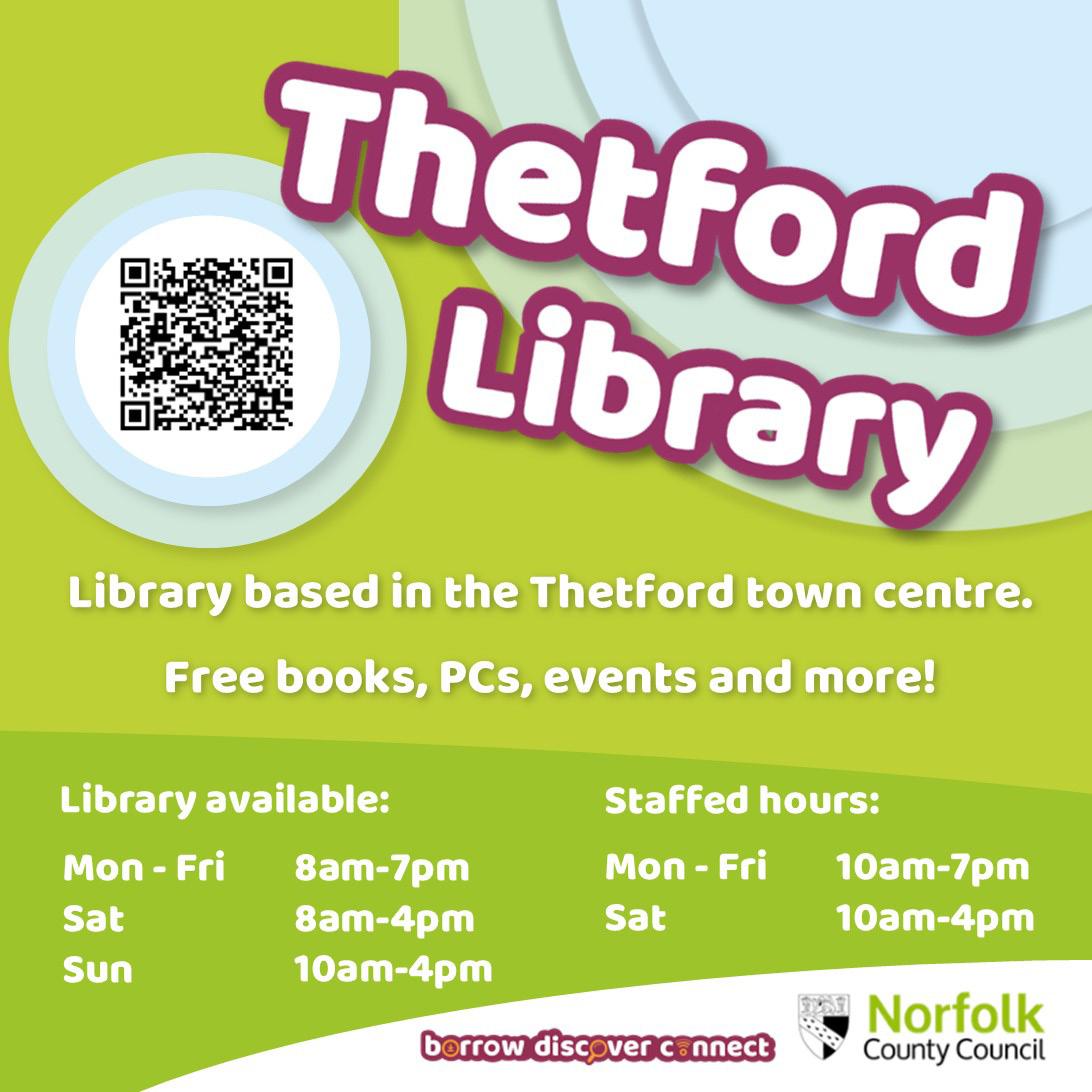

CEO. Chief Executive Officer. Too much like a business. The school is in the business of education, and it could be admitted that it’s running a business too; juggling budgets, satisfying overseas owners, managing personnel and premises. However, that might not be the desired focus on the ‘Meet the Staff’ section of the website. CEO, maybe that could stand for something else; Chief Education Officer...Childrens’ Education Officiator...Community Enhancement Organiser...
Prime Minister. Prime-Minister. Prime-Teacher. Sounds too much like Primary Teacher, and although the school includes the younger pupils it also encompasses the senior school, all the way to the age of nineteen. Prime also brings thoughts of ‘primetime’, like primetime TV; tacky and populist. Chief. Like a tribal leader, or the police. Isn’t that the term for a senior officer? ‘Yes Ma’am’.
Captain. Captain of a ship, or maybe a spaceship. With an astrophysics degree that might have been slightly closer to the mark. Captain of a sports team, though her role is more that of the team manager, managing not just the players but also support staff, finances, investors, community partners, exam boards, maintenance, timetables etc.
Other more outlandish options had flitted through her mind; Premier, President, Empress, Tsar, Esteemed Leader, each becoming more ridiculous. In the end she had settled for ‘Head’.
Her attention returned to the allotment. She loved this time of year. With the school year finished she had more time to spend with the flowers and vegetables. She loved the circular nature of the seasons on the allotment, not dissimilar to the school terms. Their dormant seasons were different. This was the school’s fallow time, summer. When the pupils
go home there is time for reflection and rejuvenation. To an outsider nothing much seems to be happening, but the maintenance teams are hard at it. Vision and planning are given space, and the framework for the year ahead takes shape. The buildings are used for other activities. She was proud that they were able to host the Thetford Mela Festival Finale this year. She had enjoyed building connections with the local community with trips to residential homes, artwork in community buildings and forging links with another school; Thetford Academy. This was something she wanted to develop further and already she had more ideas.
In contrast, winter is the allotment’s time for rest and preparation. The timing of planting, pruning, sowing, digging and harvesting must all be just right. The comparisons don’t stop with the seasons. Nature sends unexpected challenges and there will be weeds and slugs and various plant blights to contend with. Each plant, fruit or flower has its own needs and characteristics to be understood and nurtured. Some, like the root vegetables, will hide the best of themselves deep down until the day they are ready to surface. Some are spiky and difficult to control but if you are patient enough, you can pick the sweetest fruit. Often, they don’t really come into their own until they are combined – who doesn’t love a blackberry and apple crumble in the autumn? There are some people who are only interested in the headline statistics and ask, for example, ‘how many kilograms of tomatoes did you grow?’ (‘How many A*s at GCSE this year?). They fail to appreciate how perfectly flavoured that one particular tomato is in a summer salad, with basil and sunshine and friends, dappled shade and laughter.
It really was time she thought about getting home to her family. As she wiped the trowel she breathed in the smell of damp earth and thought back to her own childhood. She remembered a particularly poor


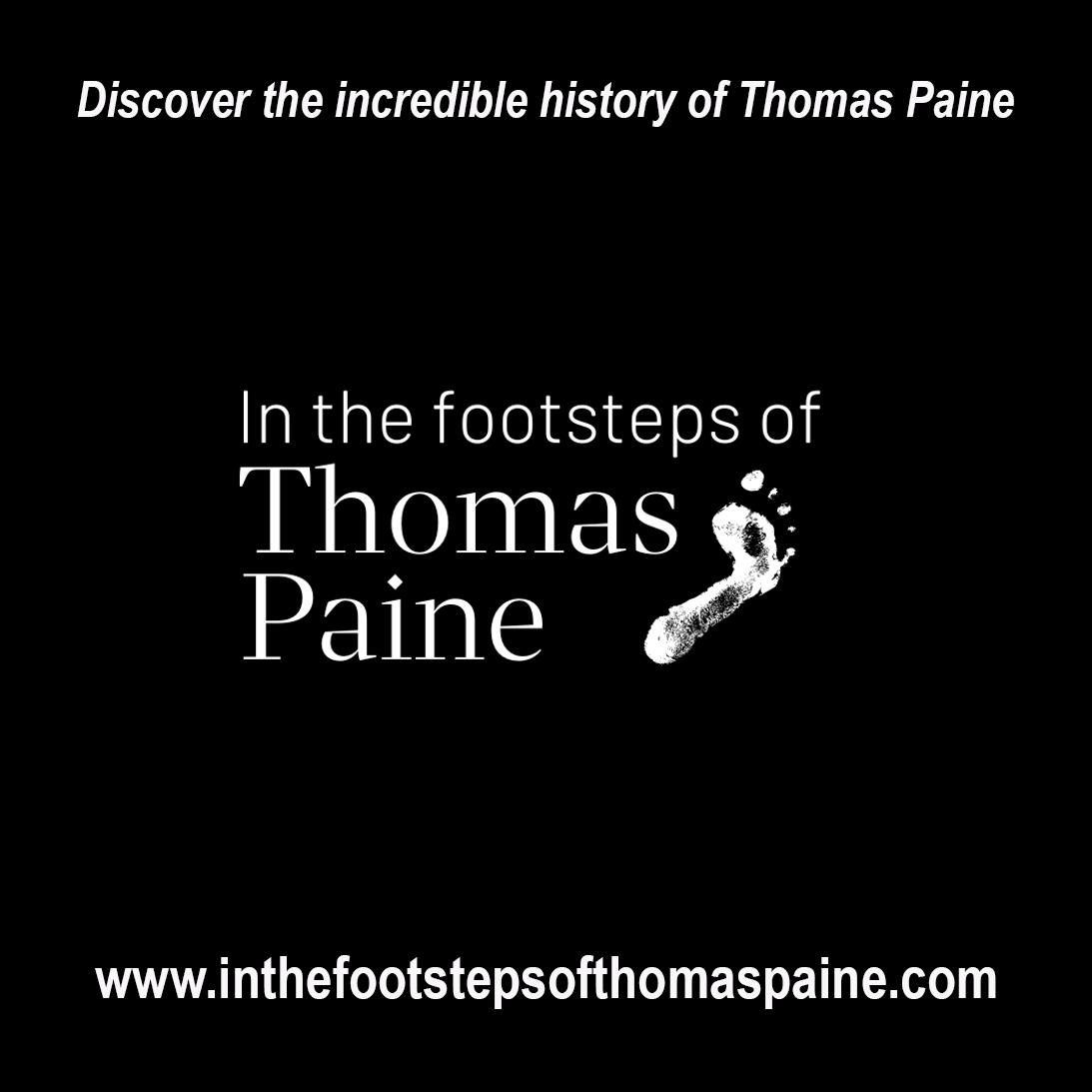

teacher. He had been boring and didactic with no flexibility for different learning styles. Rather than putting her off she had known there and then that she could do a better job. On her return to England after learning in a school in Holland she had supported her peers in their maths tasks. She had a natural affinity for teaching. She had also been a bit of a rebel; she wondered now how many of the teachers had turned a blind eye to the shenanigans of her and her friends. She did not just break the rules at school, she broke the mould with her choice of university degree. Her parents had suggested other subjects that she was good at, English, or languages perhaps. But no, she had chosen Astrophysics with only a handful of other young women. She loved physics, the basis of the world around us and the universe which we are still striving to understand. When she had become Head she had been determined to continue an active role in the classroom, passing on the joy of grasping difficult concepts and maintaining her own satisfaction of seeing the moment when they ‘get it’, in their own time and in their own way. The light in their eyes at that instant is what it is all about. She looked at the neat, raised beds and smiled to herself. She would be back tomorrow. She had promised herself some more time here after checking the school timetables for next year. She could see them all fully formed in her head, but she was learning to delegate and share responsibility with her talented team. The start of term would mean that she would have less time on the allotment come September but she had her special place at school too; sometimes in a spare moment she would play the piano – the same pieces she had been playing when she’d changed to singing lessons at sixteen but she knew them by heart and loved them still.
She clicked home the padlock on the shed door and picked up the raspberries she had harvested earlier. She tasted just one more on her way to the car, its flavour sweet and fresh in her dry mouth.
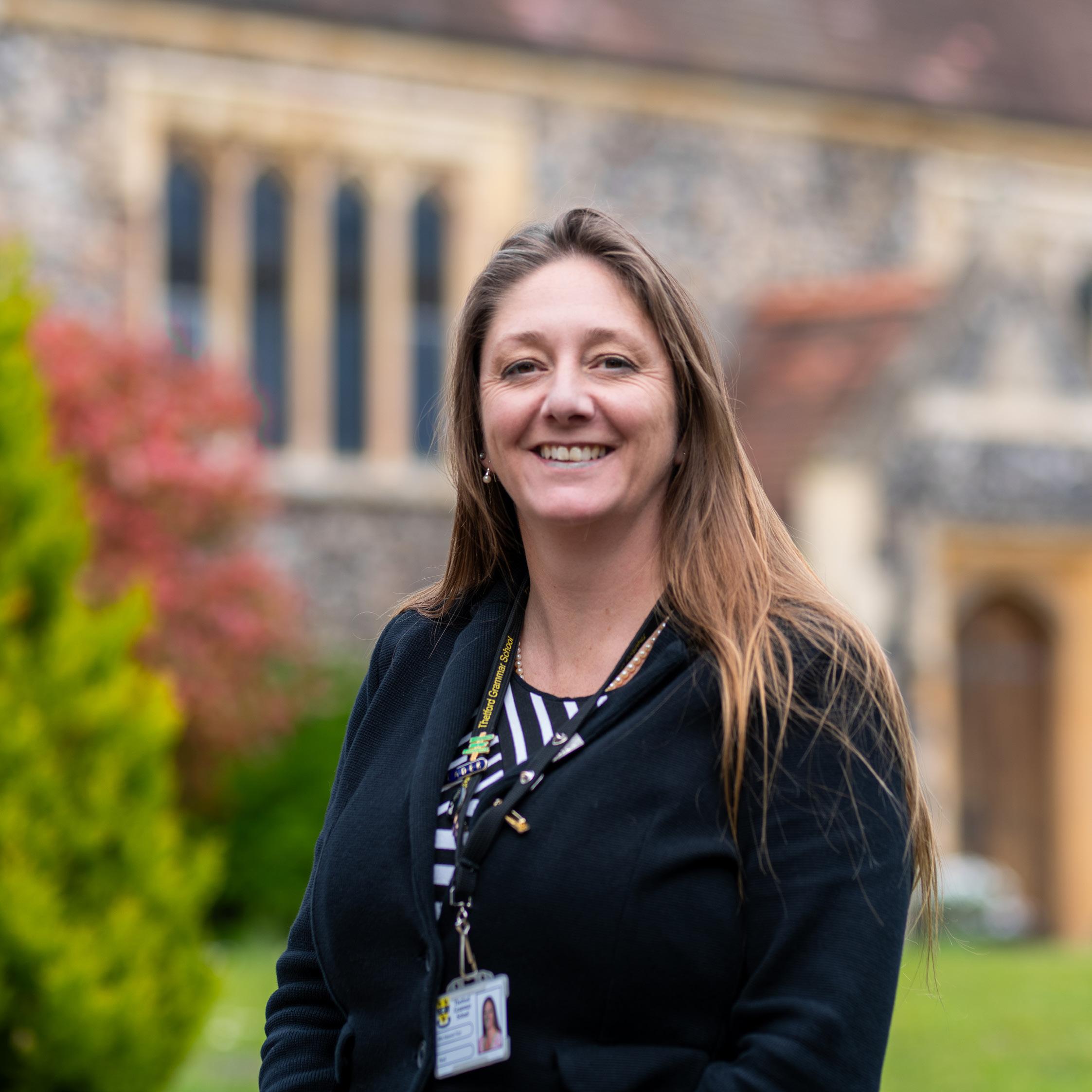
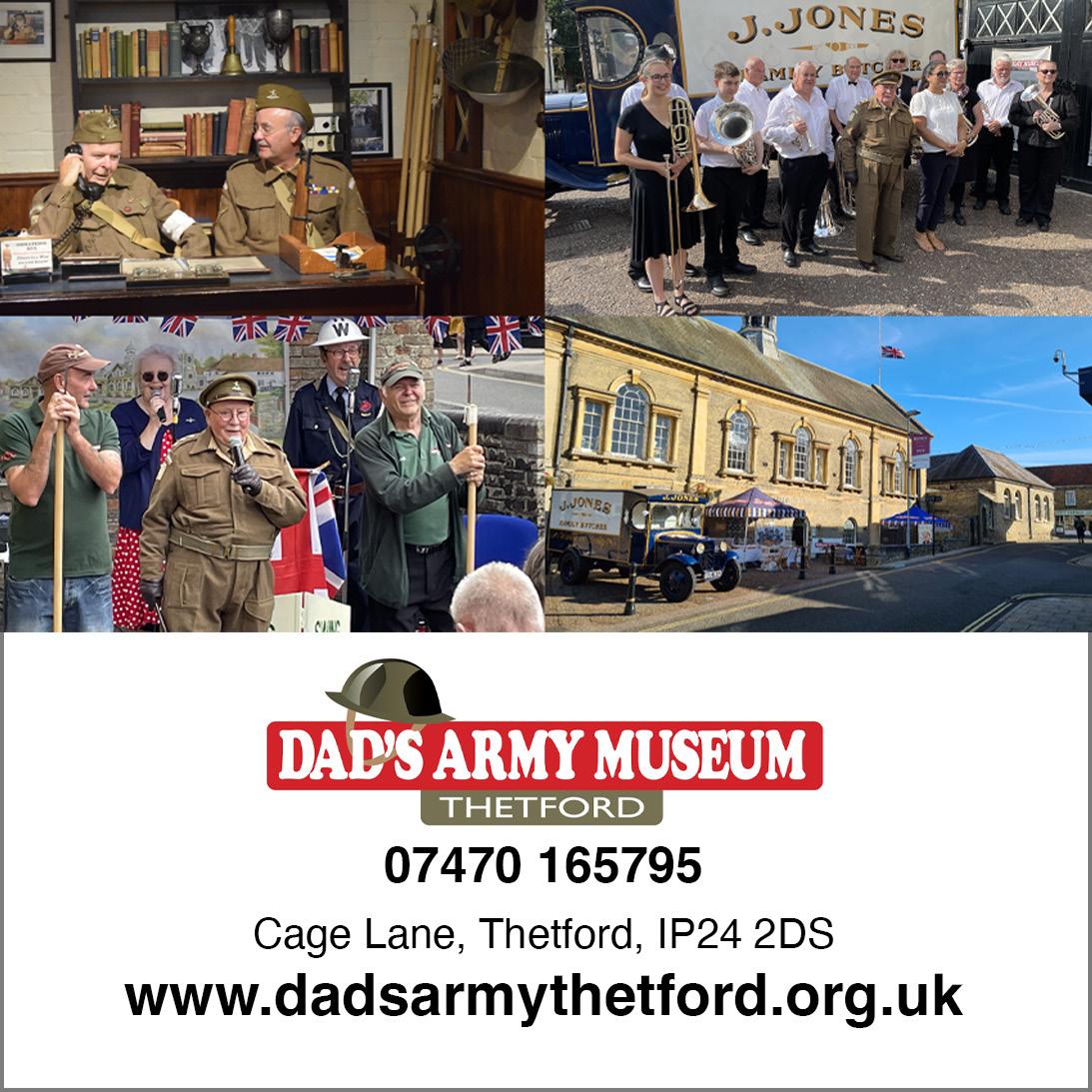
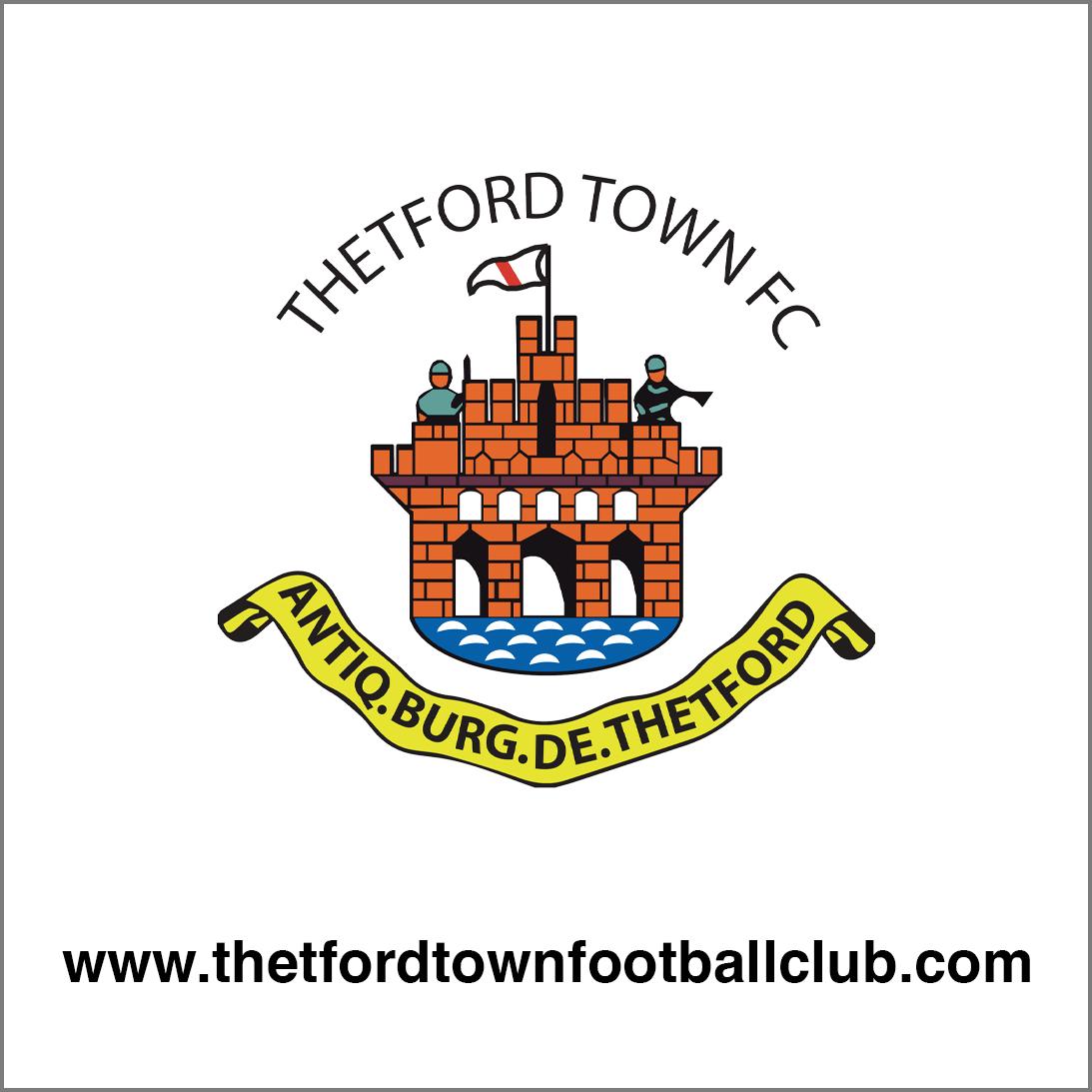




by Martin Angus
Iam not going to say this photoshoot was the easiest we have ever tried, what with working shift paterns and holidays thrown in the mix, but it was the weather that really scuppered our original plans.
Nevertheless, the amazing collaboration and team work, we pulled it off.
This time we thought we would give the ladies a rest and let the gents have a go at the modelling.
We were delighted to be allowed to use a few of the bikes in the Ivan A.J. Motorbike collection as props, along with a selection of jewellery from Chloe’s, which

is designed for men but can also be worn by the ladies.
The amazing ladies from Elite Hair and Beauty were on hand to make sure our model Jason looked his masculine best, also providing a most welcome and amazing boost of crazy energy first thing in the morning.
We had a team on hand to assist with the motorbikes, a big thanks to Bernard and Martin for their muscle.
We had fun taking the photographs on location here in Thetford, we hope you enjoy the results.
Ivan A.J. Motorbikes, Thetford, Norfolk
Chloe’s Jewellers, 13 King Street, Thetford IP24 2AN 01842 761100
Elite Hair and Beauty, 19A Station Road, Thetford IP24 1AW 01842 630923
Artistic Director - Tegan Beaney Model -Jason
Photography - Martin Angus c/o Bubbly Hub, Thetford
Photography and Motorbike Assistants - Bernard and Martin
Motorbikes used for the photoshoot
EEB209 1954 AJS 500cc Twin Cylinder, USR781 1959 200cc Triumph Tiger Club 824XUL 1953 350cc Matchless, HPW683 1947 500cc BSA B33, CSL828 1960 300cc Excelsior Talisman

by Martin Angus



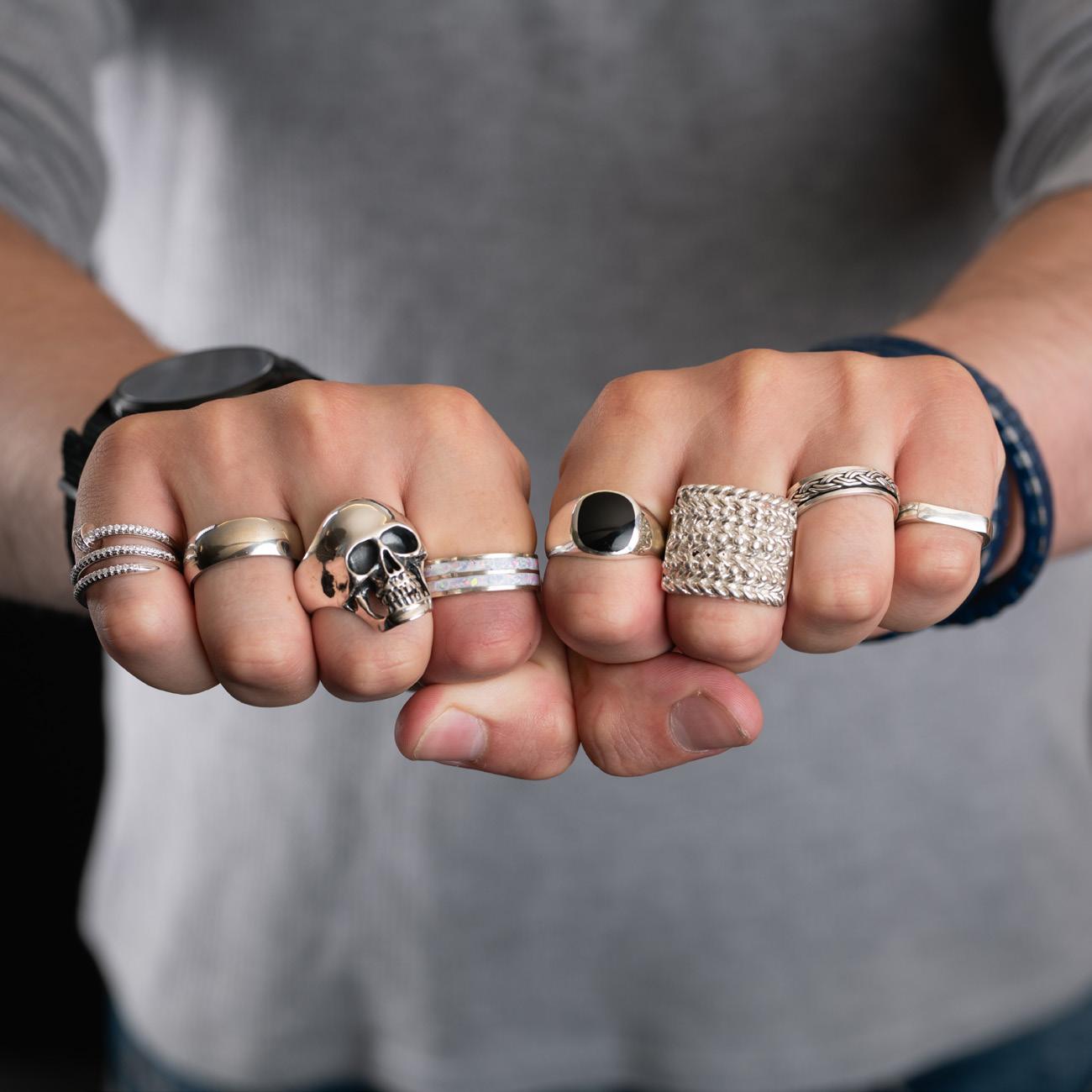
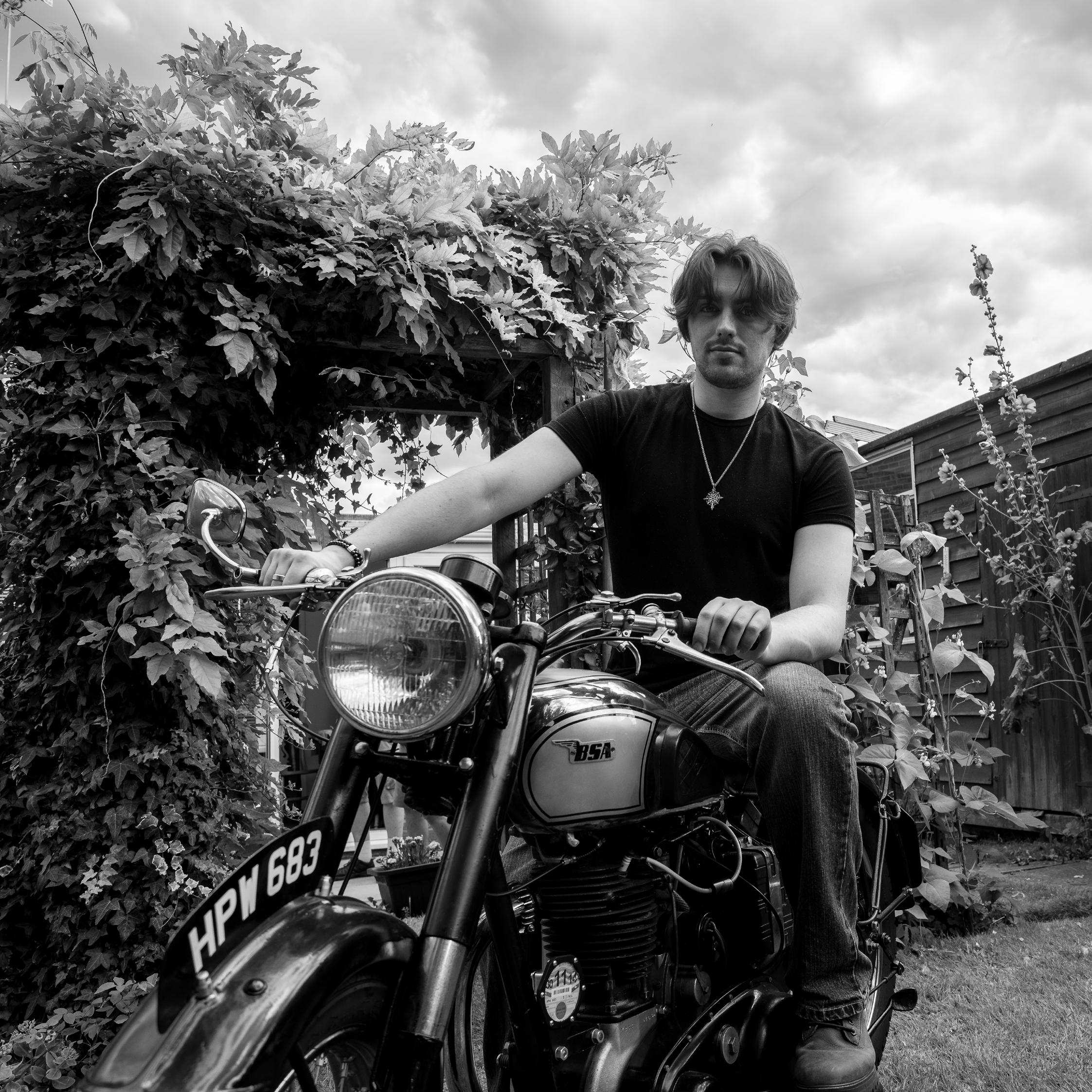

by Martin Angus









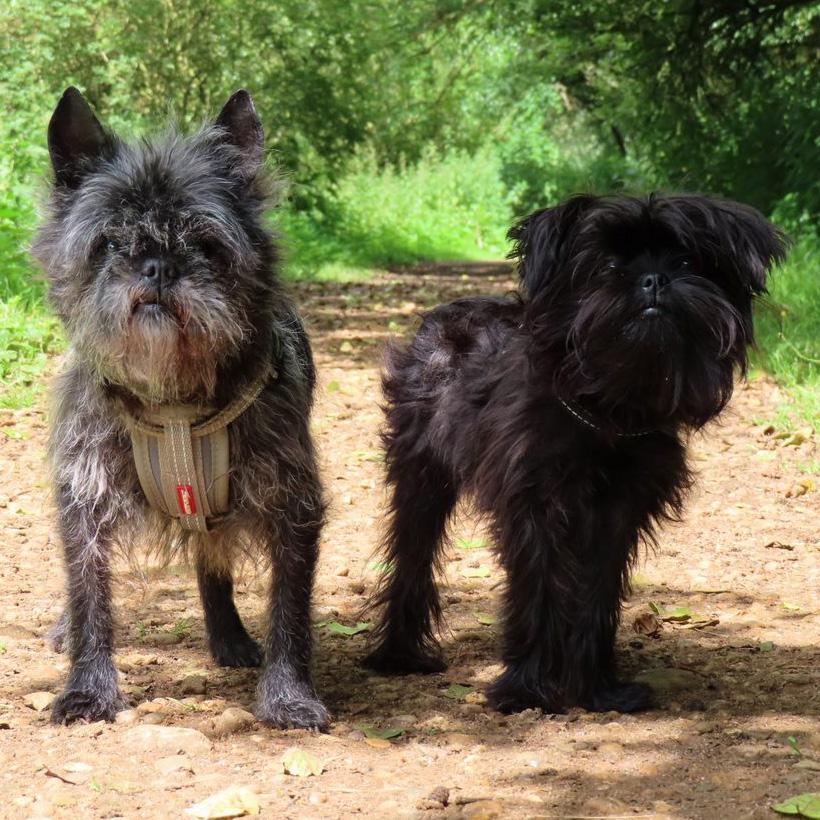
Written by Stephanie Downes
My name is Stephanie and together with my dogs Albert and Fergus I would like to share one of our favourite walks with everyone.
Thetford has some fantastic places to walk while enjoying the fresh air, and my dogs get the opportunity to exercise, explore and socialise too. This particular walk starts and finishes at the Market Place, it’s not too far for little legs and takes us around forty five minutes, there are also benches at various points along the route to rest on too.
The route
Start on the Market place and head down the length of Castle Street, passing Castle Park on the right. After crossing Melford Bridge over the River Thet

(Albert quite likes to stop off for a paddle here), turn right into Arlington Way where you will soon see some steps down to the river path, there is also access without steps a liitle further along Arlington Way.
The river path can be followed along to Ford meadow and this stretch of the walk is great for spotting nature such as muntjac, geese, swans, damselflies, bees and even the occasional egret or heron. The two enclosed areas of Ford meadow are currently being cut back less often to create wildflower meadows to create a habitat for our pollinating insects.
Exit Ford meadow and turn right, at the end of the footpath cross over Nuns Bridges Road and onto Spring Walk. this is a beautiful area of Thetford with lovely views of the river and Nuns bridges. Continue

walking alongside the Little Ouse river back towards the town centre.
When you reach the end of Spring walk, turn right, passing in front of the old coffee mill and arriving at School lane where you will see a footpath crosing diagonally across the car park. Take this footpath and keep right to exit School lane, alternatively you could stop off at the Riverside kiosk for some refreshments and a bite to eat, they even sell doggy ice cream and you might get to watch some paddle boarding on the river too.
Once you have left School Lane use the crossing to head up Well Street before arriving back at the Market Place.
Please see next page for a map of the route, enjoy.

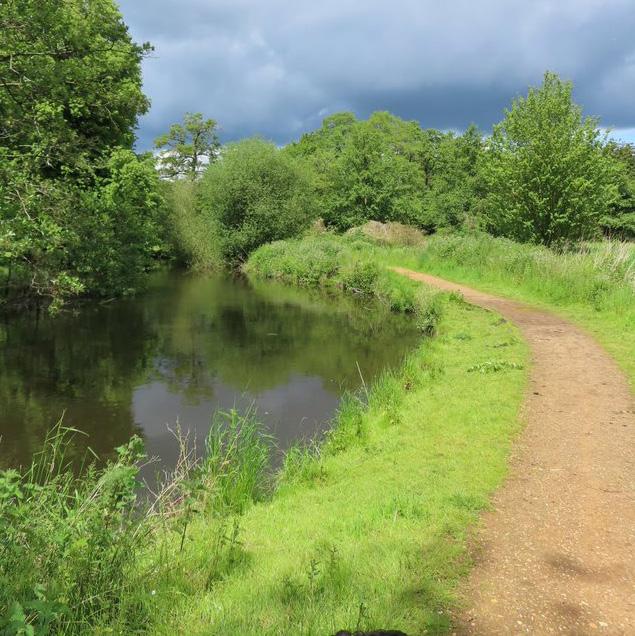
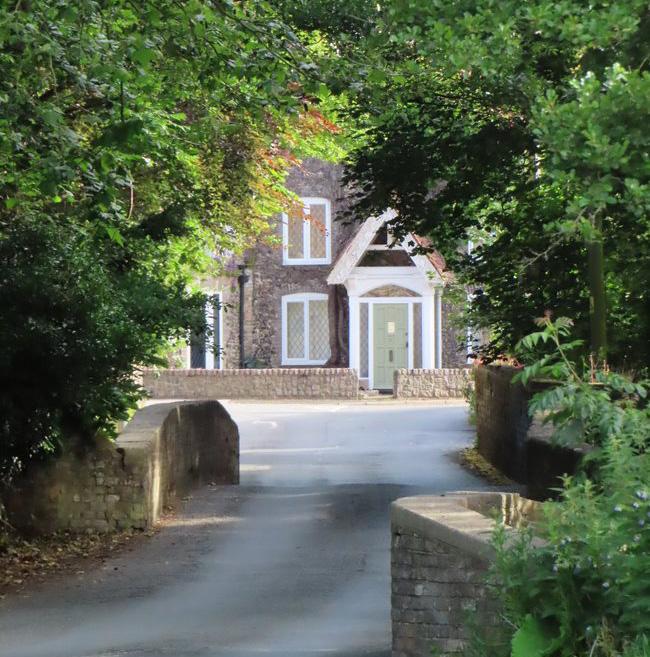




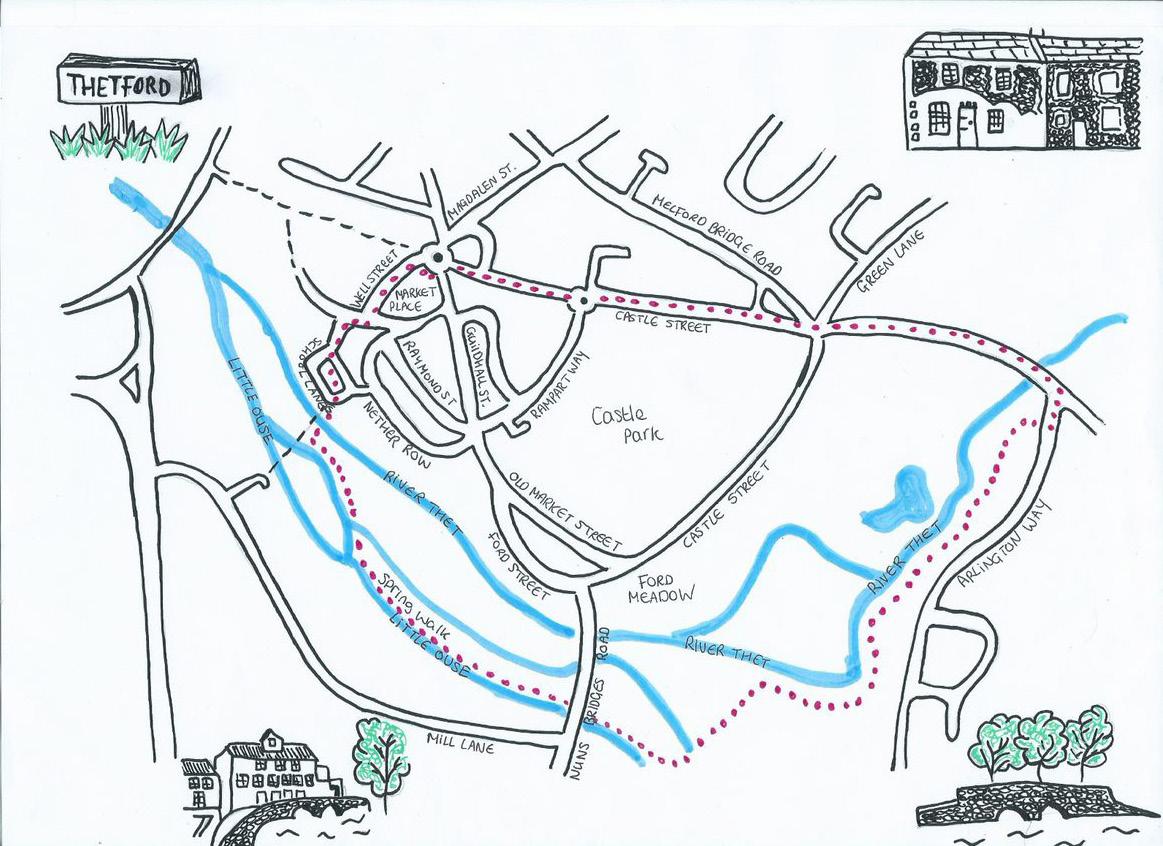
“One of our favourite walks.”
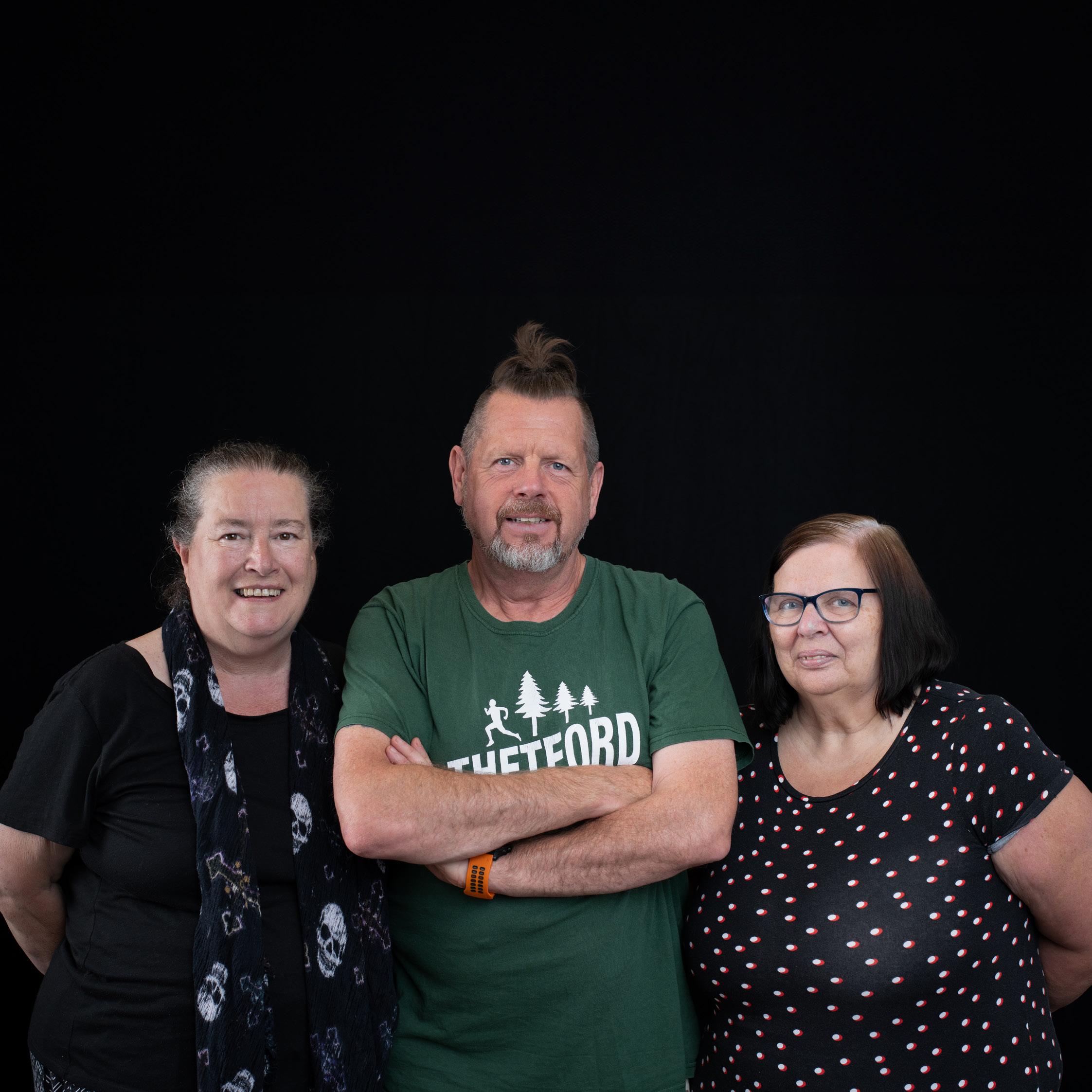

Written by Heidi Teixeira
One October morning in 2016, a post run chat between friends and fellow runners who were all disappointed they didn’t get into the London Marathon turned into the birth of Run Breckland - a local charity bringing the community together through running events.
The idea of Run Breckland came about when three friends, Graham Wade, Sharon Nash and Sue Colledge, were chatting to others who all had received the standard rejection email from the London Marathon, explaining they were unsuccessful in getting a place in the ballot, and so decided to do something for the local running community instead. “We wanted to give something back to the community that had given us so much,” said Sharon. “So, if so many local runners were disappointed not to get into the London Marathon, why not organise a 26.2 mile run right here in Thetford, on the same day as the London Marathon? And that’s when Run Breckland was born.”
Six months later, after lots of meticulous planning and organising, Run Breckland kicked off its first

event with the Breckland Forest Marathon in April 2017. It attracted 120 applicants of all abilities and that’s what makes Run Breckland favourable for the local running community - it doesn’t matter if you’re a seasoned runner or a first timer - Run Breckland is suitable for everyone.
Fast forward seven years and Run Breckland now puts on eight events a year, with many regular and new runners participating, offering everything from 2k events for families to trail Marathons and everything in between. They welcome those who want to run or walk as a family and make their routes suitable for anyone who wants to take part with a pram or pushchair. They have even seen one person do their 2k event on crutches!
In order to put on an event, it isn’t a case of just deciding a day and time and putting a post out on social media - there’s weeks of hard work leading up to it, which all three founding members spend their spare time doing to make it as enjoyable and safe for the participants as possible. “We liaise with corporate organisations, the police, landowners and the local
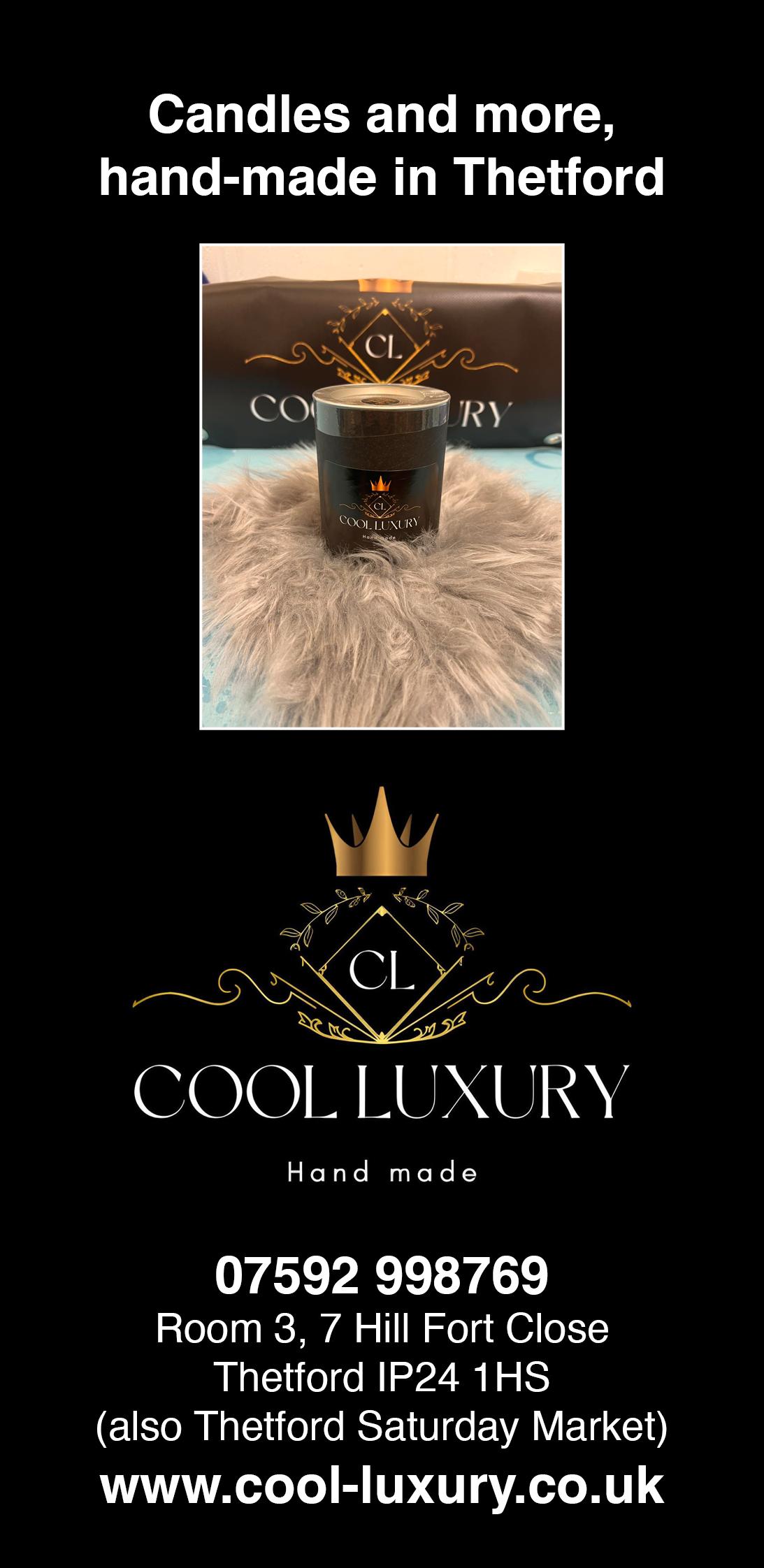



council every time we put on an event,” said Sharon. When the day of the event comes round, it’s a 6am start for the organisers and it can sometimes be a 12 hour long day. Sharon said: “We prep the food, load the van and put the signs up the day before. We set up at the venue on the morning of the event and once its finished we take everything down, pack the van up again, process the results, upload the photos and respond to social media posts. It can be a long day, but it’s all worth it to see the comments and photos that are posted afterwards - people hitting their personal bests, enjoying themselves and knowing they have had fun at a local event.”
So, who are the faces behind Run Breckland? Graham and Sharon met in London over 40 years ago. Sharon is Suffolk born and bred and Graham is originally from London. The couple met Sue, who has lived in Thetford most of her life, 12 years ago through work and have been friends ever since.
The trio have their specific roles: Graham is the Chair of the charity. The posters you’ll see are often designed by him. He’ll run the routes a few times beforehand to ensure they are safe and appropriate for the participants. As well as organising the events, Graham has taken part in all 31 of them! Sharon, one of the Trustees, does a lot of the behind the scenes admin, social media and organising. “I’ve always been an ‘organiser’,” said Sharon, “Run Breckland keeps us all busy and keeps Graham running!” Sue, also a Trustee, is responsible for anything number and financial related, drawing on her experience as the Treasurer for Thetford’s Bowls Club. Sue said: “Starting Run Breckland has been a learning curve for us all. We’re always learning as we go along.”
Reminiscing about how Graham got into running, he said: “Sharon and I moved to Thetford from London in


2004, but I didn’t start running until a few years later. I joined a gym and ran on the treadmill. I then found out about Thetford parkrun through the Thetford Council website. I gave that a try and haven’t looked back. I’ve made so many friends through parkrun and the general running community in Thetford.”
If you’ve ever taken part in one of Run Breckland’s events, you’ll notice how relaxed and friendly the atmosphere is. “We try to make it as inclusive as possible for everyone,” said Sharon, adding: “We want to make it social and encourage participants to stay and mingle afterwards, have a drink and something to eat. Everyone turns up in their running gear and you might not know who they are or what their background is, but they’ve all got one thing in common: running.”
All three founders of Run Breckland describe their events as ‘entry level running’. So it doesn’t matter if you’ve never run before, or if you’ve never ran with people before - you’ll be welcomed by Run Breckland. Graham said: “It’s common for people to be nervous before an event. Not knowing the route, not knowing other runners or worrying that they may not be fast enough are often concerns from first timers. That’s why we open up registration an hour before the event starts so we have enough time to talk to anyone who may have questions.” There’s also no cut off time for any of their events, which is reassuring if you’re a new to running. However, that doesn’t mean experienced runners can’t and shouldn’t join in. The longer distances are chip timed, and finishers receive a top notch bespoke medal,
Over the years, Run Breckland has witnessed some remarkable progress in their regular runners’ distance capabilities, largely due to the supportive community they’ve built. Graham
added: “We know people who previously had only ran 5k and now they’re running our half marathons!”.
Run Breckland is more than just running. It’s about forming friendships, networking and encouraging people who like to run to take part. Their slogan, Running for the Community, is a reflection of everything they do. Sharon said: “Community is definitely important to us. We charge little compared to a lot of other running events to make it affordable for everyone, particularly if you’re running as a family which can otherwise become expensive by the time you’ve paid for everyone to take part. We encourage parents to bring their children along and run together and it’s lovely to see.”
In fact, it’s the Run Breckland community of runners who have helped them grow the number of events they now put on. Graham said: “When we talk to participants after the event, they often come up with ideas of what we should do next! That’s how our Santa Run came about - someone had suggested we put on a Christmas themed run. After our first Santa Run, we thought we couldn’t have a Christmas themed run and not an Easter run, so that’s how the Bunny Run was born!”.
Sue said: “I love seeing friendships form and people accomplishing something at our events. I enjoy encouraging everyone who is taking part. When I first took part in parkrun I remember how I felt when the volunteers encouraged me to keep going and believed in me and that’s how I want others feel when they take part in our events.”
And it’s not just Run Breckland the trio are involved in. All three often spend their Saturday and Sunday mornings volunteering at parkrun. Graham and Sharon have been Run Directors at Thetford parkrun for six
years, and Sharon is the Event Director at Thetford’s junior parkrun. Sue is a regular volunteer at Thetford’s parkrun and junior parkrun, along with her husband, daughter and granddaughters
Doing it for the environment
Run Breckland pride themselves on being sustainable. They encourage participants to bring their own water bottles which can be refilled, or to use the reusable cups provided, rather than promoting single use plastics.
Since 2021 they have also been involved in JogOn - a charity whose aim is to remove one million pairs of running shoes from landfill by repairing, repurposing and recycling old trainers. Run Breckland often have a collection point at their events where participants can drop off their old trainers and then they’ll be boxed up and sent to the charity. Graham said: “Runners can quickly get through trainers and although they might not be good for running any more, there are people who would make good use of those unwanted running shoes.”
All of Run Breckland’s events are supported by The Brecks Fen Edge & Rivers Landscape Partnership Scheme (BFER). The new Landscape Partnership scheme, backed by over 60 local, regional, and national organisations, aims to conserve and celebrate the distinct heritage of the Norfolk and Suffolk Brecks. Graham said: “The BFER want people to use walking routes throughout Norfolk and Suffolk, so they’re delighted that some of our events are taking place on these. It will hopefully encourage those taking part to go back and explore the area.”
In September 2024 Run Breckland will be leading three free guided runs in partnership with the BFER as part of the Brecks Outdoor Festival. There will be three distances - 5k, 7.5k and 10k, all on multi
terrain, to encourage those who have only run short distances to increase their running distance bit by bit.
When the pandemic hit in 2020, all of Run Breckland’s events had to be cancelled. This meant refunds to all participants and they were left with lots of medals. However, they took the situation in their stride and launched virtual runs instead, charging participants the price of the medal. It meant those who took part were still able to do their run at a time and place that suited them and they still received a medal for it. Sharon said: “I’d like to thank everyone who took part. All our runners rescued us which was brilliant.” When things gradually got back to the ‘new normal’ after lockdown, Sharon said: “It was like starting from scratch again. It was a struggle to get restarted, but we have an amazing volunteer squad who helped make our events happen again.”
As Run Breckland continue to go from strength to strength, they are hoping in a few years time they will be able to help the community even further by offering grants to local organisations and are looking to invest in some new equipment for their own events. Graham has completed his Leadership in Running Fitness certification, a UK Athletics coaching qualification that will equip him to lead and coach group runs, allowing him to share his passion for running with others.
There are still seven events scheduled for the rest of the year, including the ever popular Santa Run in December. Sue’s favourite, she said: “I love the Santa run. Nearly everyone dresses up in such good costumes. It’s a family event for me with daughter and grandchildren taking part.”
Reflecting on all of the events they have put on, Sharon’s favourite is the Euston Marathon: “It’s very

by Martin Angus

laid back, we have time to talk to everyone and there’s always a nice atmosphere”.
Graham’s most memorable event is last year’s Sapiston 5k and 10k Trail Runs: “This event ended up being so unexpected. Last October it didn’t stop raining for weeks and the river on the route (the Black Bourn) had burst. We kept checking the route in the days leading up to the event and we were prepared to postpone it if need be due to the weather. However, on the day the weather went from one extreme to the other. The sun came out and it ended up being a gorgeous day. It was a brilliant day in the end and we received such positive feedback.”
If you’re interested in taking part in any of Run Breckland’s events, you can sign up to them here: https://www.ticketsource.co.uk/run-breckland. You can see what they’ve been up to on social media and give them a follow on Facebook, X, and Instagram too!
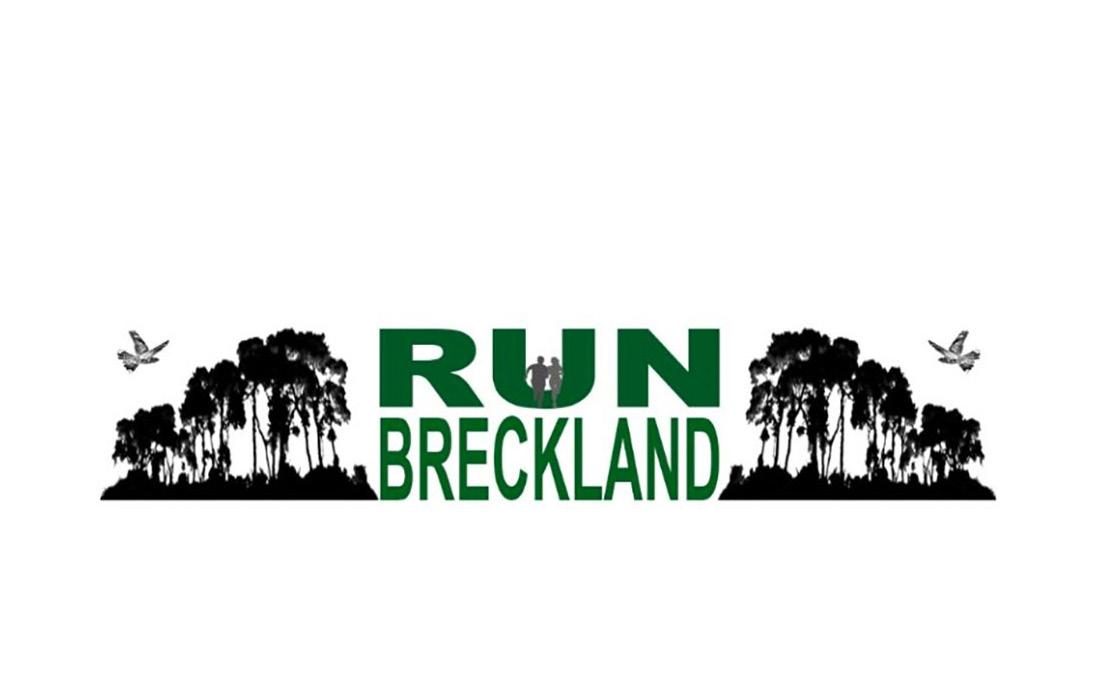
www.ticketsource.co.uk/run-breckland
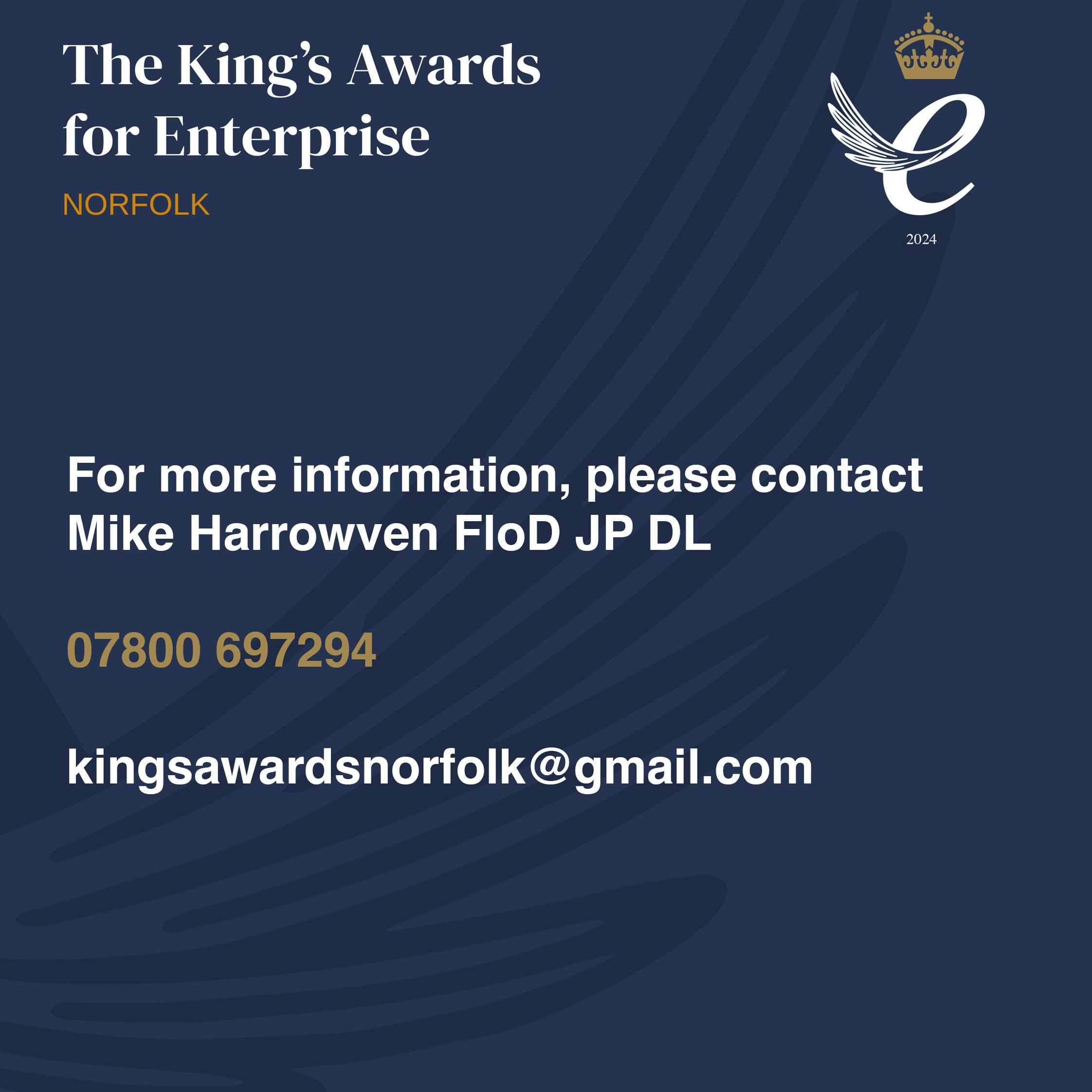


Written by Rita Thompson
Could you be over feeding your cat? As with us humans, it is not healthy for a cat to be overweight. It can put a strain of their joints and cause problems such as heart disease and diabetes. Cats should not be given ‘human food’ as most of it is very high in calories. For example, 30g of cheese is equivalent to 4 burgers for humans. 100ml of milk and 45g of tuna is equivalent to 2 burgers! Even 25g of chicken or ham is equivalent to one burger.
If you are unsure whether your cat is overweight a simple guide is that you should be able to feel your cat’s ribs easily when you stroke their body lightly and you should clearly see a waistline when you look at them from above. Overweight cats are usually defined as being greater than 15 per cent over their ideal body weight, while the term obese is used for cats that are 30 per cent above their ideal weight. Cats under two years of age are less likely to gain weight. Between two and ten years, cats use up less

energy so are more at risk of becoming overweight. Senior and geriatric cats aged 12 years and over, have a tendency to be underweight.
Most vets have a ‘diet clinic’ whereby your cat is weighed and if overweight, you will be advised on the amount of food they should be given. Overweight cats should never be starved or put on a ‘crash diet’ as any period of no food can very quickly be harmful. A gradual, steady decrease in bodyweight is ideal – it may take up to a year for a severely overweight cat to reach its ideal body condition. So please be advised by your vet.
It can be difficult to manage a cat’s weight in multicat households – any household with more than one cat. Some cats will happily finish anything the others do not want. Feeding the overweight cat in a separate room can give the other cats in the household some time to eat. Any leftover food should be removed before the overweight cat is let out of the room, so
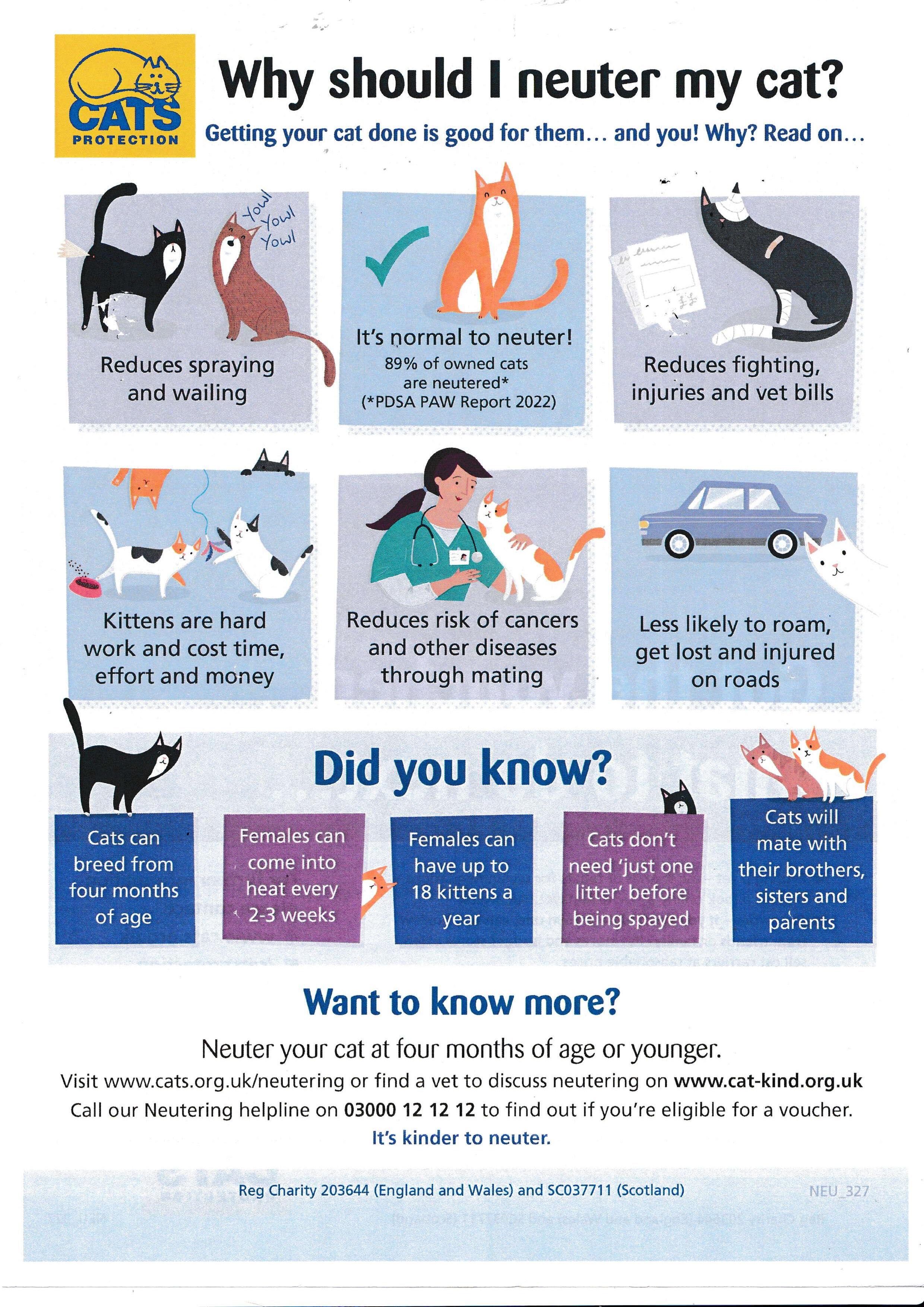
that it can’t be finished off.
Providing the overweight cat with a toy that slowly releases food can help to increase the amount of time they spend eating and give them a little exercise. Because exercise is such an important part of weight control, indoor cats are particularly prone to obesity and it can be a manifestation of stress. It can be useful to look at your cats lifestyle, its environment and placement of resources as well as diet.
Did you know that cats and dogs can be blood donors to other cats and dogs? For cats the criteria to be a blood donor is that the cat must be between 1 year and 8 years old, and weigh at least 4kg. They should preferably be in indoor cat, otherwise they must be Feline Leukaemia and Feline Immunodeficiency Virus negative, be up to date with their vaccines and flea and worm treatment. They must never have been outside the UK and not be on any medication. They must be of good temperament and be easy to handle.
They will undergo health checks for heart murmurs and haematology and biochemistry
blood samples will be taken for analysis to make sure they are completely healthy.
In cats there are 3 different blood groups – A, B and AB. Most domestic cats are group A, along with all Siamese cats. Pedigree cats are predominately group B.
To take the blood, the cat will be sedated and the blood will be taken from a vein in the neck. About 55ml of blood is taken, and then exactly the same amount of electrolyte solution will be administered to the cat, to protect its blood pressure.
For dogs the same criteria as for cats apply for them to become blood donors. 1 – 8 years old, weigh more than 25kg, be up to date with their vaccinations and flea and worm treatment, not be on any medication and never to have been outside the UK.
There are 2 blood groups in dogs - DEA1 Negative and DEA 1 Positive. 30% of dogs




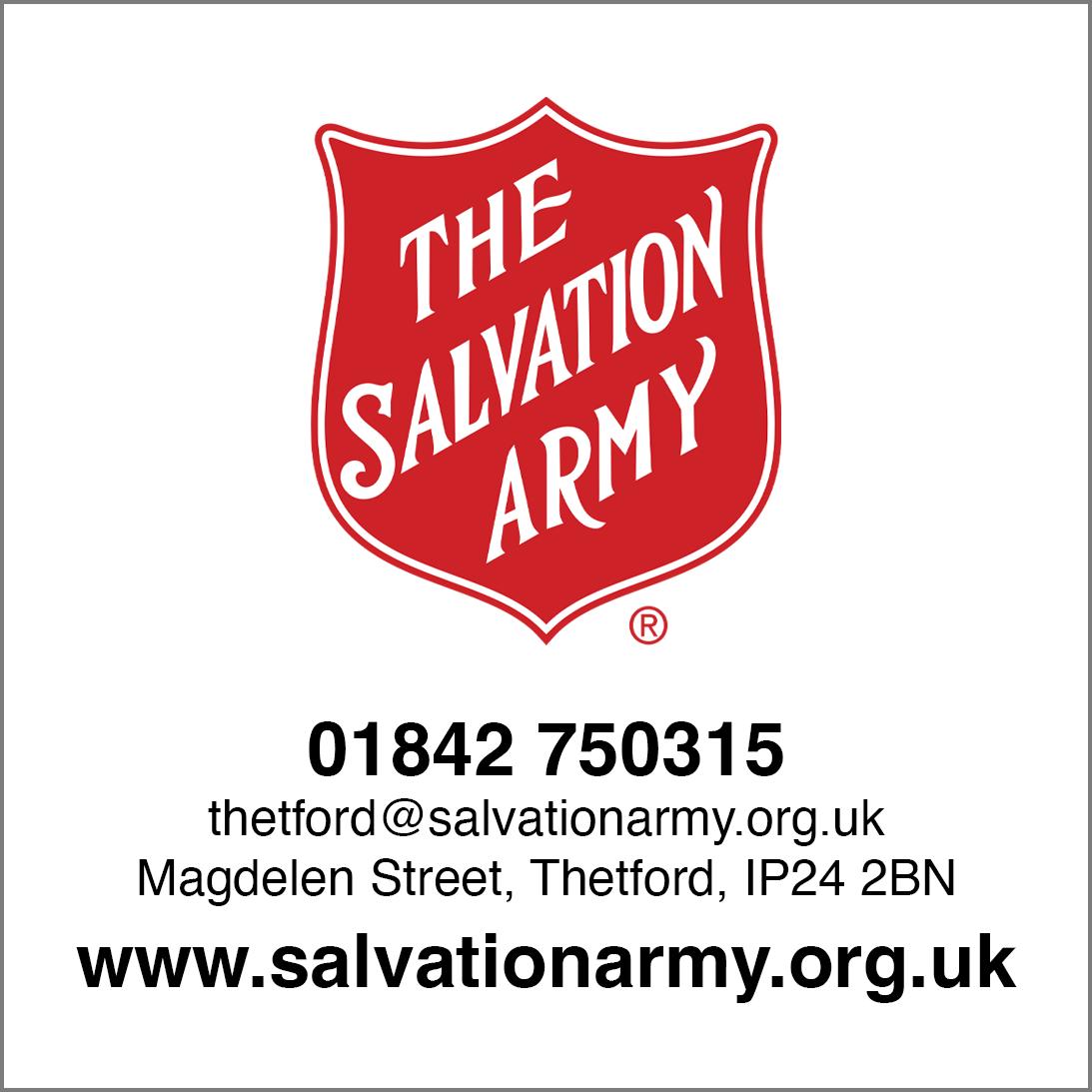
are negative so they are the universal donor as negative blood can be given to positive dogs, but not the other way round. Large dog breeds are used, especially Greyhounds. Other breeds used are Dobermans, Boxers, German Shepherds, Retrievers, Airdale Terriers, Weimaraners, Lurchers, American Bulldogs, Pointers and English Bull Terriers.
The reason a cat or dog may need a transfusion are numerous. Some of the more common needs for a transfusion are, anaemia, ruptured spleen, surgery when there is a large blood loss, rat poisoning, as this causes internal bleeding, trauma, such as road traffic accidents, sepsis, cancer, kidney disease, infections and auto immune problems.
The red cells of blood cannot be stored for longer than 35 days, and then in a temperature controlled fridge. However, the plasma part of the blood can be taken off and stored in a deep freeze for up to a year. The plasma contains all the clotting factors and is used for animals who have a problem with their blood clotting. There are few transfusion centres in the UK for animals, so most vets keep a list of dog or cat donors, and call on them when there is an emergency, As in humans,dogs and cats can give blood every 3-4 months. If you would consider your dog or cat to be a blood donor, speak to your vet.
For advice or information, or if you require help with the cost of neutering, please call us on 01842 810018,

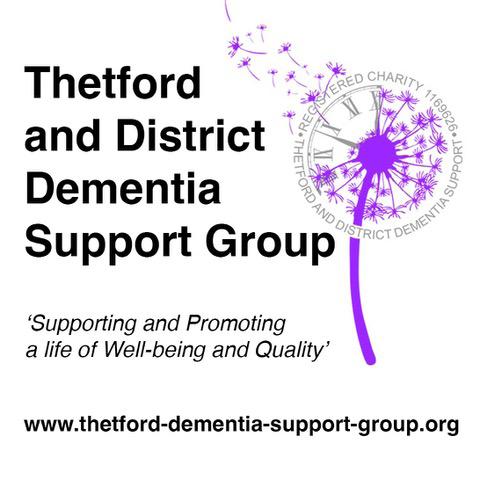
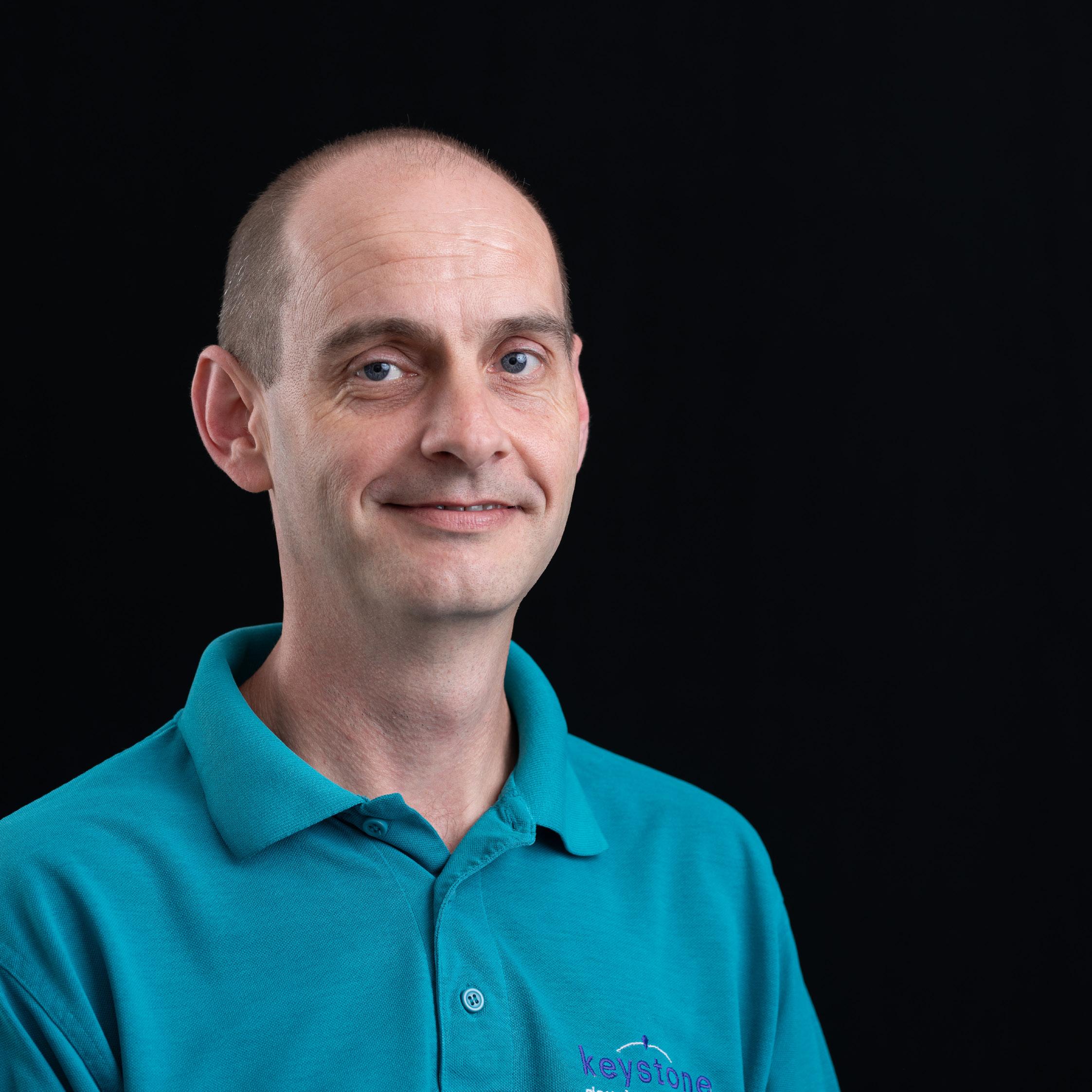
Ricky ‘Keystone ‘ Aylott

Written by Joanne Lock
Ricky felt that he left school with very little, was ill prepared and wasn’t sure of the direction he wanted to take in life. Until, one day the young father of three very young kids was standing outside the school gates playing with one of his children when the head teacher came out, saying that they were short staffed and could he come in and help out during lunch. Ricky joked about not wanting to be a dinner lady and after the head explained that the work would involve looking out for the children in the playground during lunch and maybe playing a few games, he agreed to give it a go.
It was only meant to be a few weeks work, but it fitted well with family life and weeks turned into months and then months into years. Working at the school Ricky discovered his purpose and a direction became clearer. As a father with a young family he understood and empathised with the difficulties and challenges that families face that could lead to a bad start to the day for a child and how these created barriers to learning. With the affinity he felt he saw that for

education to be effective and to enhance a child’s experience of learning a holistic approach to looking and supporting families as a whole was needed and he found that he was good at working with both children and parents.
After six years at the school, Ricky needed a change, he wasn’t sure what but what he did know was that he had got the bug for working in the community.
The answer to his question of what next came as he walked past the community centre on the Abbey Estate and wondered why it was always closed. Just before Christmas 2007, Ricky called the number on the board outside the centre and by February 2008 he had taken secondment from the school to open a community cafe in the centre and also worked as a youth worker for Keystone. A year later he returned to his work at the school.
Ricky left the school after spotting a vacancy for a casual caretaker at the Abbey Estate working for


Keystone. Unlike some people who would just carry out their work, go home and not think too deeply about it, Ricky, as he had done when working in the community cafe, observed everything that was going on around and thought about how things are done.
He was then promoted to Communities Manager.
One day he was invited to a trustees meeting where he was offered a promotion to become Chief Operational Officer based at Riversdale working alongside his excellent team: Alison his deputy, Toni - Communities Manager, Jane in finance and Julie who manages the community centres at Brandon and Mildenhall.
This relatively small team does and has achieved a lot and with his promotion Ricky got his wish to be able to make a difference. After years of observing everything around him whilst carrying out previous roles Ricky realised that the first thing he needed to do was to define a clear and simple role: to manage community buildings and to support projects and groups through facilitation, mentoring and encouraging networking with similar groups.
By supporting, empowering and encouraging similar projects and community groups to talk to each other ensures that nothing is duplicated which results in money and resources such as people not being spread too thinly and enabling self sufficient and long term sustainable community facilities and centres to remain open. Avoiding loss and closure of these vital facilities which offer a lifeline to many, is key as the Abbey Estate is ranked in the top 7% of most deprived areas in England struggling with challenges such as worklessness, poor health and wellbeing, social isolation, lack of access to healthy food, fly tipping, anti-social behaviour, poor connections; the estate is poorly connected to areas that provide outlets for wellbeing such as the river, Thetford Forest and the
This year Ricky has concentrated his focus on financial sustainability and is looking at ways for community spaces to generate income and to become self sufficient and self funding. He hopes to develop a model and set an example to other local authorities to ensure that community spaces throughout the UK are not lost and instead continue to survive and thrive.
Examples of this model are two houses which are adjacent and belong to the Mildenhall centre are rented out and this income is used to fund the community centre. Discounted rents on some Keystone spaces are granted to community initiatives such as the Citizens Advice Bureau, Thetford Boxing Club who provide a focus for kids and keeps them off the street and Grow Kids who provide free clothing for 0-11 year olds who didn’t have a proper space and ran the initiative from a cupboard.
Both the team at Keystone and the community groups are able to achieve bigger and better projects by avoiding duplication and not reinventing the wheel. This has allowed opportunity to be spread to start up businesses which provide a boost to the local economy and with their progression potential generation of employment opportunities. Mama D’s cafe started off on the Abbey and has now opened in the town centre at Riversdale. Backyard Bites has just been given a year’s lease at the Abbey Neighbourhood Centre, previously they operated the business from a trailer. The application process creates a buzz around the centres as the community is interested about who will be moving in next, it encourages footfall into the centres and enables people to discover other activities and initiatives the centres have to offer.
So much has been achieved through networking and collaboration between the community initiative groups


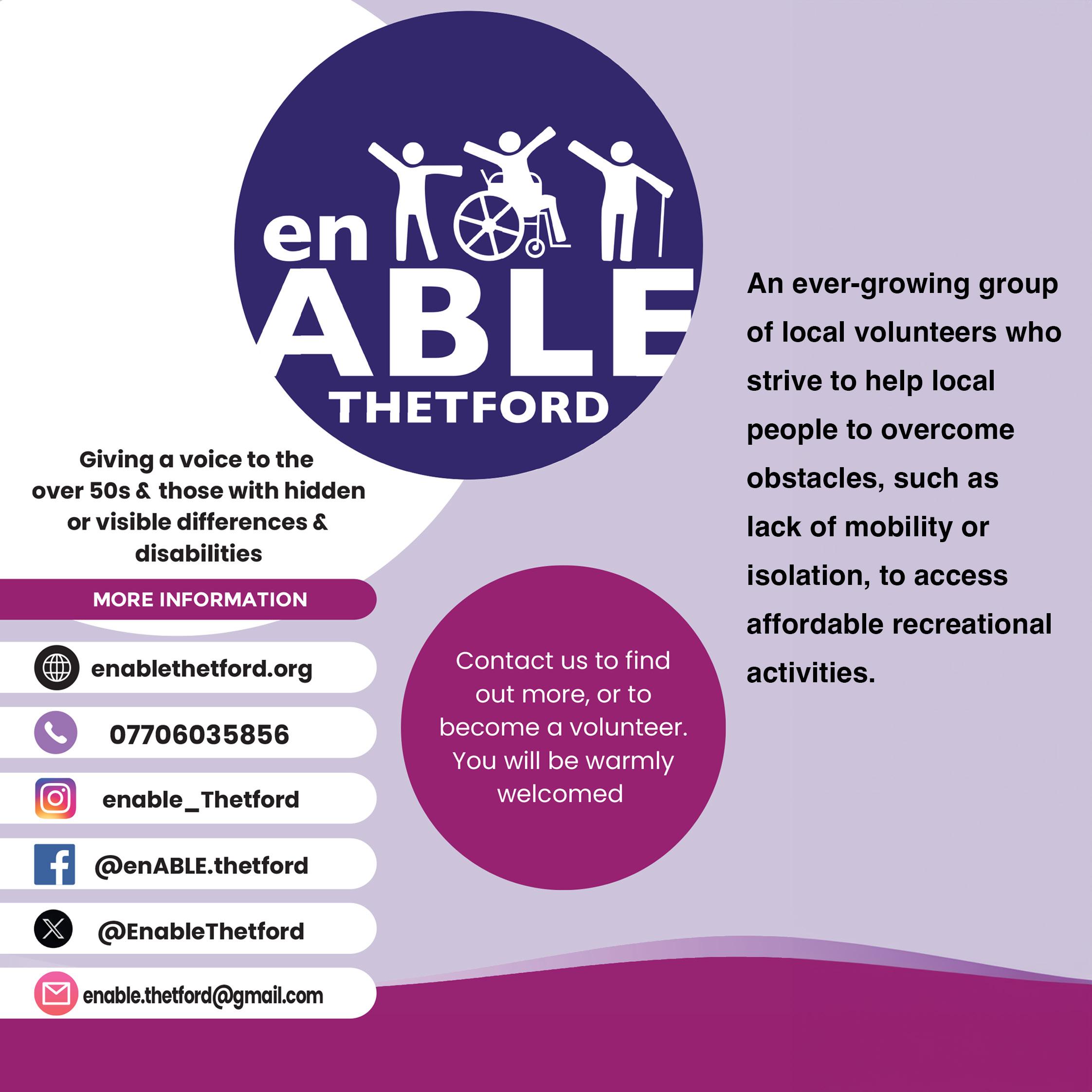
with the support of Keystone including: prescription collection service during COVID, the well used community fridge at the Abbey Estate, the Riversdale annexe providing washing, drying and shower facilities for both rough sleepers and others who are struggling during the cost of living crisis and the Breckland funded commission for a collaboration between Keystone and Magic Floor Productions highlighting the issue of county lines and young people. Riversdale hosts the weekly veterans and knitting group to reduce loneliness and isolation.
Where next? There are still plenty of plans in the pipeline. Rickshaws have proved a success in Bury St Edmunds as a great way to help isolated people get out and about and a Thetford rickshaw and booking system is currently being piloted by enAble and Keystone with the local care homes with the long term goal of having a minibus to help people get out and about around town. Keystone are talking with Dove Nest Ministries who provide up-cycled and free furniture to those in need about moving into one of their spaces. The previous county lines shows were well received by years 5, 6, 7, head teachers and SENCOs and a further show has been arranged for October. The knitters are busy knitting poppies for a Remembrance Day display. Ricky and his team are also hoping to start having regular community meals at Riversdale and is hoping for support from local food businesses to cook the meals, this would be an ideal way to offer further support to the annexe users and would also provide an opportunity for anyone that is unemployed to build up front of house, customer service and serving skills and to gain confidence to move into paid employment.
Community centres and groups have and are having to close due to lack of use and we can all play our part to keep things going by participating in the various groups and activities, visiting the startup cafes that are based in the community centre and volunteering.
There are a number of volunteering roles at Keystone like driving the rickshaw. Keystone appreciates that volunteers are the lifeblood and without them community initiatives and the support of others would grind to a halt. In recognition of this there is a volunteer reward package in place and if any volunteers have an ambition that is either connected or unconnected to their volunteer role support is offered to provide training and / or qualifications to help volunteers realise these ambitions. If anyone is interested in volunteering please contact Alison at Keystone on 07786 363499
As the saying goes, a change is as good as a rest and for Ricky and his team everyday is different which explains why Ricky appears to have boundless energy and enthusiasm for what he does and with Keystone supporting and empowering community initiative collaborations everyone is working smarter, not harder to achieve more for Thetford.


Written by Seraphina B
Shockingly, according to research, only 16% of Autistics are in full time employment, and another 16% are in part time employment. Overall it is stated that only 51% of disabled people are in employment, however this does show that Autistics are at a much bigger disadvantage, and that only 30-40% of Neurodivergent people are currently employed. It is not for not wanting to work, or lack of ability, far from it! Not all with Autism/Neurodivergent are able to work, however, 77% of unemployed Autistic people want to work (Autism Employment Gap Report). If anything I would say you are at a massive advantage to employ Neurodivergent people. Why is this? Often they have some very valuable skills which can be applied to the workplace, especially if these skills are of a special interest to the person. Good at seeing things others can’t, or don’t, good at detail, good at sticking to routines and timetables, so more likely to be punctual and reliable. We like logic and rules (providing they are logical and make sense or we may question them).
Many Neurodivergent don’t like to lie or see the point of it, so you will have a very honest employee. Everyone has different skills but for myself I like to have a job well done. I want to do the best I possibly

can, so I will learn and train in my own time, to enable me to try and do this for whatever it is that I am doing. I may not always get it correct but this is what I will do. My last job I went around all the different manufacturers and learnt how the products worked so I was able to get the best for the person having them, so they would work best for them. No one else did that. I am also shocked whereby in some jobs, you are in a position where you need to do the best you can for another person, and yet their knowledge on the subject is so little. I think to myself, how are you in that position? I have come across this a lot with people working with ND people, they just have not got very much knowledge on the subject, that to me is scary and to be honest sometimes dangerous. I think this also ties into employment as when researching it is very clear that the understanding of Autism and Neurodiversity is just not there. If it was, I do not feel there would be so many barriers towards working. It really saddens me when I see the statistic that only 27% of 601 employers said they did not feel an Autistic would fit into the team, and 31% of these thought they would need too much support. We have many a skills, however, one of the issues for us can be that it can be a struggle to take these and then apply them to real life, ie out of the classroom.
We can do this but sometimes we need a bit of guidance, and unfortunately the support to help transition from school/university to life and work is only at 33% (this is based on feedback from councils around the country).
Sometimes it can be our sense of justice, or our logical way of thinking (I like to call this very clear and concise thinking as it is a more positivedescription) that can get us fired. So for myself, if I see something wrong, more times than not, I will have to do something. I won’t stop to think about the consequences to myself so therefore I will report something that I see wrong in the work place. I did this once and the lash-back I got was terrible as they didn’t feel it was such a big thing, but in my head I believed the rules were not followed and could have been dangerous. In the end I had to leave the job as my anxiety got so bad with the situation. It has been shown that Autistic and Neurodivergent candidates demonstrate above average skills in some, or all of the following areas (taken from National Autistic Society)
• High Levels of Concentration
• Reliability, conscientious and persistence
• Accuracy, close attention to detail and ability to identify errors
• Technical Ability
• Detailed Factual Knowledge and an excellent memory
I know for myself I have an ability for detail with certain things, especially the things I am really interested in. I know I am able to pick things up very quickly and apply it. I will see outside of the box and quite often this has been an advantage. I know someone of whose knowledge on Disney is just out of this world and is like nothing else. Disney sooooo need to employ them! As it isn’t just that, it’s like they just know how and what can make and does make a good film! Another I know is amazing detail for dates. If we can find jobs within those remits or indeed with those that can make reasonable adjustments - we
can fly, that I know! By employing a Neurodivergent/Autistic it demonstrates your organisations commitment to equality and Diversity. Also having a diverse workforce brings benefits to all. Looking at all these reasons why wouldn’t you want to employ us!?
Lack of understanding and negative stereotypes. Research shows that only 4% of Autistic adults said that Job Centre Plus staff had an understanding of Autism. This means that they are placed into the wrong kind of job, that they are not guiding on reasonable adjustments, or indeed get any. This in the long term means they are unable to get a job or are only able to manage in a job for a shorter time.
• Application and Interview processes are rarely adapted to suit the needs of Neurodivergent/ Autistic
• Access to reasonable adjustments is inconsistent, over a quarter that do get the courage to ask and find out what they can ask for were refused) By the way due to the equality and human rights and reasonable adjustments this is in fact illegal!
• 1 in 10 found things that were implemented were done so badly
• Inaccessibility to Access to Work (https://www. gov.uk/access-to-work)
• Lack of supported Internships and few of them available
• Lack of support about where to get help and advice for employer and employee
• Being able to disclose and have adjustments made that work for that person
Recruitment Procedures create barriers when there are some very minor adjustments that can be made that cost nothing, it also means your organisation will be meeting the equality Act (2010).
Job Descriptions – only include what is needed such as the skills, not things like good communication
skills or good team player (what, am I about to start playing footie at work now)? This can, and often will, deter many from even trying to apply, even if they have more than enough skills to do the job. Application forms – the option of online or paper, and being clear and precise i.e. word counts in some parts, making sure there is enough space. Allow people to send in a recording of themselves identifying their key strengths and achievements. Create a video as to why they feel they are suited to the job. Create a presentation with voice over about their skills profile. Allow them to provide evidence from a former employer, or support person, as to why they feel they are suited to the job. Each section should have a word or time limit.
Job Adverts – avoid jargon, list essential skills and abilities/experiences that truly are needed, clear and non-complex design.
Interviews –
Let’s be honest, how accurately does an interview show you about a person, and what they are capable of, unless their job is to keep having questions fired at them!? How many skills on display during the interview are actually beneficial to the role?
• Provide questions in advance. Why? Well often questions aren’t always precise and can leave us thinking what exactly do you want to now. Such as ‘So tell us a bit about yourself’? Errrrr ok well where do you want me to start, right when I was a kid, a teenager, all the things I like or don’t, what it is that has lead me here, what I like for breakfast!? You get the gist! Be clear! So please ‘tell us about yourself in regard to how it has bought you here, such as your interests towards the job’ or a simple ‘please tell us 3 things that you really enjoy’. Questions related to their real/past experiences i.e. You wrote that you are into computers, how would you use this skill effectively for this job?’
• Provide clear and concise written visual information about the interview, such as maps to the place and photos of the building it is in, who
will be there, how many people, the procedure i.e. where to wait, and how long it will be, names of the people that will be interviewing.
• Clear timetable of events i.e. for 10 minutes we will talk about your CV, for 10 we will talk about you and your experiences etc. Provide a calm and quiet space for the candidate before the interview starts.
• If the interviewee is talking too much about a certain topic say ‘ Thank you, you’ve told us enough about that now and I would like to ask you another question’. Sometimes, especially if chatting about an interest we don’t always read people expressions and know when to stop. It’s not that we can’t, just that we do enjoy sharing and trying to help others with what we have learnt.
• Allow them to refer to any written notes they have made. We can process many things, and sometimes at an incredible speed however the amount of data that we have to process is vastly more than the average person and so we need a bit more time.
• Know that eye contact can be fleeting, or prolonged or none You could also –
• Allow a supporter to be with them
• Do via video or phone call or even a written interview/chat (this all depends on the person preference and skills)
• To do a work trial
Some small things for in the job –
• Consider the time frames, and if they can be changed, as many can. I mean why does a lunch have to be taken at 12 every day when the person knows they don’t get hungry until 1! If you are able to be flexible with things like this, or start time and finish time, many more would be able to apply, as many jobs are not time orientated especially now in this working day where many things are open until much much later etc. Such as slightly
shorter lunch break so they can avoid the hustle of everyone leaving at the same time and can leave a bit earlier.
• Where can they work, are they able to be in a quieter space, can they work from home, are they able to have a space to go to in lunch
• If let’s say you are needing reports or feedback of things or information written about clients in a job, give a template. Often we can be told as detailed as possible and we will do that – but that could mean you end up with 20 pages not 2! (Though it will be very accurate).
However never assume the needs of any 2 Autistics are the same, talk to them and make adjustments accordingly.
I feel one issue is that it is a big thing to disclose about our conditions and such (I feel this goes across the board) when that should not be a barrier. So what happens is you will get employees just going along and managing (just about) yet is struggling because adjustments are needed and so in the end can get burnt out or need to be signed off with stress, or indeed leave. When sometimes all that was needed was to be able to wear ear plugs at times! Due to the negative stereotypes and stigma this is doubly impacted.
There is much support out there to enable Autistics to work. The National Autistic Society is an abundance of useful resources. They do an Autism at Work Programme for employers. They do a half day Recruiting Autistic Employees course and also have a bespoke virtual consultancy support which is tailored to the needs of your organisation. There are also specialised people (like myself) who can help an employer easily make adjustments and help teach and understand about Autism so that the employee can work or stay in work with them. Are also work coaches (though best if possible to get one specialising in that persons condition). There are courses for both employers and Autistics to be able to do on working.
For the Autistic person/Neurodivergent person I would say join the society organisation that is suited for your condition/s as most of them have specialised information. The National Autistic Society does have a Finding work module you can complete if you are Autistic and looking for work. It covers career planning, reasonable adjustments, application process. They also have a UK wide employment Support Service that can help you prepare for work, to build on skills such as social and practical, confidence and experience. They can also help with CV writing etc.
For me the struggles can be from the application form. I find it daunting, what do I write (again not often clear) how much do I write? Then there are the boxes that are not big enough for the information or are off to the wonk! So then I will have to correct that first before I have even started! I also have Dyslexia so I always have to get things checked by others to make sure it flows. If I could just speak then it would be soooo much easier (I can talk for England)!
My brain is such that I can emember things well, I am lucky and when I research into something within a few days I will know so much about it. I feel that if people could see beyond some of the difficulties we can have then we make excellent workers. I had an interview once and nowhere in the person attributes or description did they say you needed to have a professional background in the area I was applying for. I received an email back stating I did excellent and (this was a people fronting job) clearly had good rapport with people and be brilliant for the job however due to lack of professional experience someone else had got it. The email hit me, I thought this to be very unjust and tbh not clear as was vague. Now you can teach the things needed for a job, and as I said I picked things up easily, which I had stated and in the description it did say they would train you. Bearing in mind often an Autistic will have a strong sense of justice
so this did hit me, especially when I found out who had got the job, and they too had no professional experience in this area. To me this made no sense, as they said, I can do the job and can train with someone on the rest. The person that got the job turned out not to be so good with people and left! No sense! So again maybe a working trial here would have helped. I personally feel that I was very honest when they said what can we help you to be the best you can when working. Though I didn’t feel I had said anything bad. I said a quiet space can be needed at times.
Sometimes the simplest of adjustments can make a world of difference.
Another thing was one job it was a case of always being told – you have a meeting or we need to talk (often this was not bad talking) but the vagueness of not knowing what it was about would send my anxiety high and I would always worry what am I or have I done wrong!? Meeting wise a small adjustment for me would be let me know what it is about, if a group meeting pre-warn me so I can know and please stick to the time and not let people wander too far off the topic as OMG does that get to me! As I am this makes no sense why are we discussing this so much!? I get being social is good but I also need and want to get on with my work!
A long commute for me can be a killer especially if taking public transport, the preparation I would have to put in and the things I would have to check, and then if there is a change, that just throws me. I have been known to burst into tears on a train due to over crowding and curl up on the floor (when no seats), the changing and delays and cancellations. So if you have that on top of a normal working day it will just equal burn out. This in turn means I need a shorter commute or adjustment that day ends a bit earlier. Thing is you see, my brain processes things at such a speed, but also is not so good at filtering things out. It has its advantages for this but also
disadvantages at times. I am not and we are not stupid, or difficult or anything like that. We just have our ways and the way to find out how to get the best and help the best, is to talk to the person and be open to it. I feel this video explains a lot about being overwhelmed and sensory overload, tbh it makes me cry I feel it is so accurate – https://youtu. be/K2P4Ed6G3gw?feature=shared
If you wish to learn more, or would like any guidance then do contact myself, NAS or even Working Well Norfolk.
Radical change is needed to help with all this, and people’s attitudes towards Neurodivergent/ Disabled people. So please start to be the change we need to see. No excuse when you have so many options and help available to you!



Written by Dave Griffiths
Iwander aimlessly through a Breckland wood, ground carpeted with bluebells and primroses, on a cool crisp spring morning. I’m deep in thoughts of no particular consequence when suddenly I’m brought back to conscious alertness by the low distant mumble of a foreign tongue. Peering through the trees towards the river I see a feint trail of wisps of smoke, and creep carefully towards it. I stop behind a tree and peer out. A tall, long-haired foreigner is bent over a steaming pot, perched on a small fire and another is standing, talking animatedly. They are fearsome looking but something about their manner speaks of a gentle ordinariness.
Suddenly I feel a tap on my shoulder. I jump, turn, and scream, all in one motion meeting the broad grin of another of their group carrying a hare, slung over his shoulder. He speaks a few words and gently beckons me towards their camp. Every sensible bone

in my body bids me to turn and run, but I accept his invitation in a daze of wonder.
At the camp I sit where directed by the fire. The foreigners jabber away and, whilst I understand nothing they say, I find myself jabbering back along the same lines of sentiment. They offer me a cup of hot liquid with a fragrant, spice ridden taste. I wrap my hands around the warm mug, soaking in the whole scene. One of them fetches a basket from their boat, brimming with all manner of goods. Some practical, some beautiful, all tantalising and mysterious. He reaches in and pulls out a colourful woven bracelet, an unfamiliar design that, in later years, I learn is typical of distant eastern lands.
I accept the gift gratefully but feel that it is time for me to go. Bowing awkwardly, I walk slowly away, glancing back over my shoulder. But they have
dropped back into their day almost like the meeting had never happened. In the years to come I see more of these merchants and hear tales of the terror of what they do. But nothing will tarnish that magical day in that Breckland wood when, to me, the world suddenly got bigger and fuller of wonder.
Maybe this isn’t the image that springs to mind when you think of Thetford’s Viking invaders! But this would likely have been the nature of early English encounters with the Northmen. Growing population and limited agricultural lands in mid-8th century Scandinavia meant people travelled far to the East, West and South to trade and find new lands to settle. These people weren’t Vikings; viking is an activity meaning to raid and pillage by sea. The term was used centuries later to describe the later northern invaders.
These early peaceful trading encounters fed stories back home of a land of plenty and of monasteries where many riches were kept unprotected. The attraction to raiders rather than traders was clear! The first recorded death of an Englishman at the hands of Viking raiding party was a shire reeve called Beaduheard on a Dorset beach in 787 AD. Six years later came the famous sacking and burning of the Lindisfarne monastery. This was followed by countless more raids over the next 70 years, escalating in scale and ambition as time went on. But interestingly no raids are recorded in the East Anglia region. East Anglians must have been largely oblivious of the growing threat.
It was the late summer/early autumn of 865 AD when everything was to change dramatically, as Thetford was unwittingly thrust to the forefront of Viking activity in Britian. Ivar the Boneless (son of Ragnar Lothbrok by legend) and perhaps the most famous Viking of all, set sail with his brothers Ubbe
and Halfdan and an army of many thousand warriors along with their families and provisions, in a fleet of maybe 100 ships. They weren’t intending to wage immediate battle but rather to land, stay for the winter, collect food and provisions and then set off for battle. They needed a relatively quiet, unprotected but well-connected area to settle in. Thetford with it’s rivers and major road connections was ideal. One day in autumn the huge fleet sailed serenely down the Little Ouse from the Wash, lined up along the bank, disembarked. They changed to fortunes of the town forever.
Thetford then was a town of about 1,500 farmers, helpless against thousands of seasoned warriors. The Vikings settled mainly in a D-shaped area south of the river between the Nuns Bridges and the Red Castle, digging and extending earthwork defences. It must have been a huge shock for the locals, and they doubtless suffered hardship as the visitors took food and land. But in the long term it was good for Thetford. Trades and crafts folk streamed to the area to serve these warriors with their pockets full of plundered coin. In the decades that followed, the economic boost this provided propelled the town to become the 5/6th largest in Britain. Historians even suggest it formed an early template for the urban living we all see today!
As said earlier, the Vikings intent was not to conquer East Anglia straight away and in Spring they left with their fleet to head to York, supplied with horses and provisions by the East Anglians, probably glad to see the back of them! They conquered Northumberland, plundered Mercia and generally had a great time for a few years. But in late 869 AD they returned to East Anglia and this time attacked and very easily defeated King Edmund’s army. Edwards death and the legends that surround it (talking heads and all that) brought pilgrims and great wealth to what
became Bury St Edmunds.
After victory Ivar, Ubbe and Halfdan didn’t hang around long. Their aim was conquest of the whole country so their job was only partly done. Ivar is thought by historians to be a character called Imar who appears shortly afterwards in Ireland where he triumphs and becomes King of Dublin. Ubbe and Halfdan led the remainder of the Great Heathen Army who were reinforced by the Great Summer Army that arrived in 871 AD, led by Guthrum. They conquered Mercia in 873 AD after which Halfdan took part of the army off north to fight the Picts, never to be seen again!
Guthrum took over command of the army and set about securing the last kingdom in England, Wessex, and its king Alfred. The army won many battles but could never quite manage complete victory. Alfred would repeatedly duck, dive, retreat and regroup. Eventually, Guthrum and the Vikings were soundly beaten at the Battle of Eddington in 878 AD. Guthrum surrendered to Alfred, converted to Christianity, changed his name to Athelstan and became Alfred’s God son, quite a change for a committed pagan. In return he was given the Kingship of East Anglia. Vikings were nothing if not pragmatic! He headed east and ruled very successfully for 10 years, probably spending much of his time in the thriving town of Thetford.
So looking back now it’s remarkable that a sleepy town in East Anglia played host to some of the greatest Viking leaders in history, leaders that had a huge impact on the creation of the England and Britain we see today. Their arrival sparked a huge upturn in the town’s fortunes and saw the genesis of a model of urban living that endures today. Quite something for a town to be proud of! There were more links to the Vikings and more shenanigans
about a century later – but those stories are for another day!
The Ancient House, Museum of Thetford Life on White Hart Street has displays about the ‘History Highlights’ of the Thetford area including the town’s fascinating Anglo-Saxon and Viking history. Exhibits include material from the excavations undertaken by Group Captain Guy Mainwaring Knocker in the 1950s. Knocker and his team discovered evidence for the domestic and industrial life of the town, including the production of pottery, metalwork and bone artefacts. After the Viking great army over-wintered in Thetford and defeated King Edmund and the East Anglians, Thetford seems to have taken off as a major settlement with a large area to the south of the rivers as well as an area north of the rivers.
Artefacts on display in the museum include a bone skate, Thetford ware pottery cresset lamps and a gilded and enamelled jewel, possibly a fitting for a casket. Visitors also have the opportunity to try on a replica Viking helmet.
The Ancient House has a busy programme of events and activities which can be seen here:
https://www.ancienthouse.norfolk.gov.uk/ article/30685/Whats-on-at-Ancient-House All welcome!
Over the first weekend in August there is a Viking and archaeology family event day at the museum:
https://www.museums.norfolk.gov.uk/article/60355/ Vikings-and-Archaeology-Family-Event-Day








